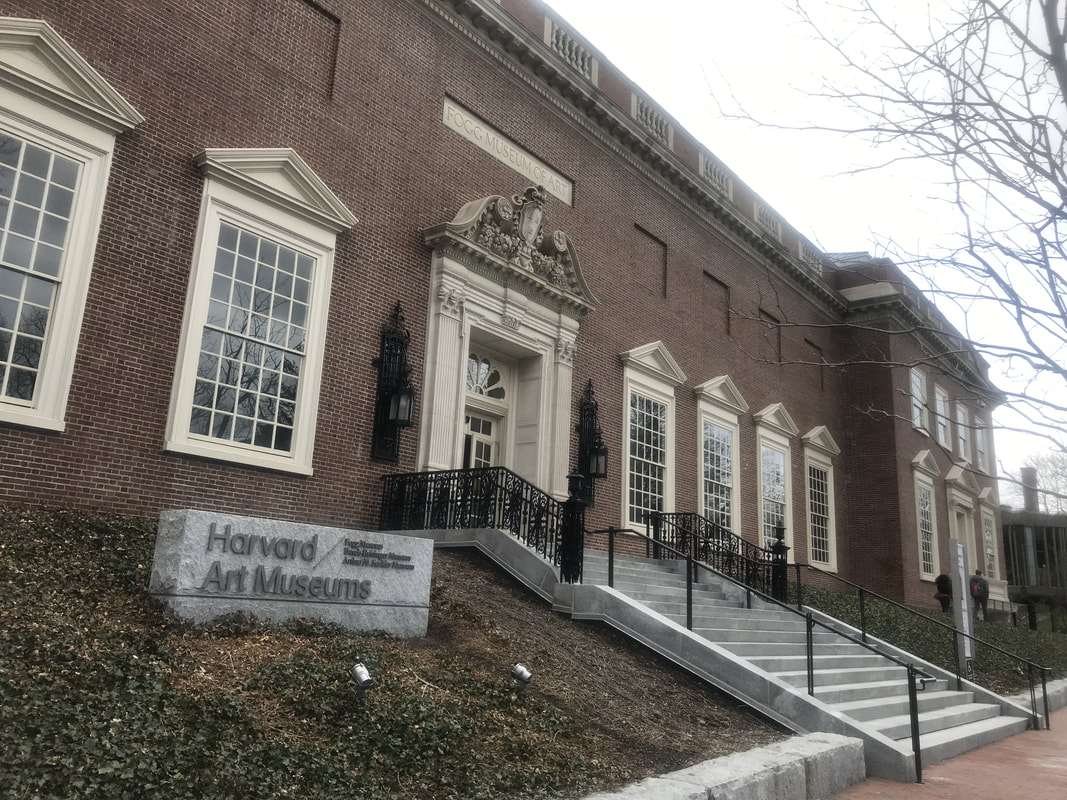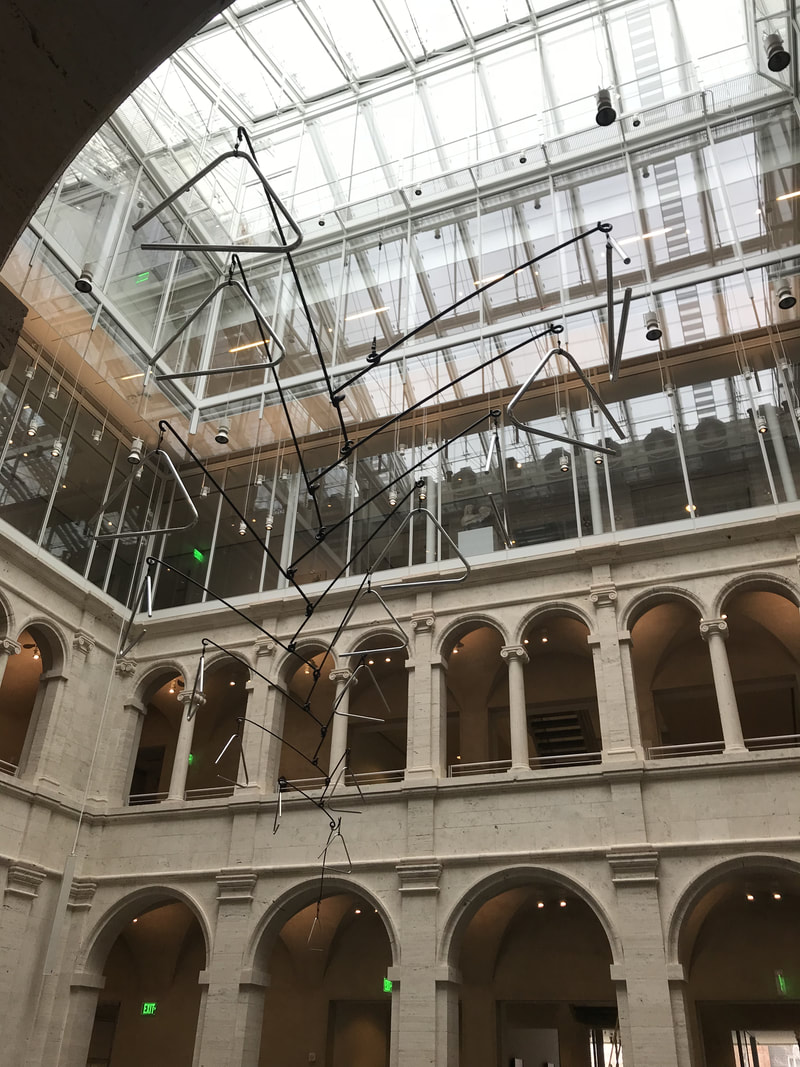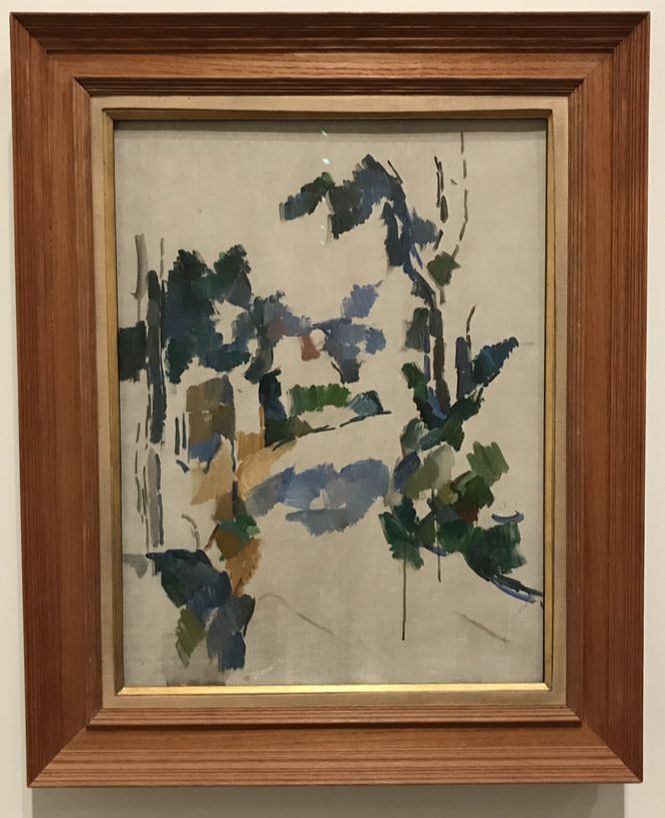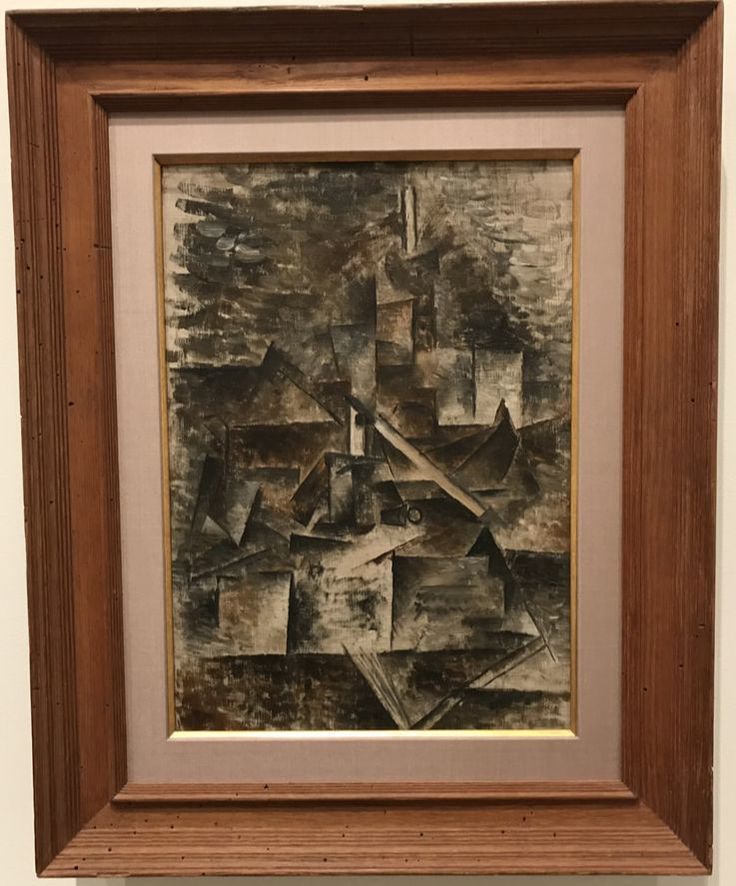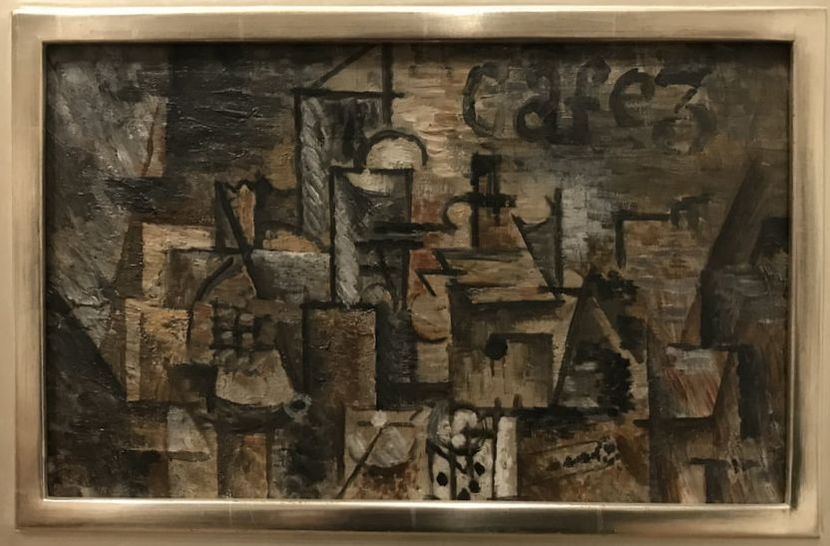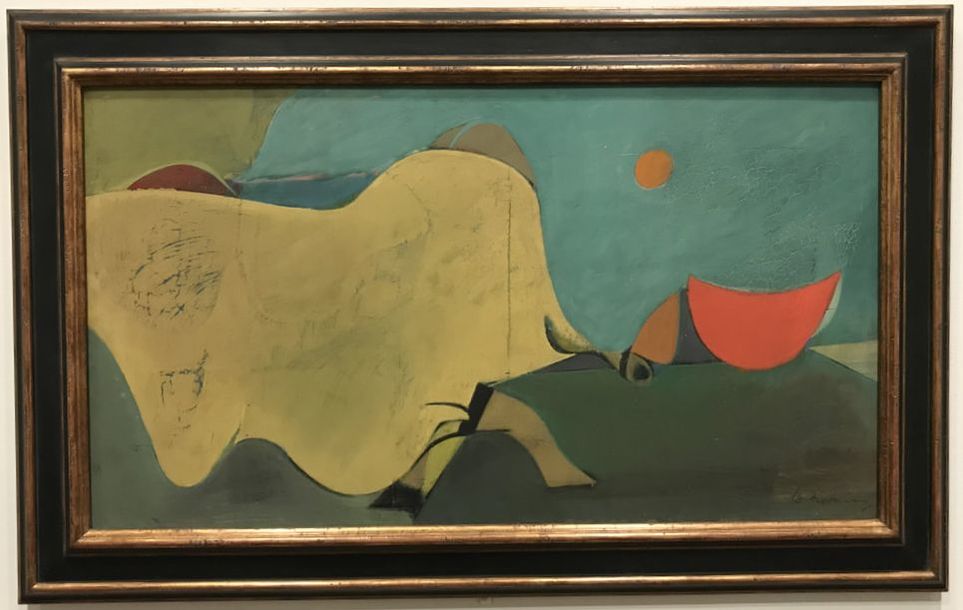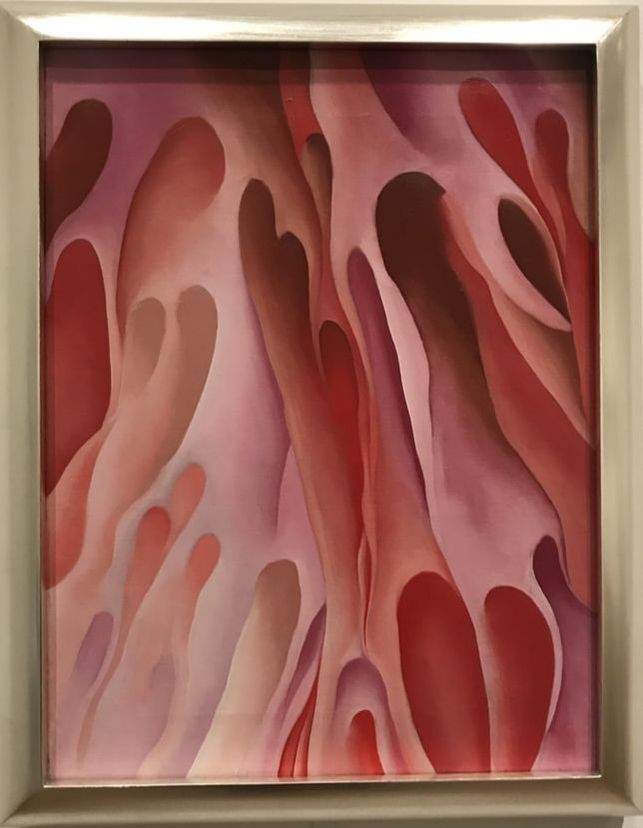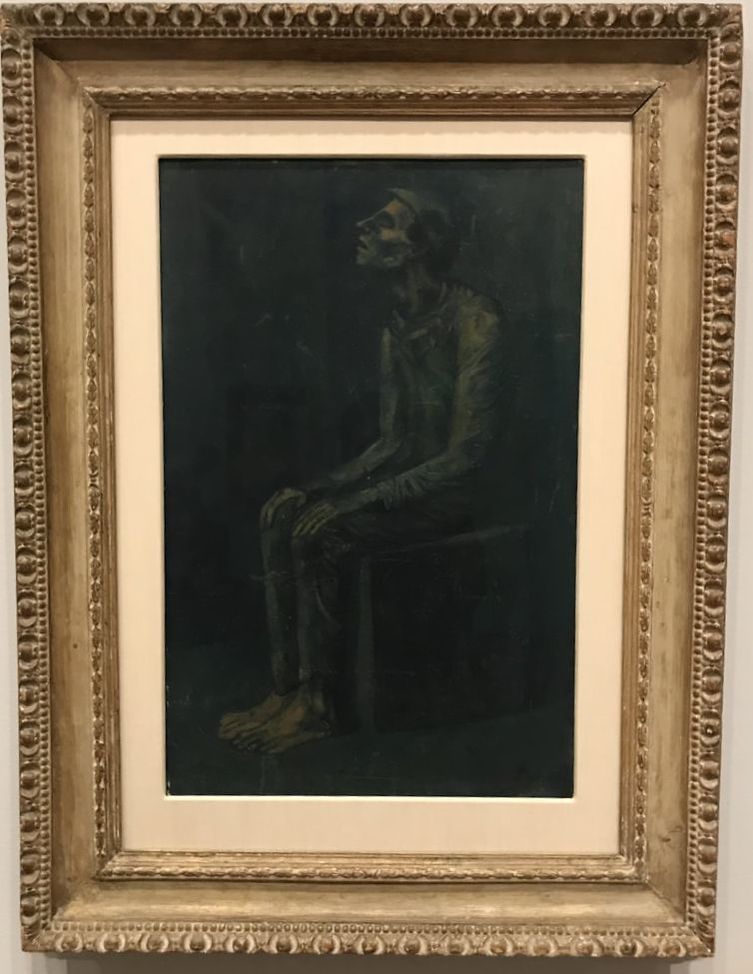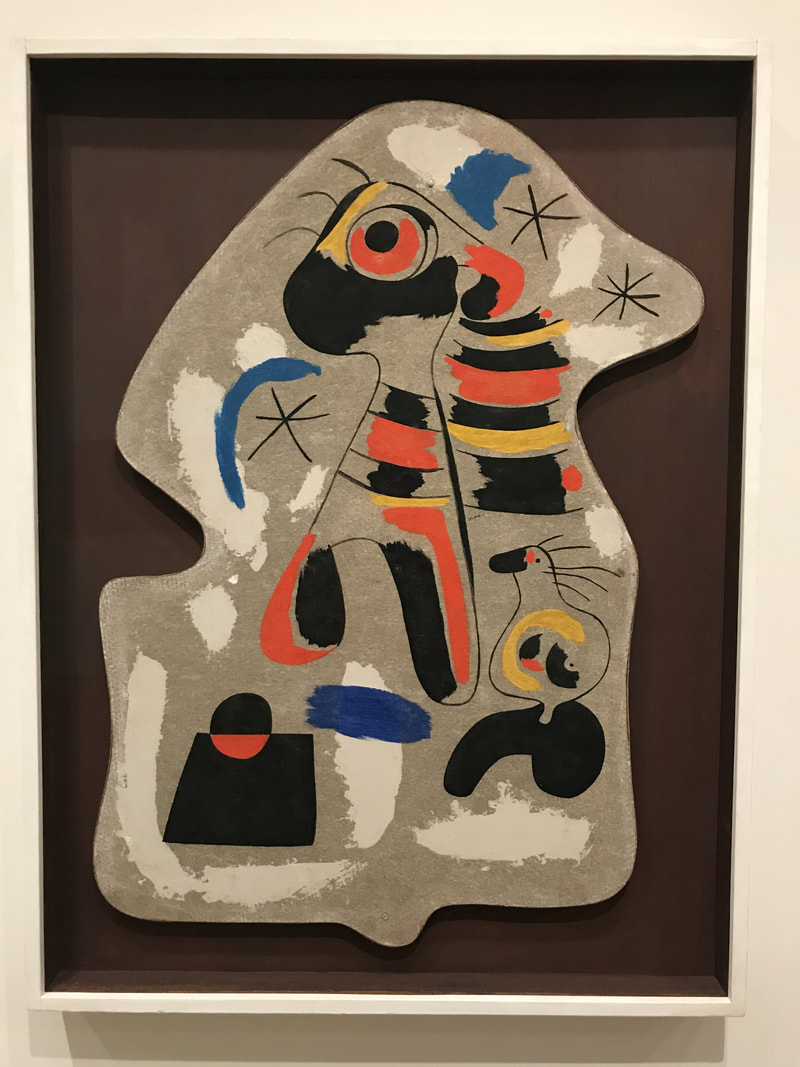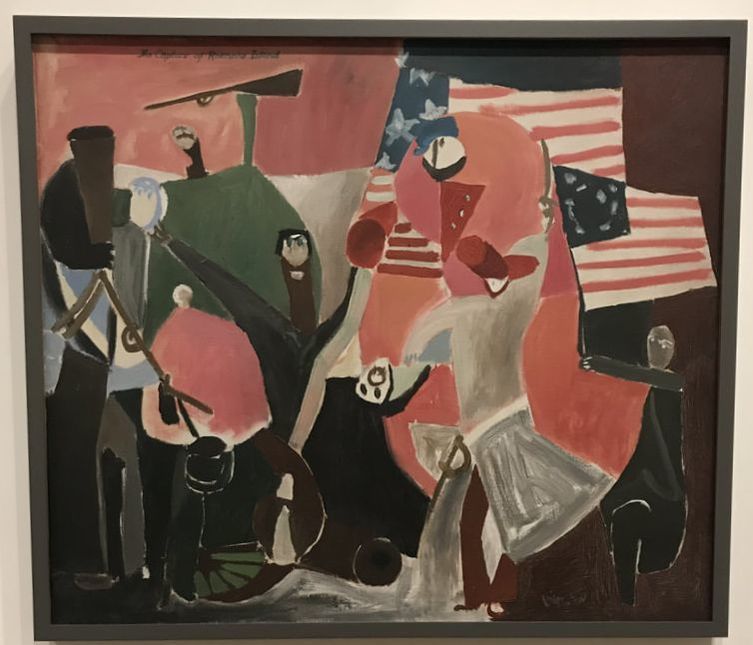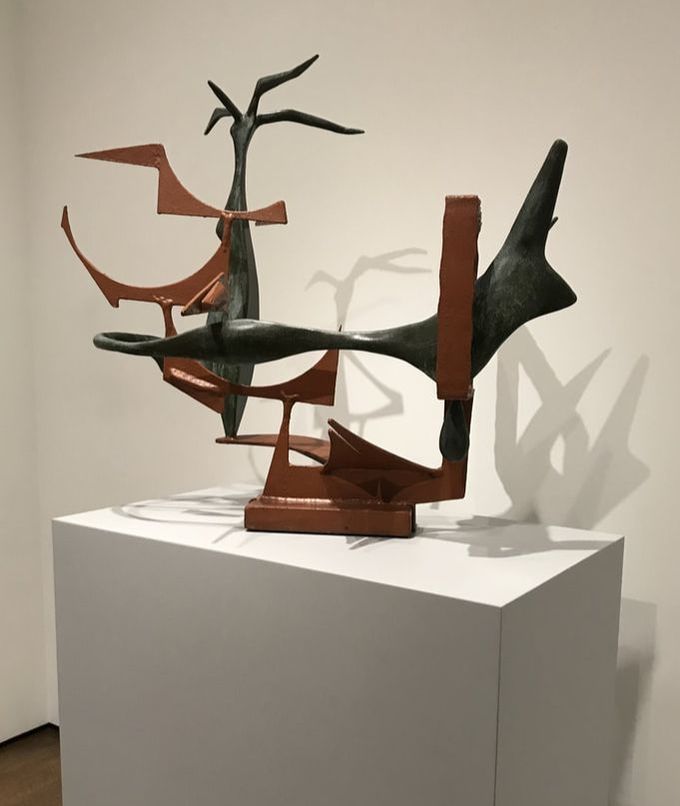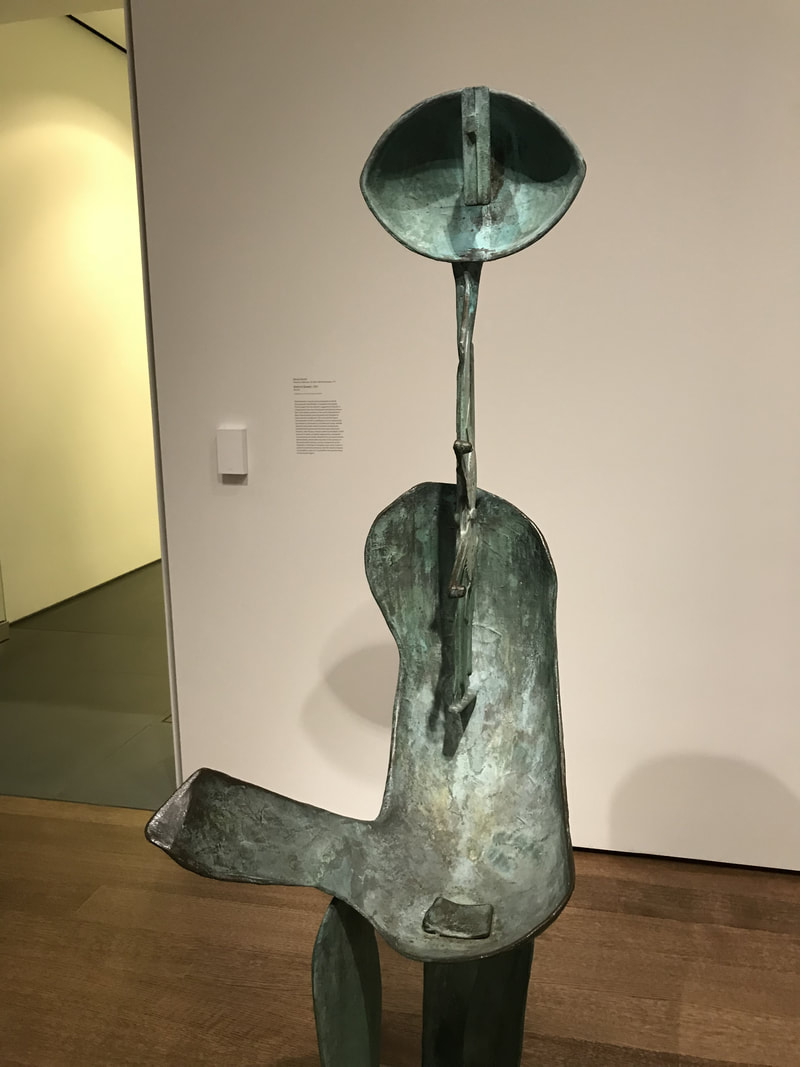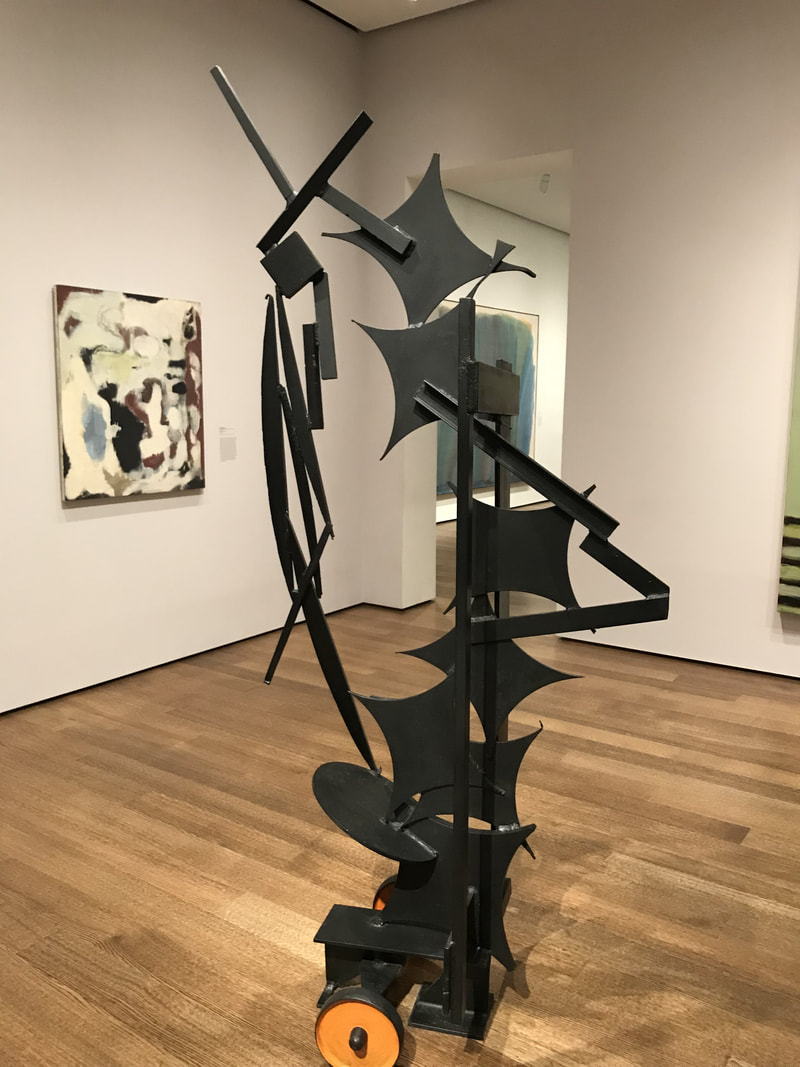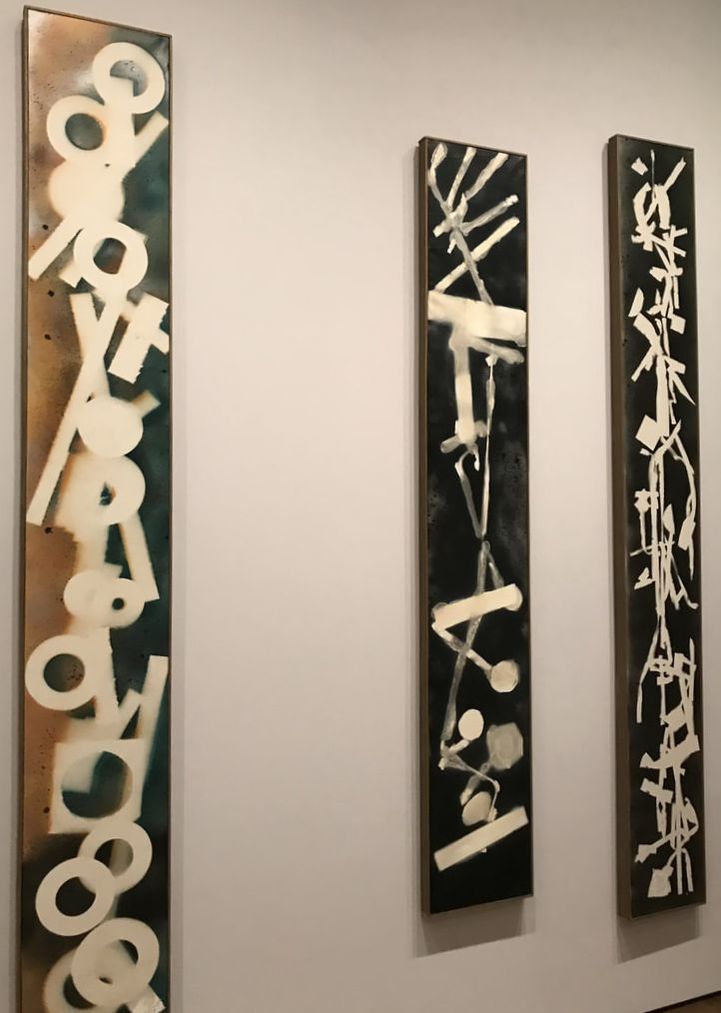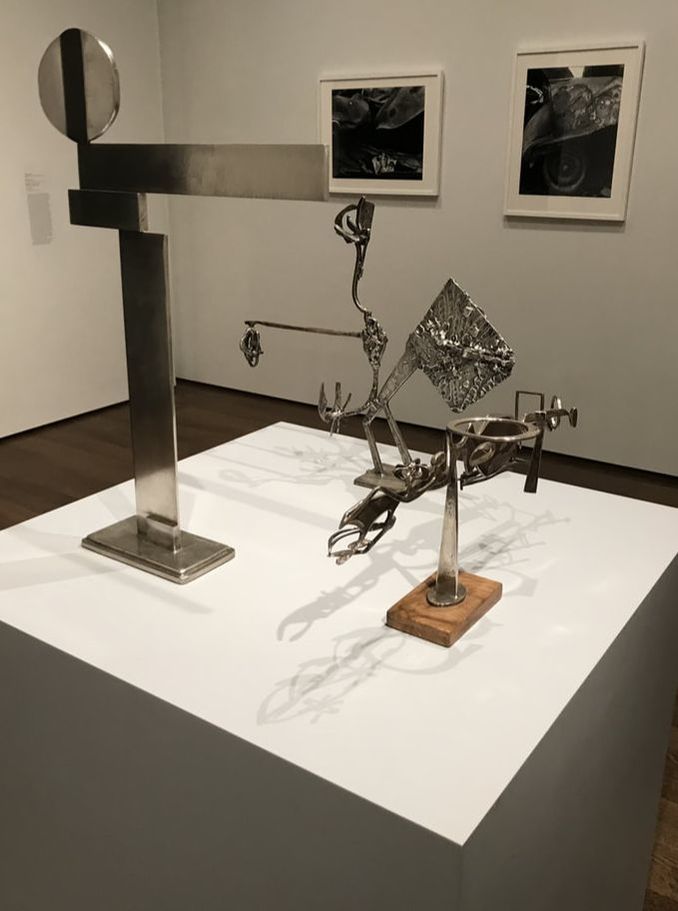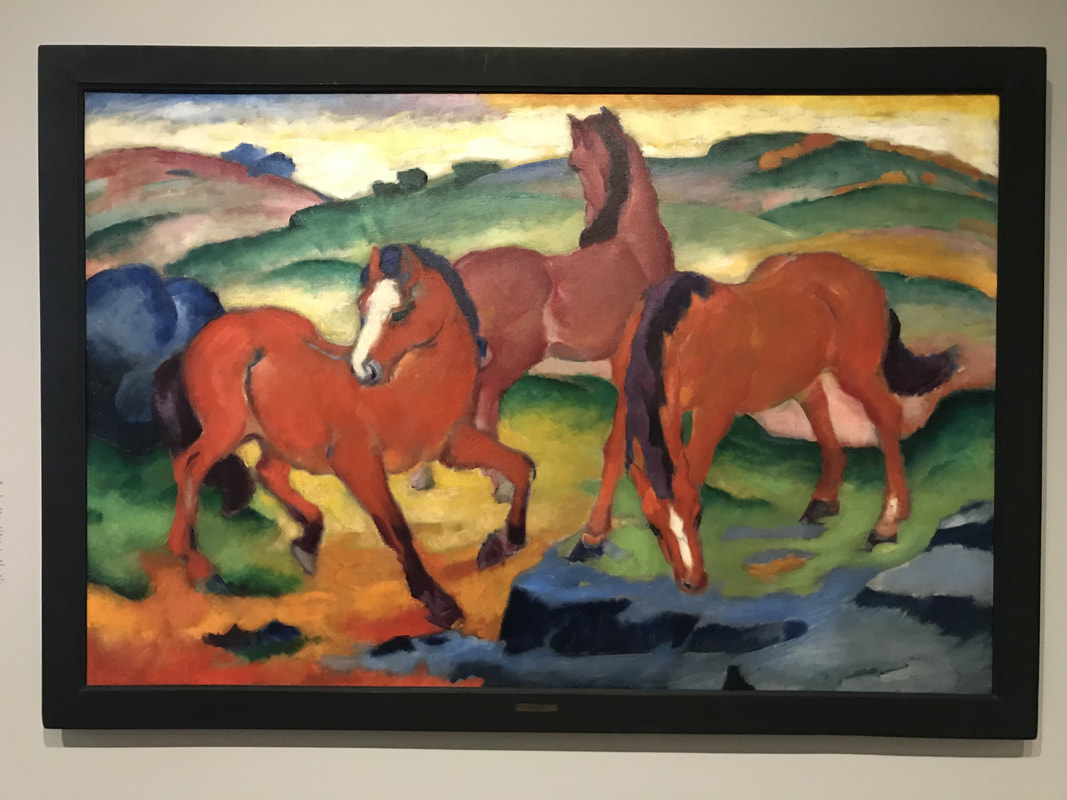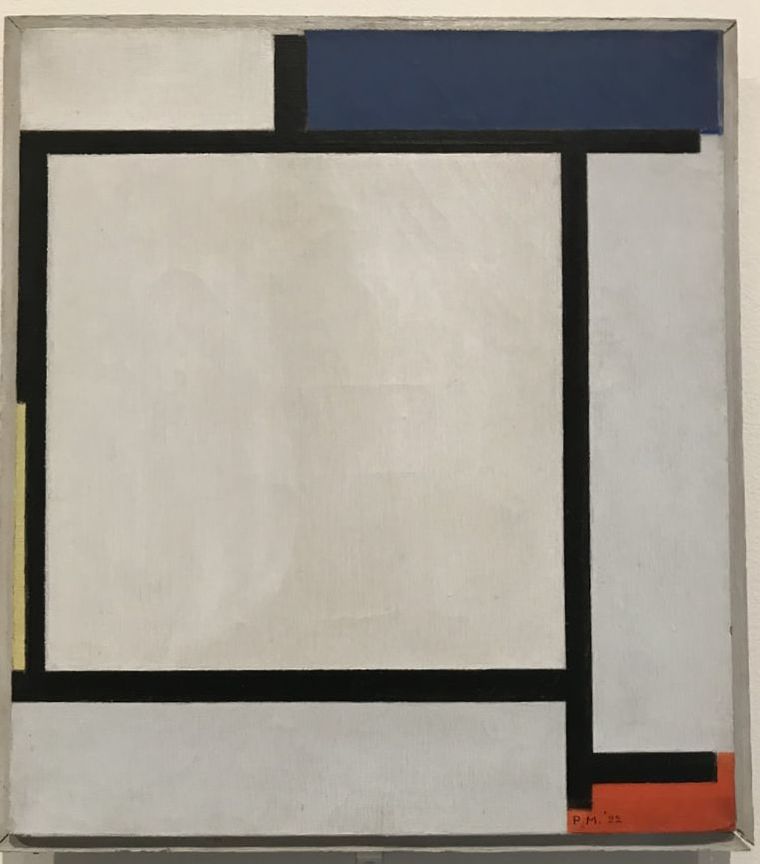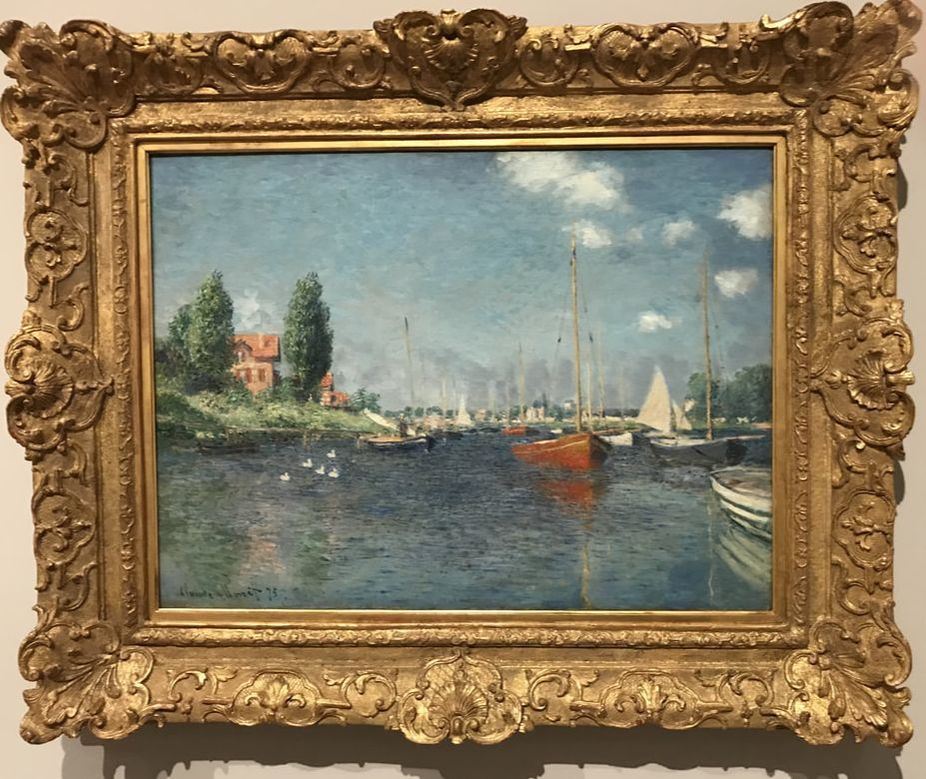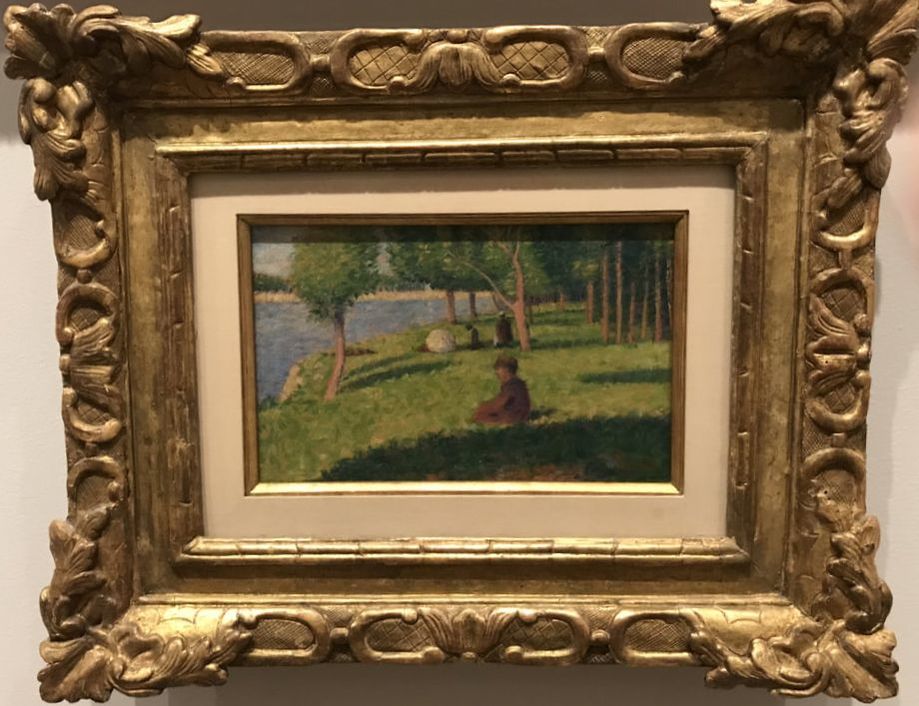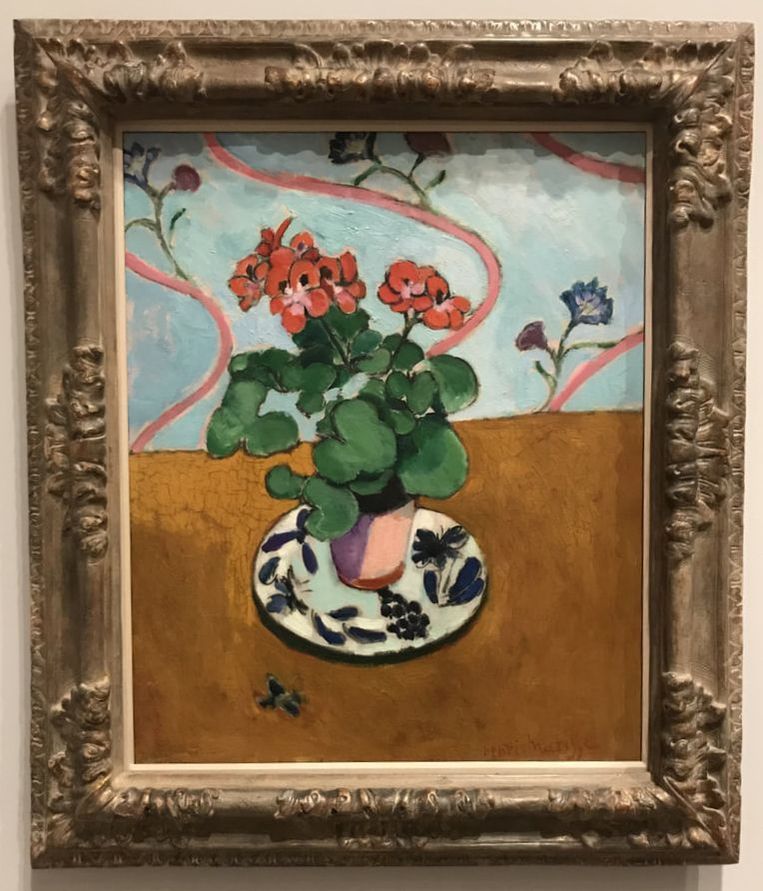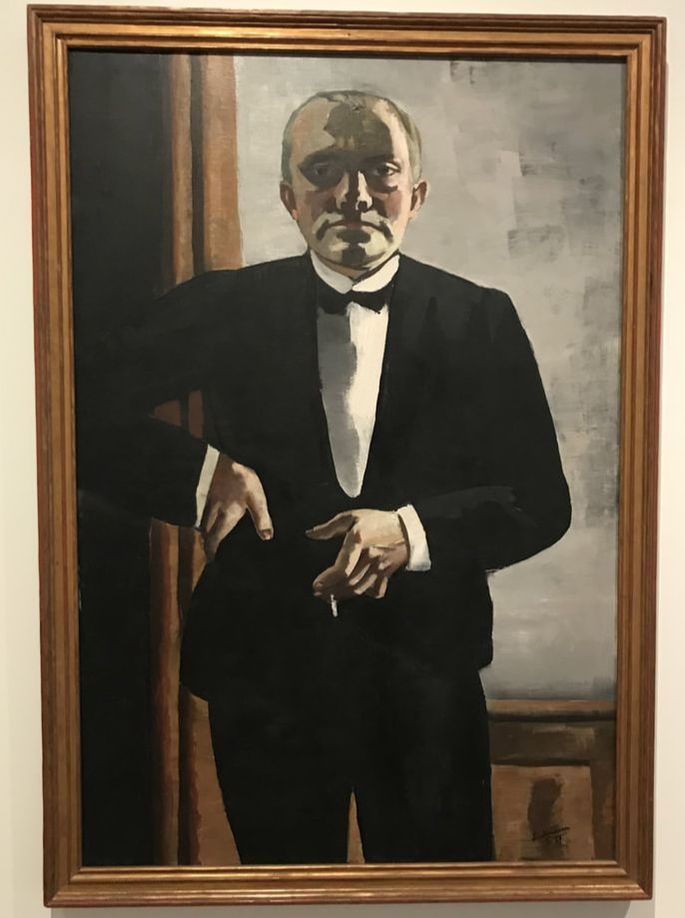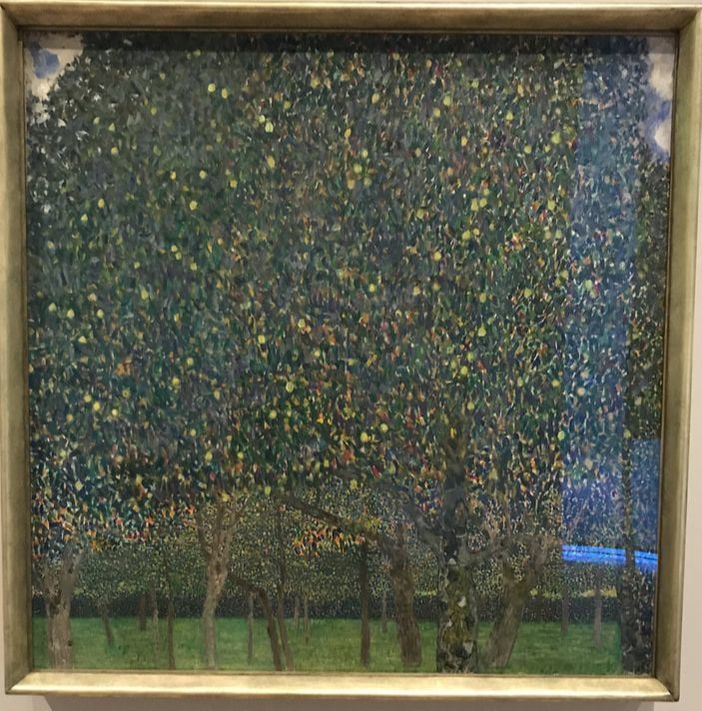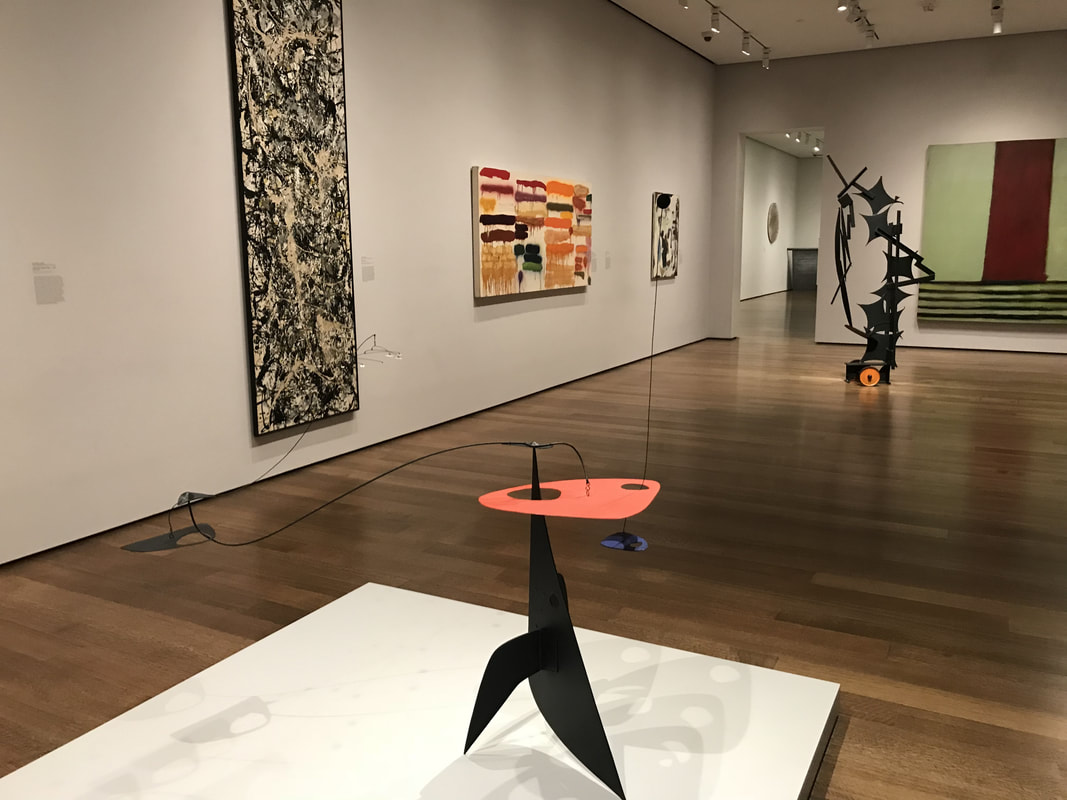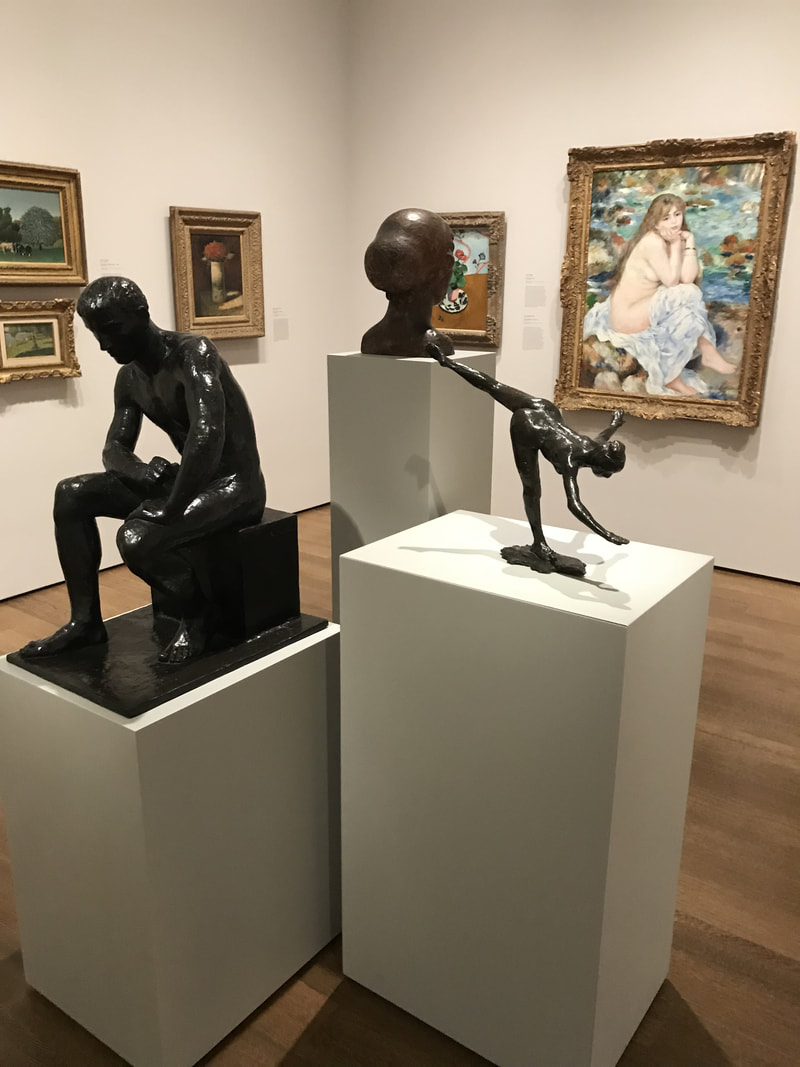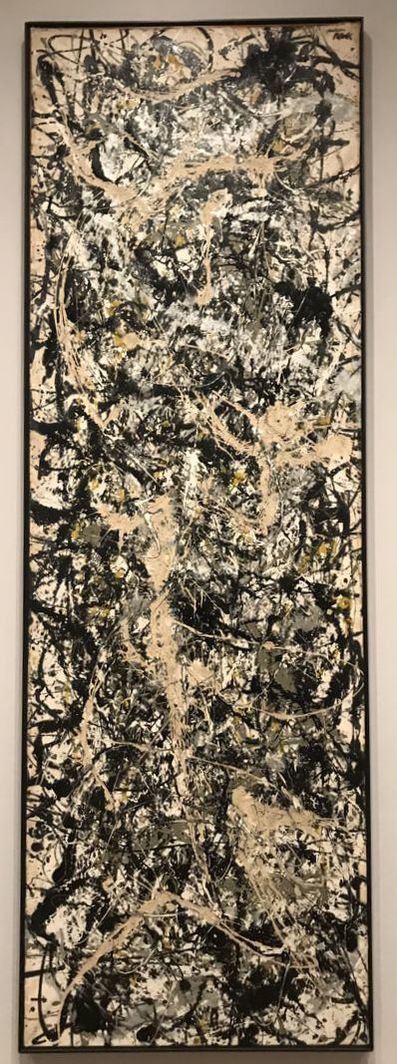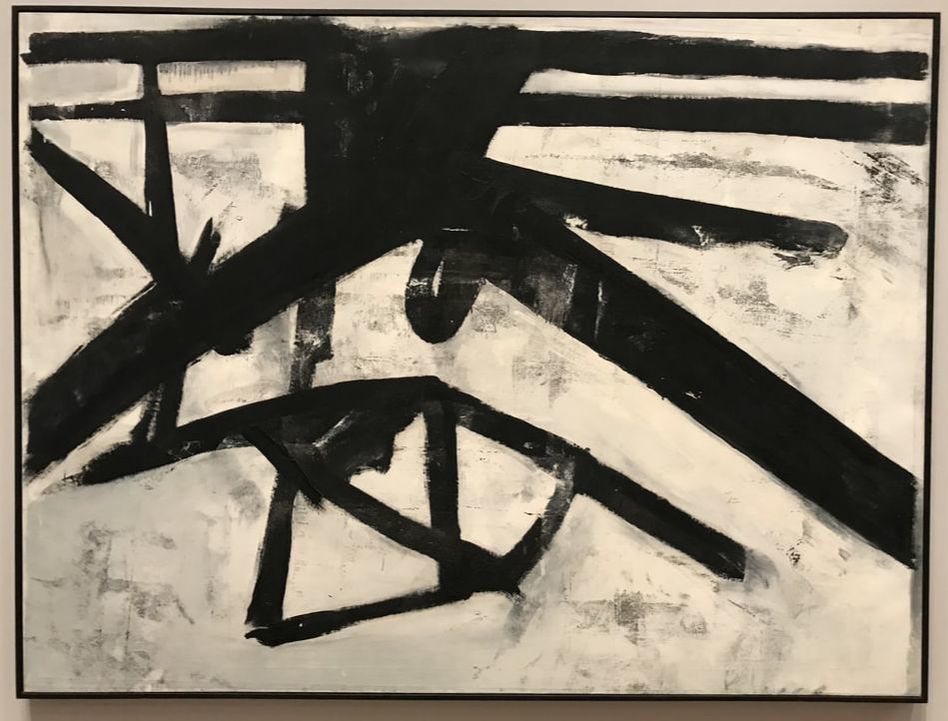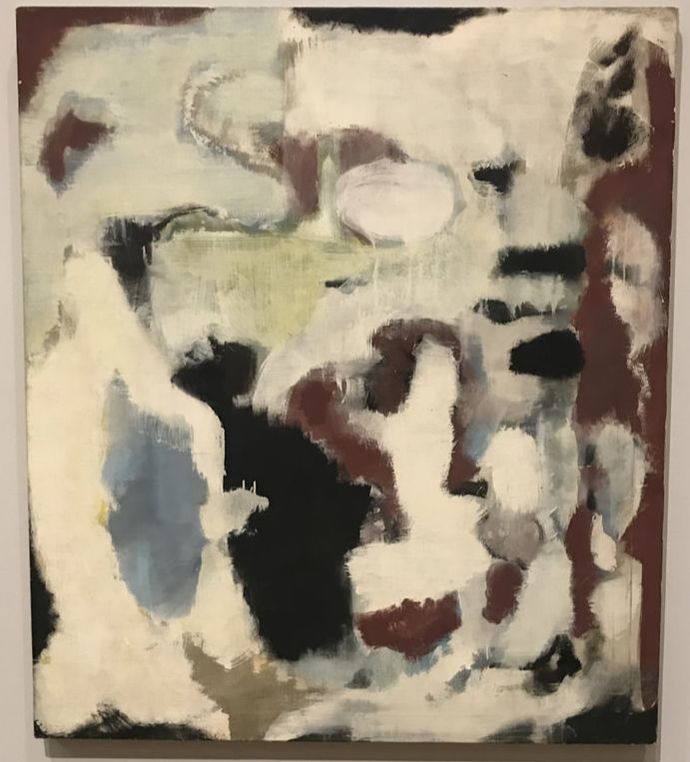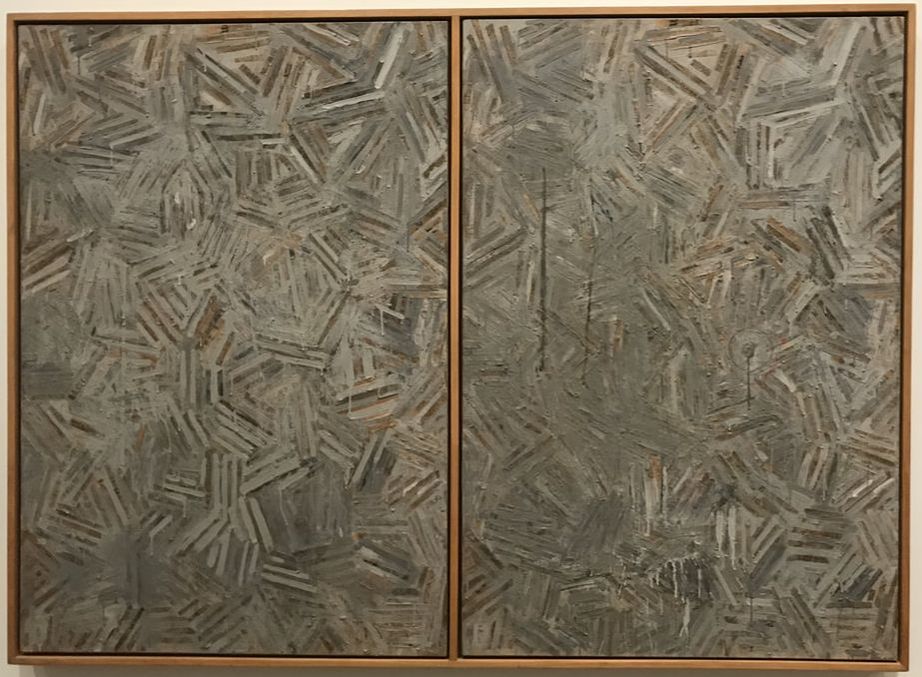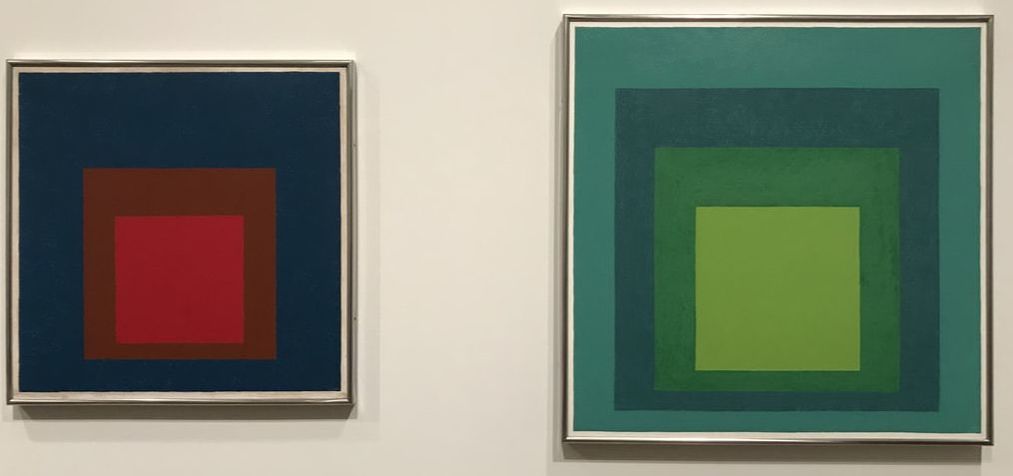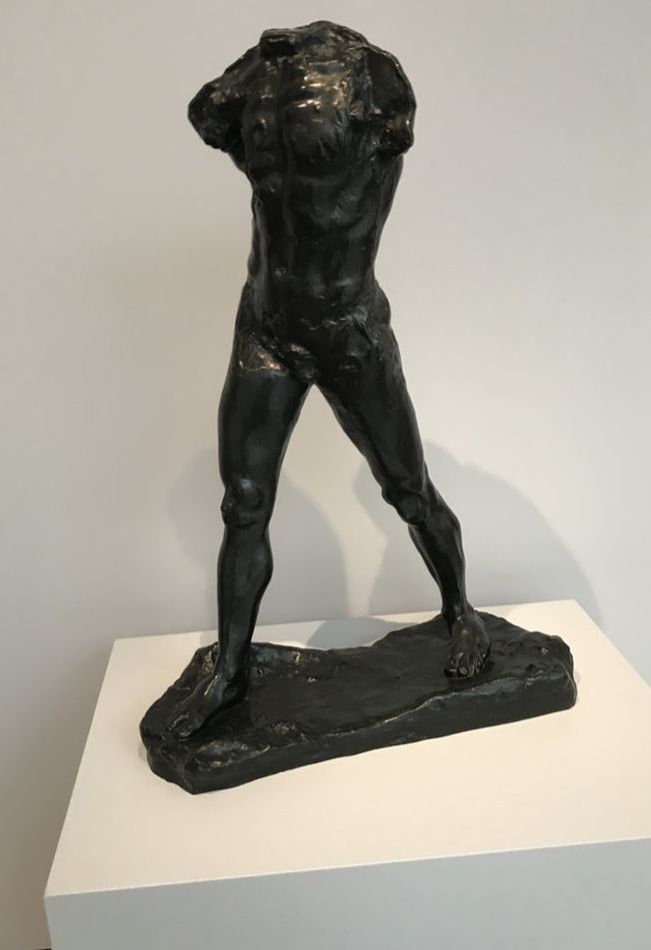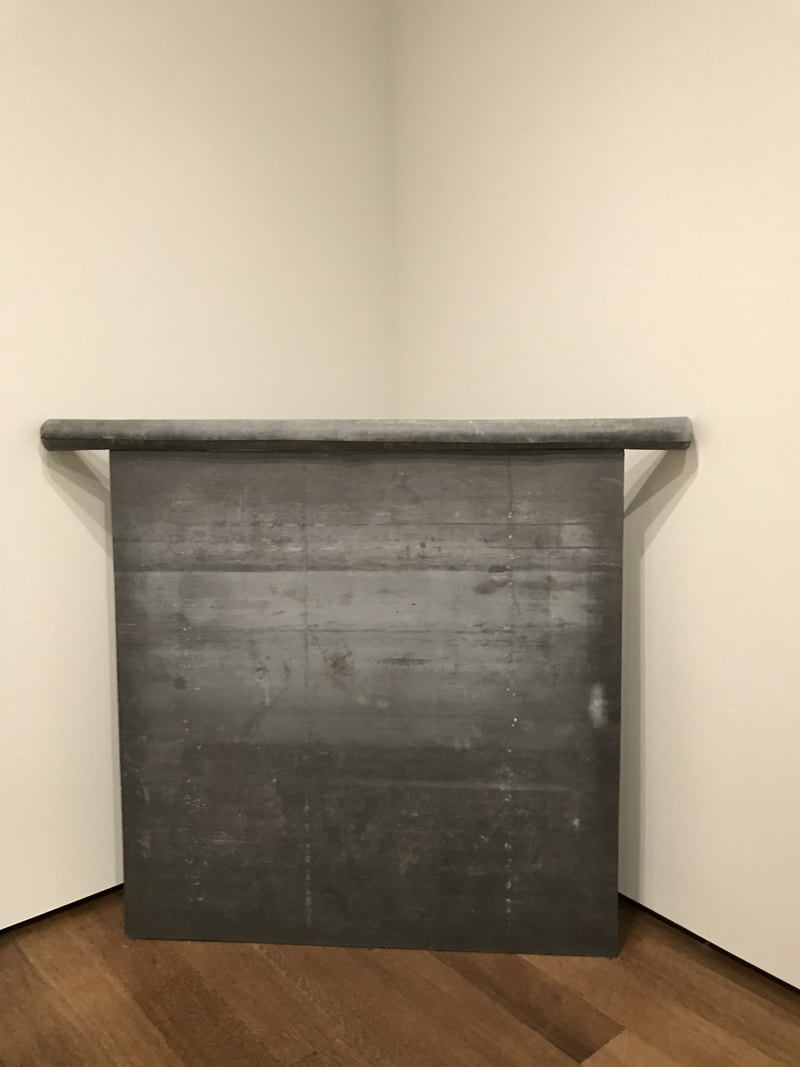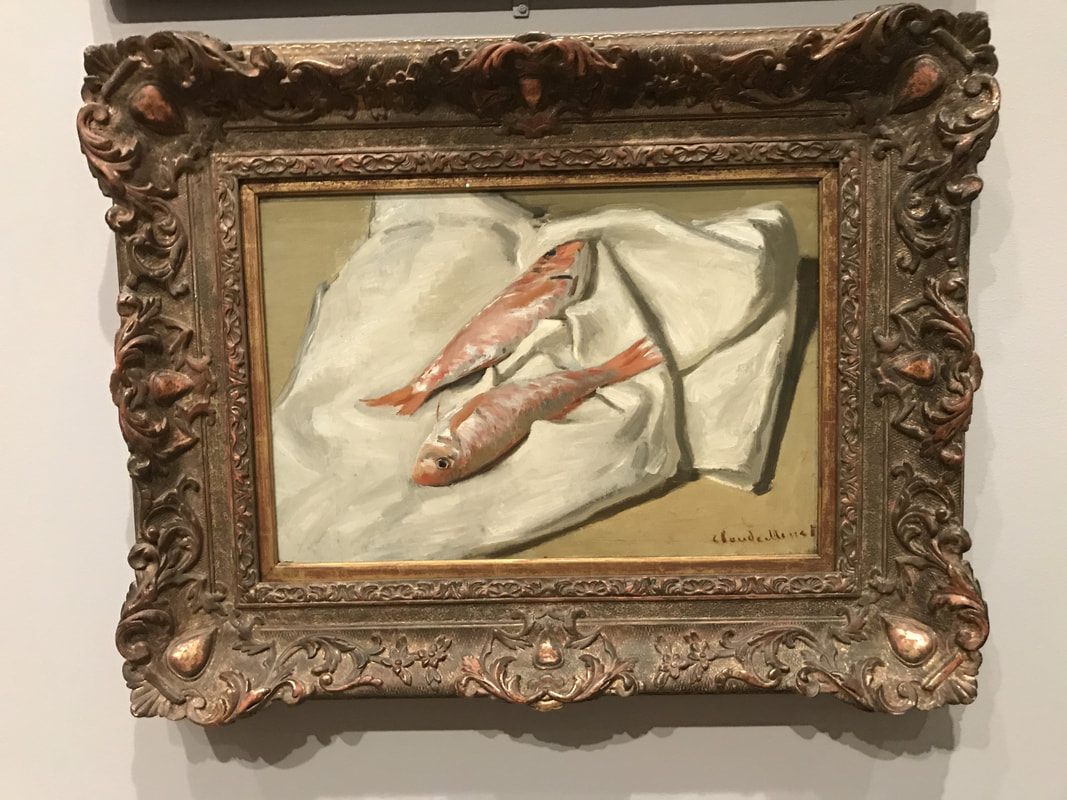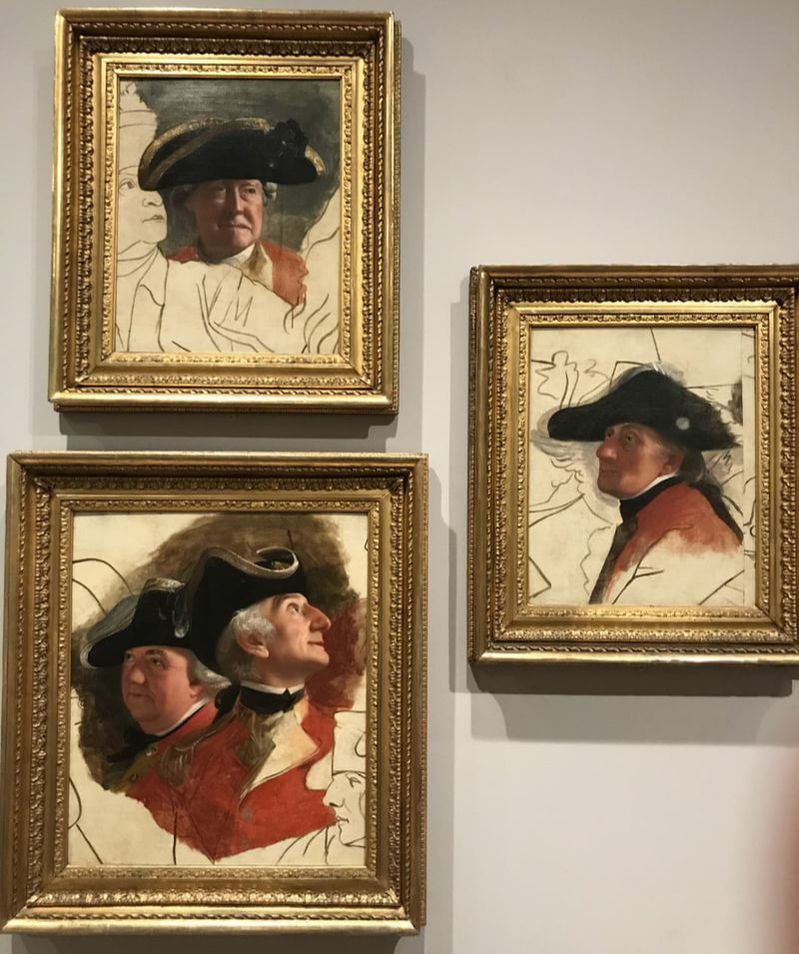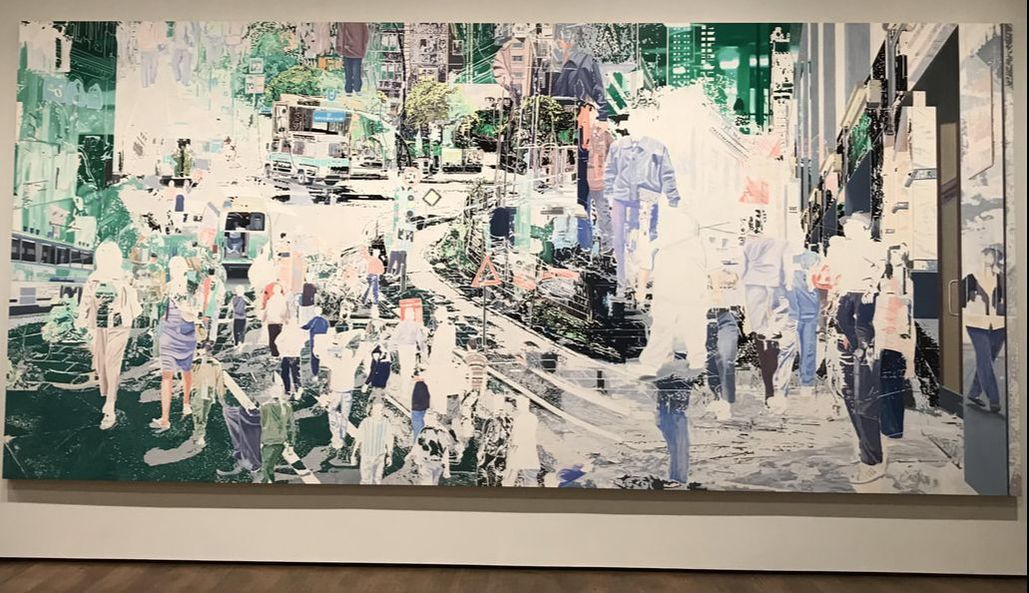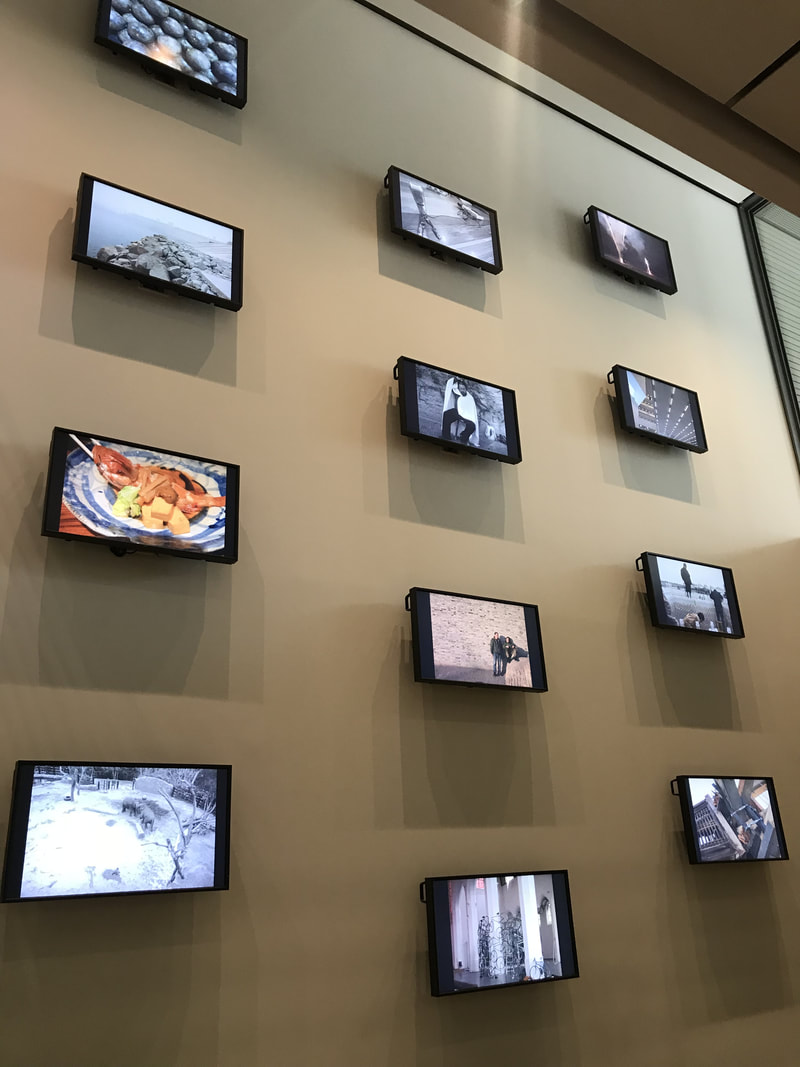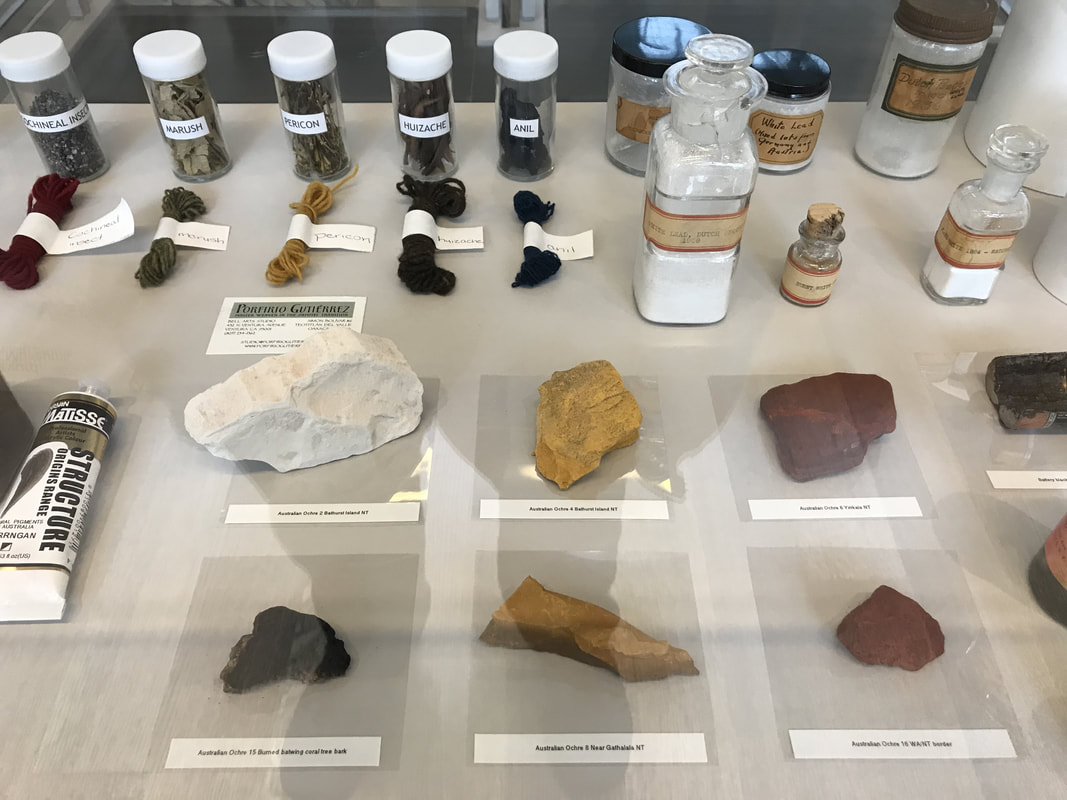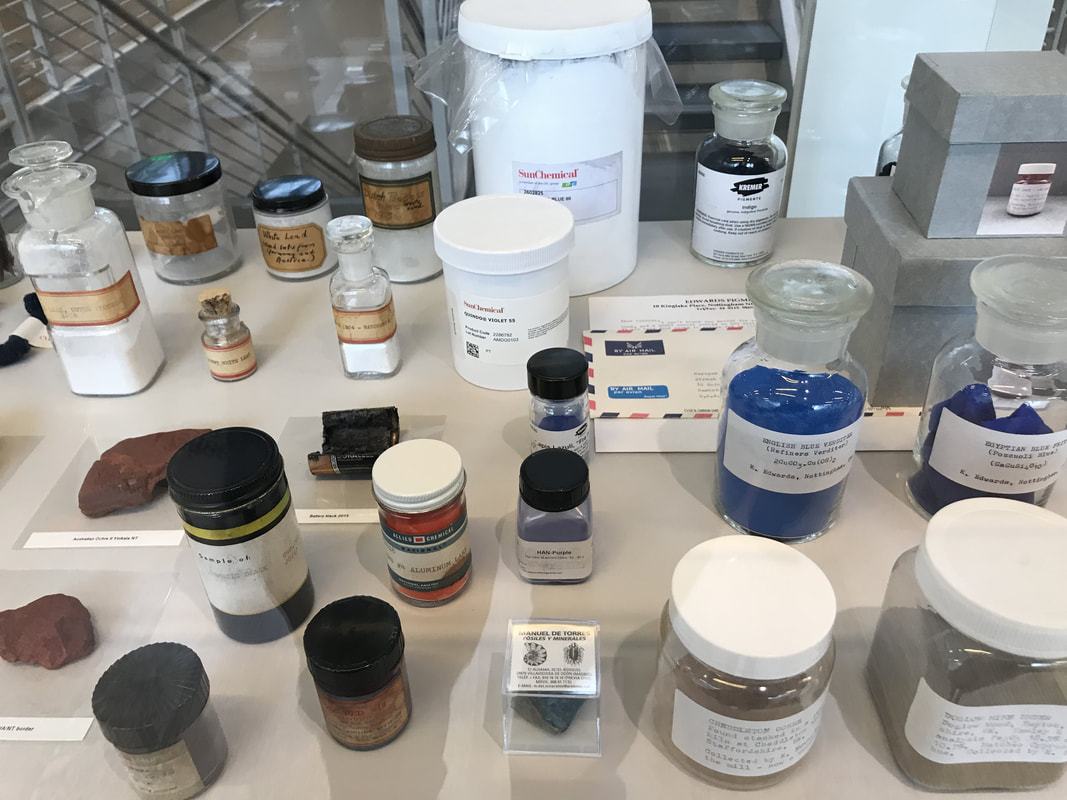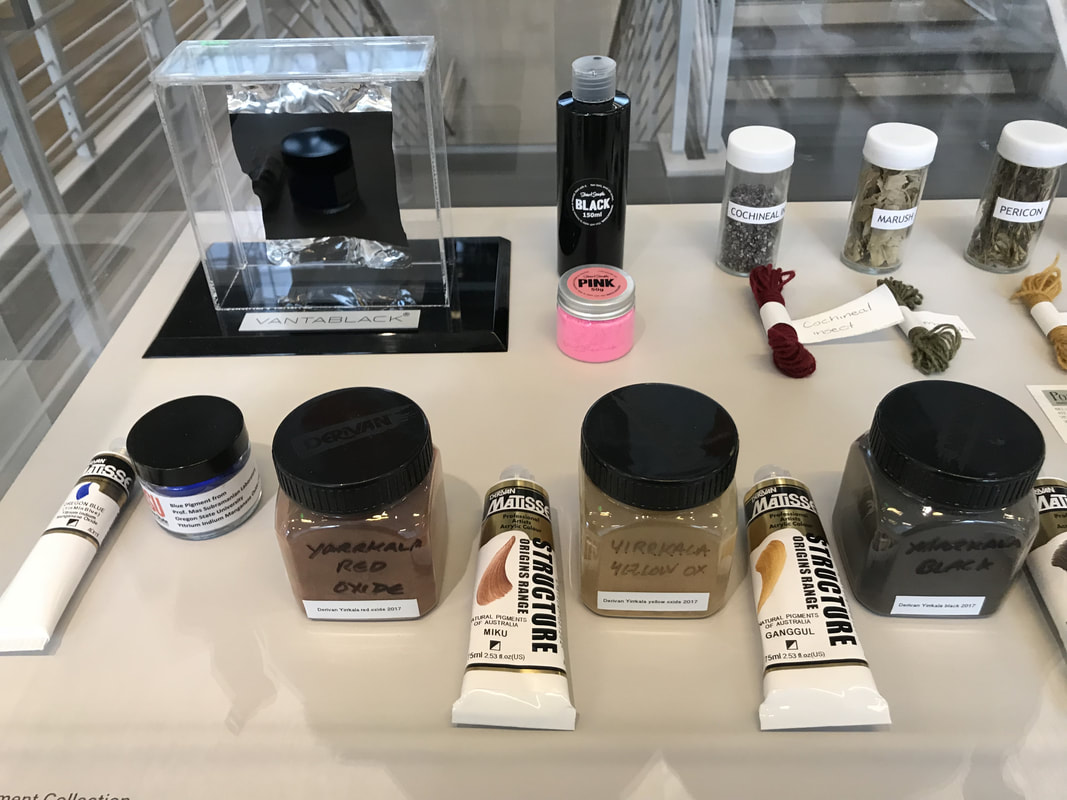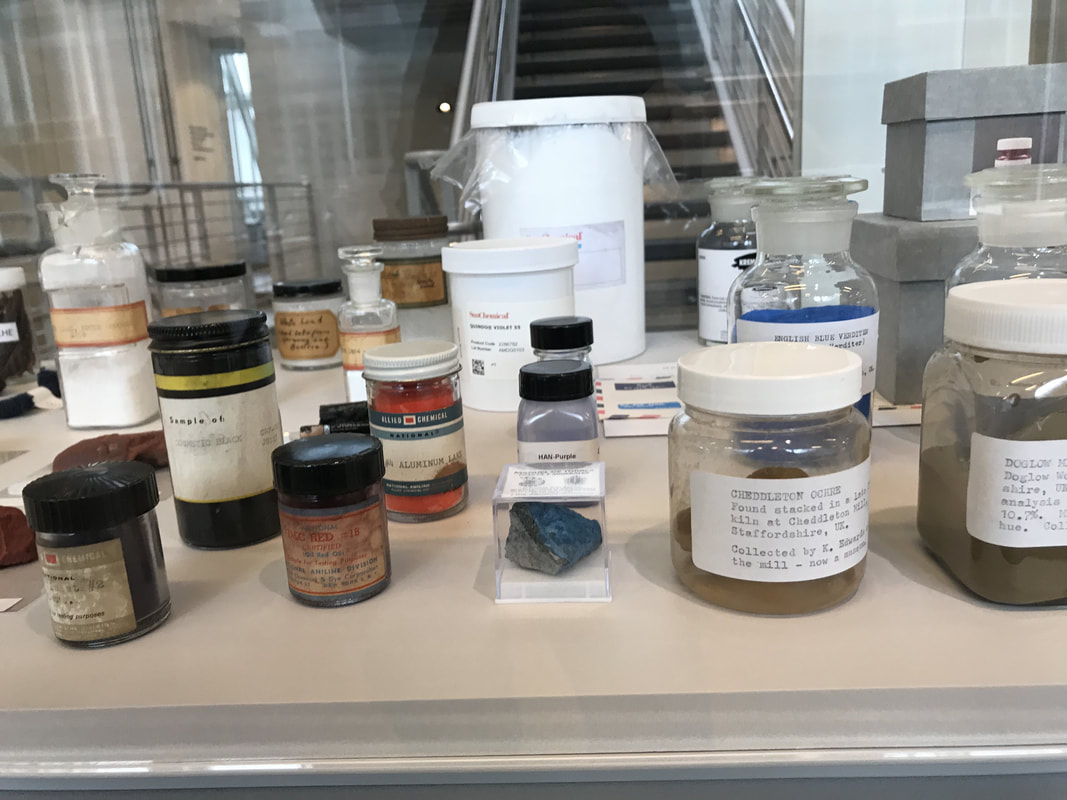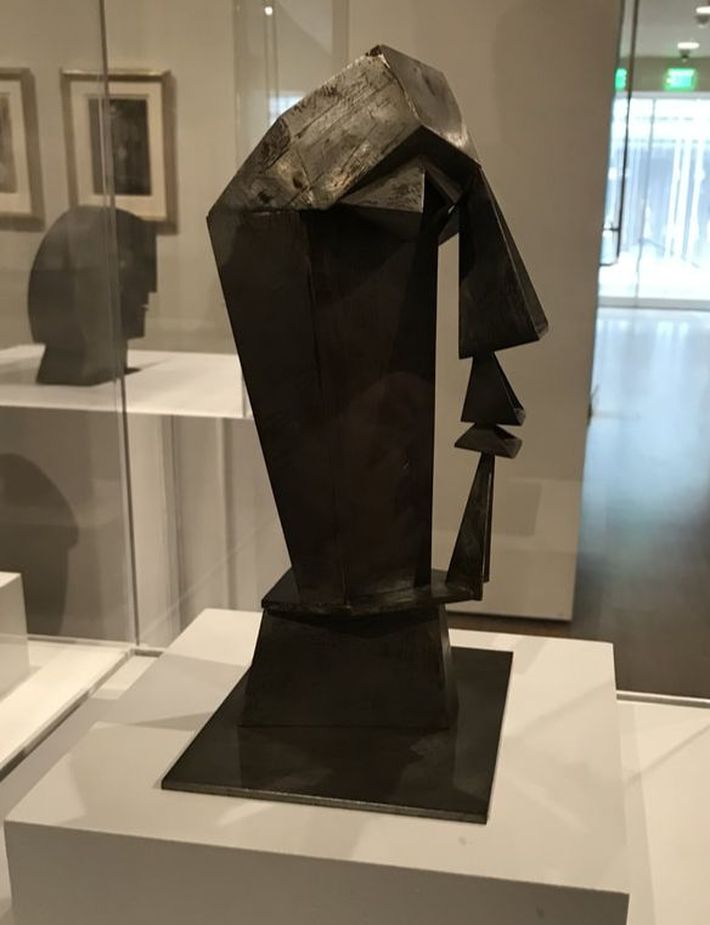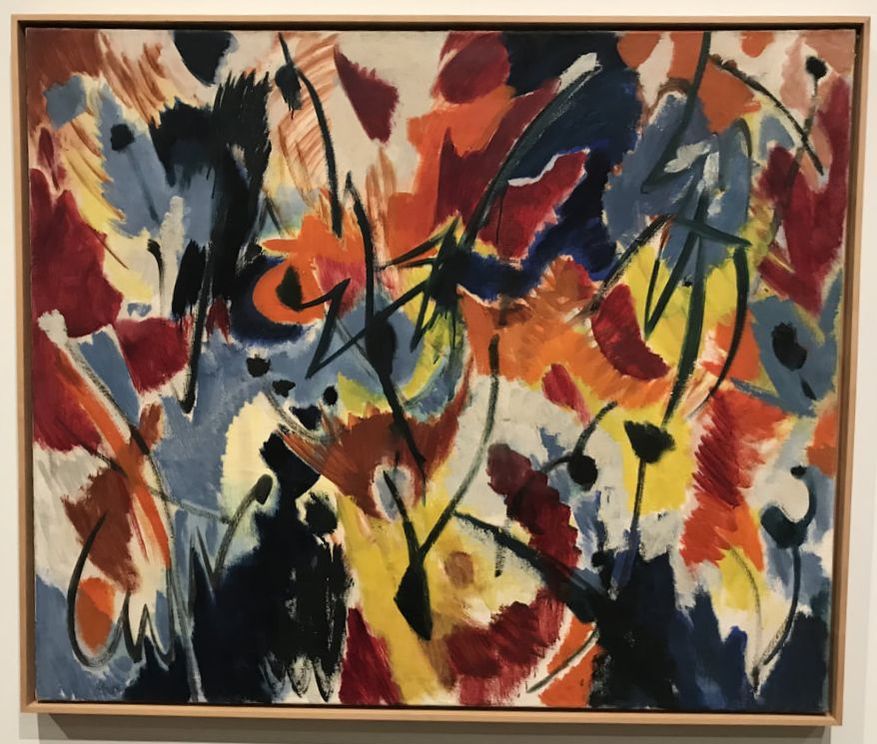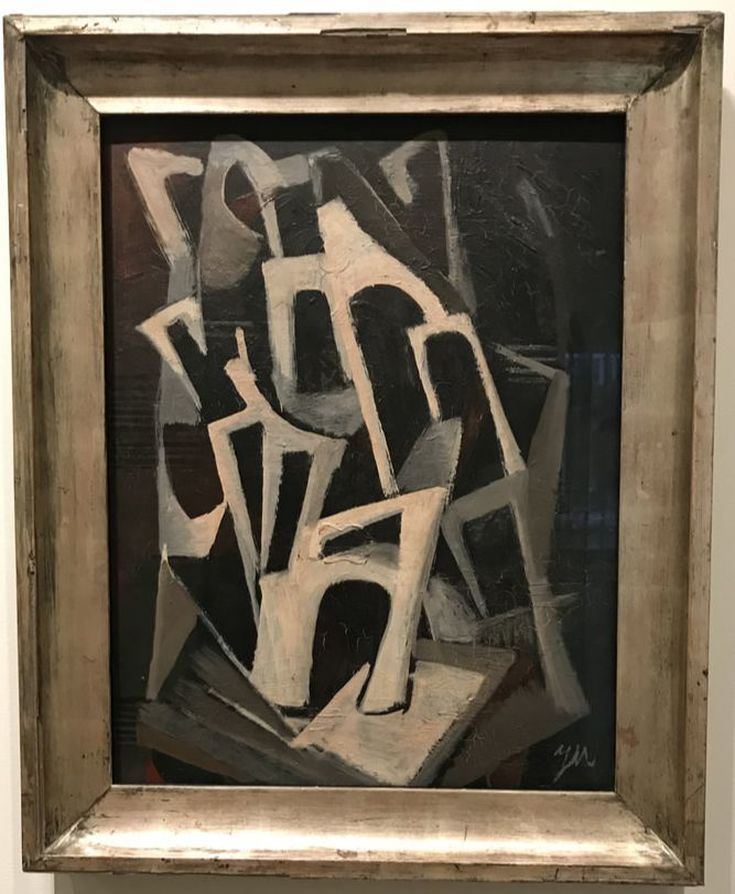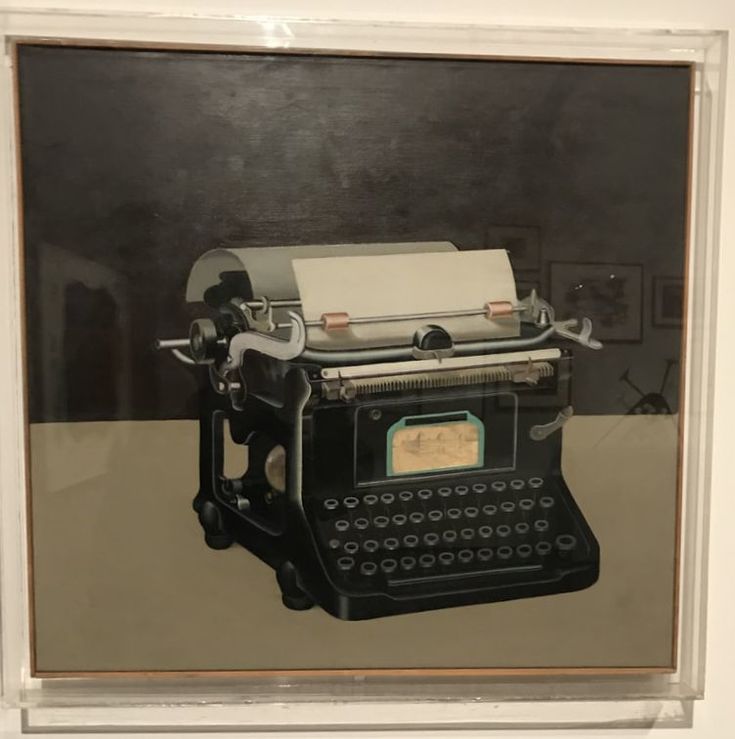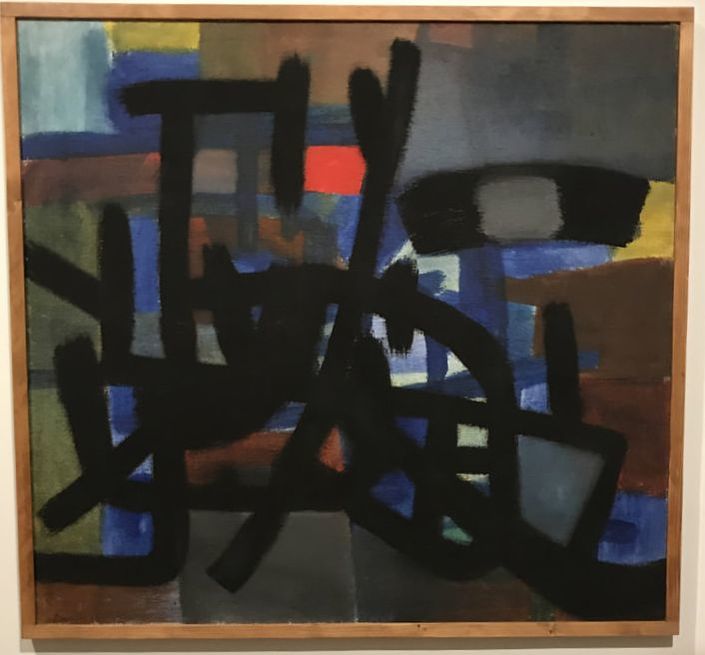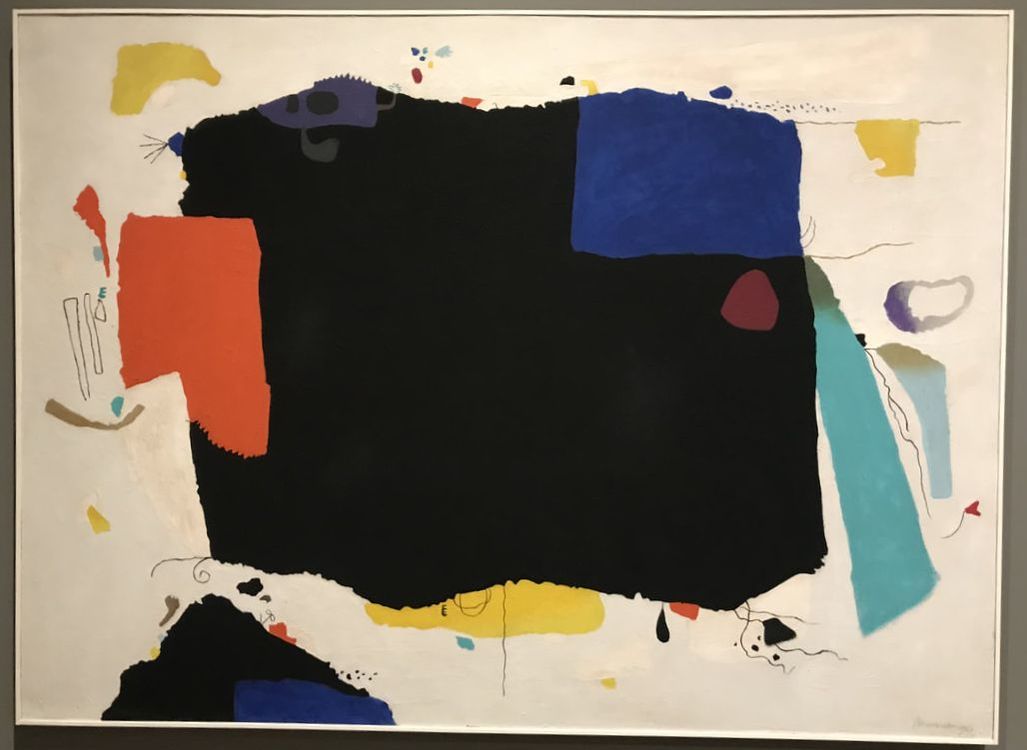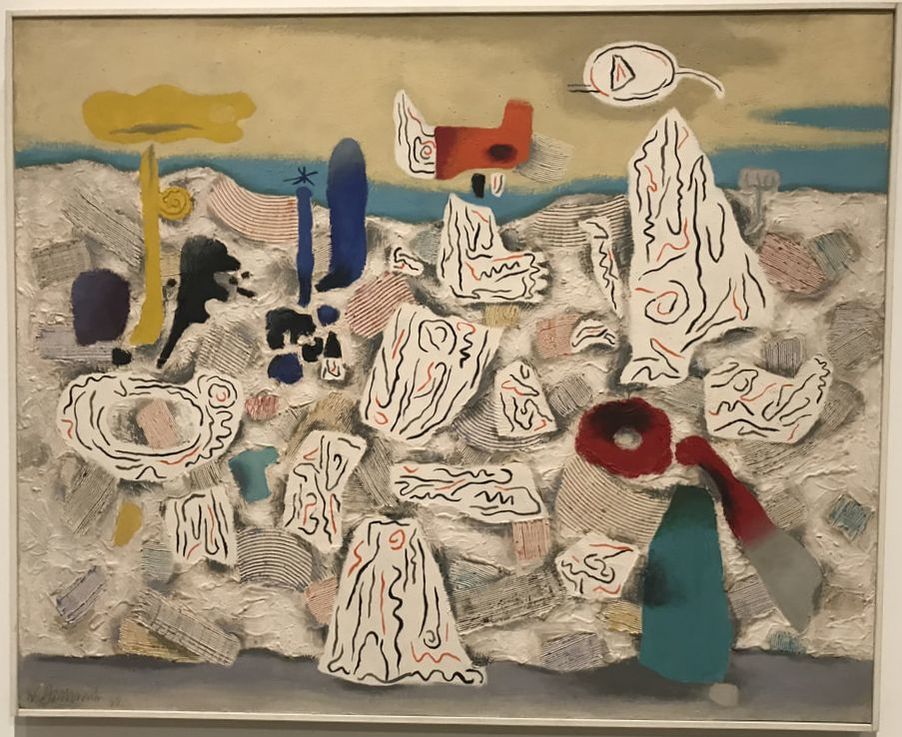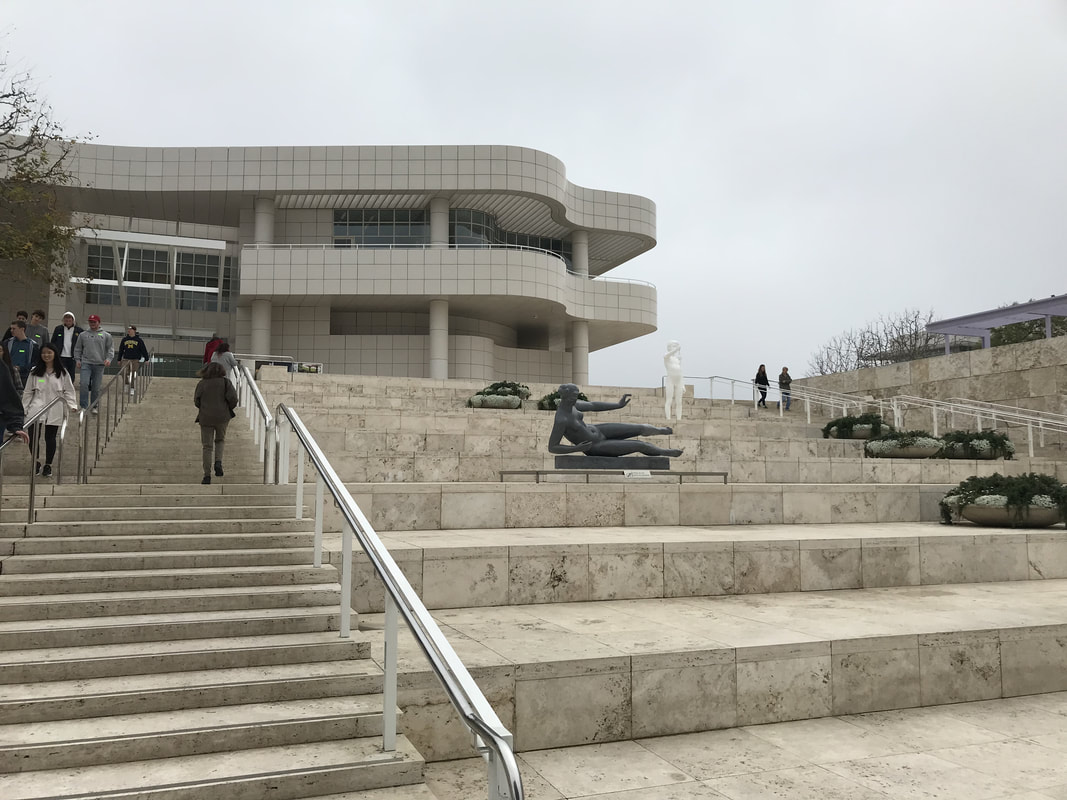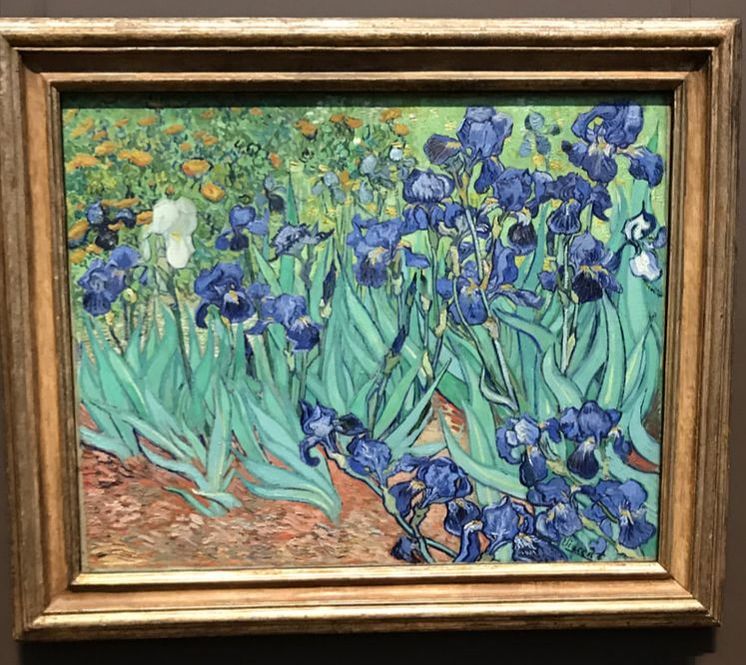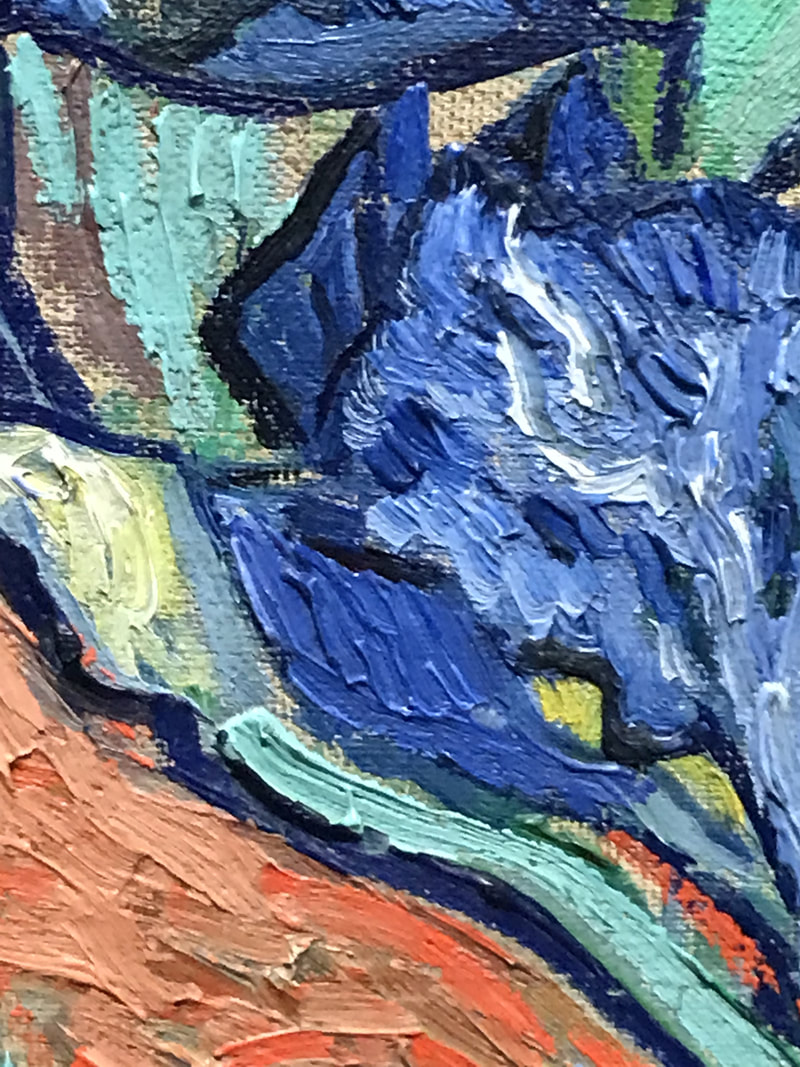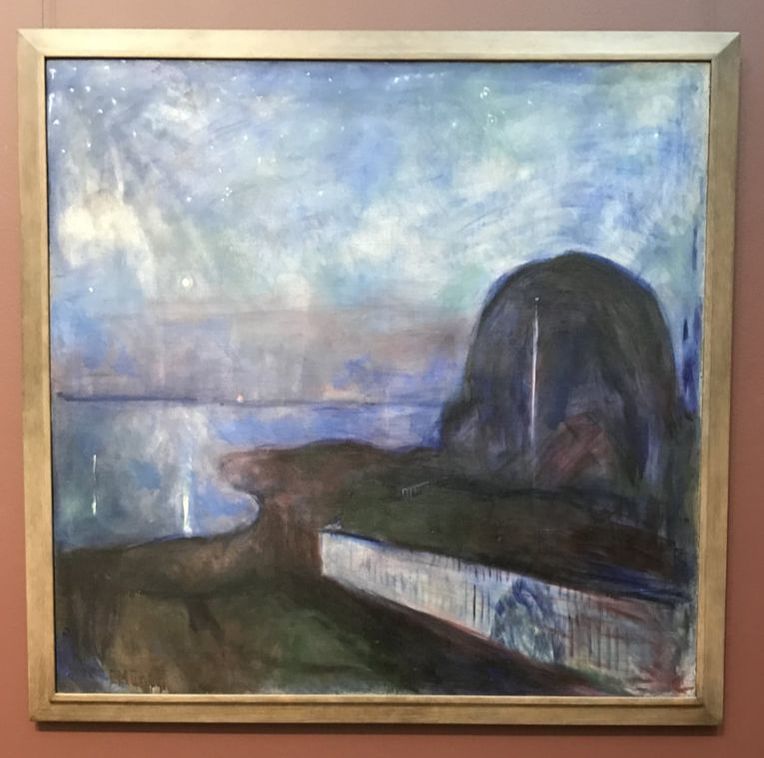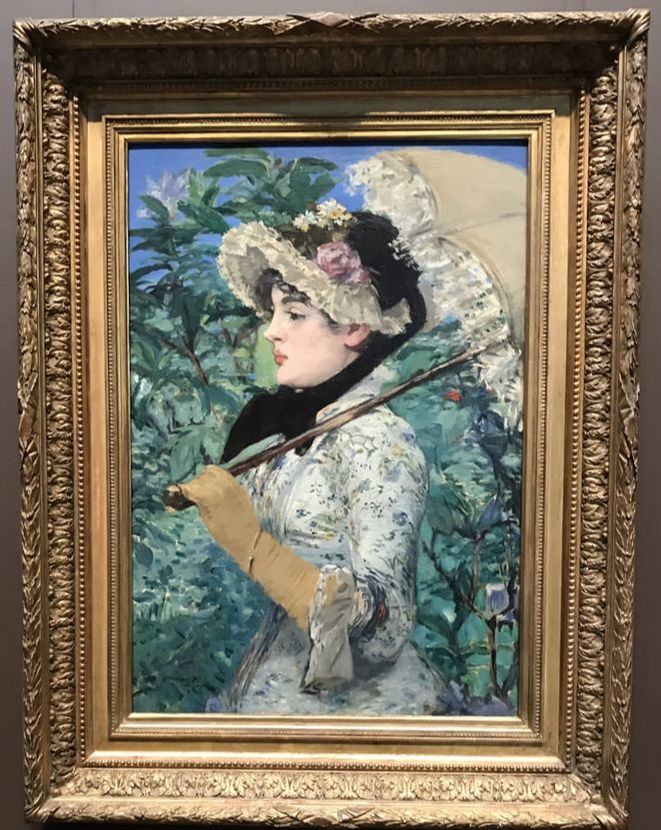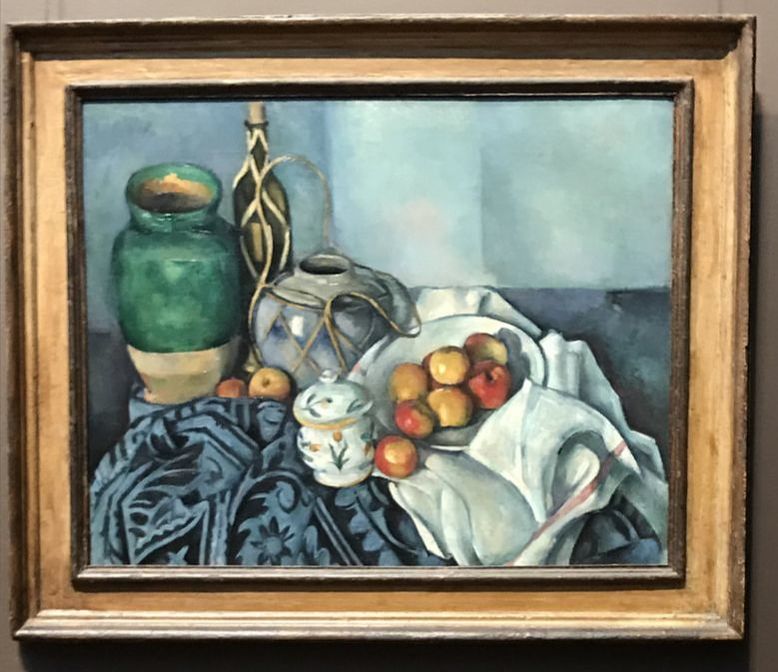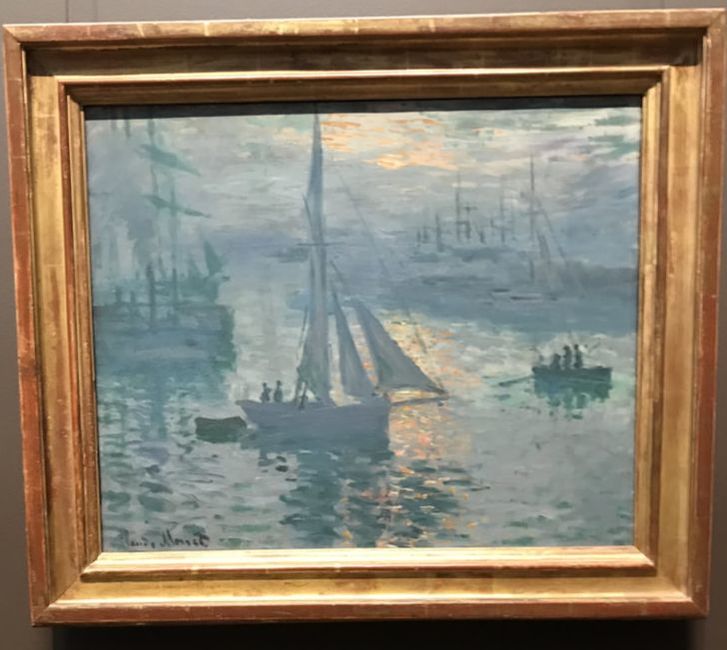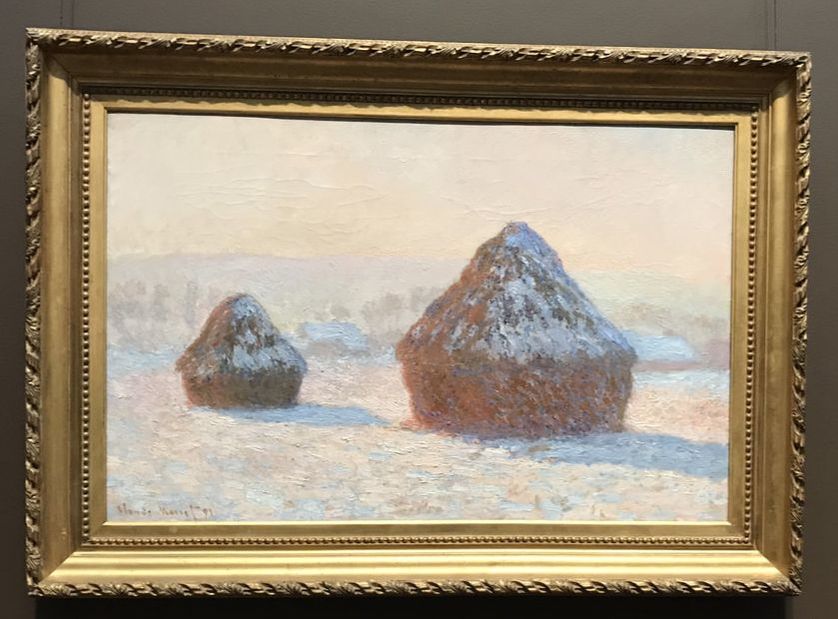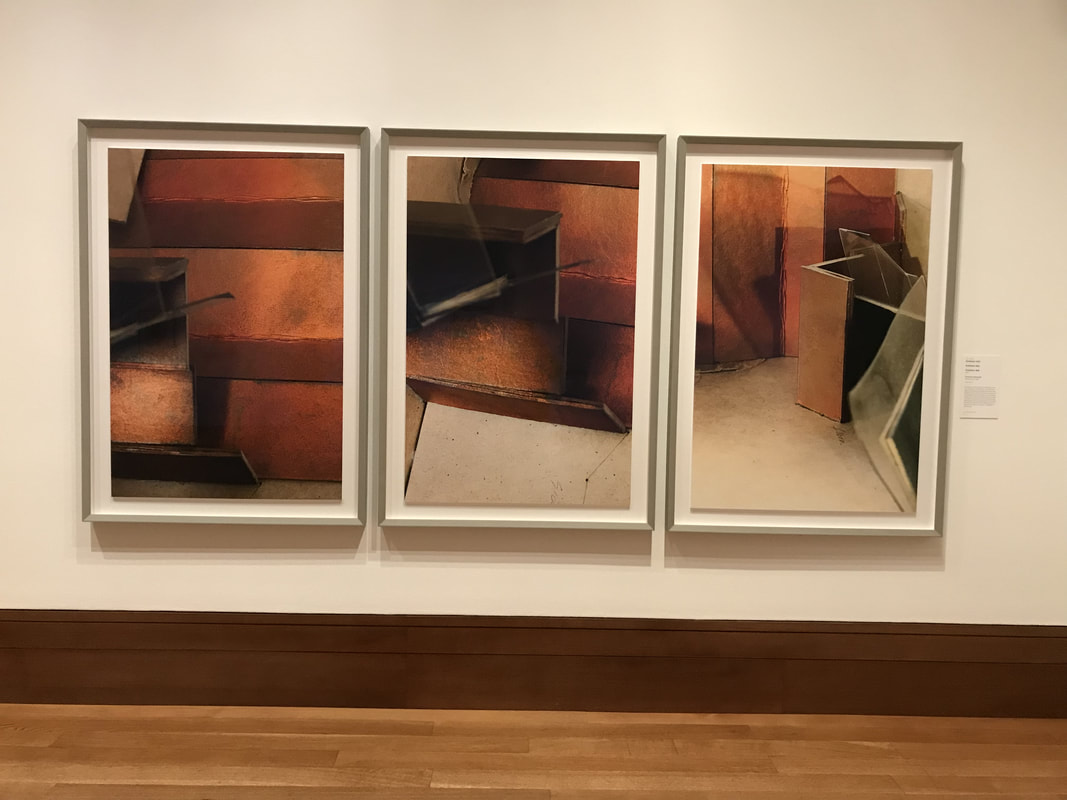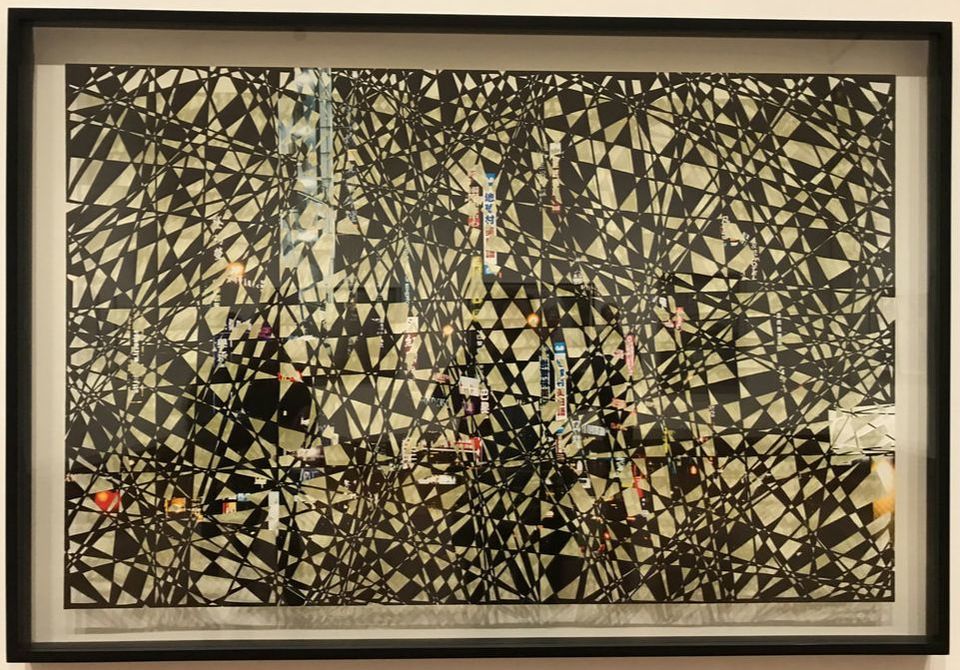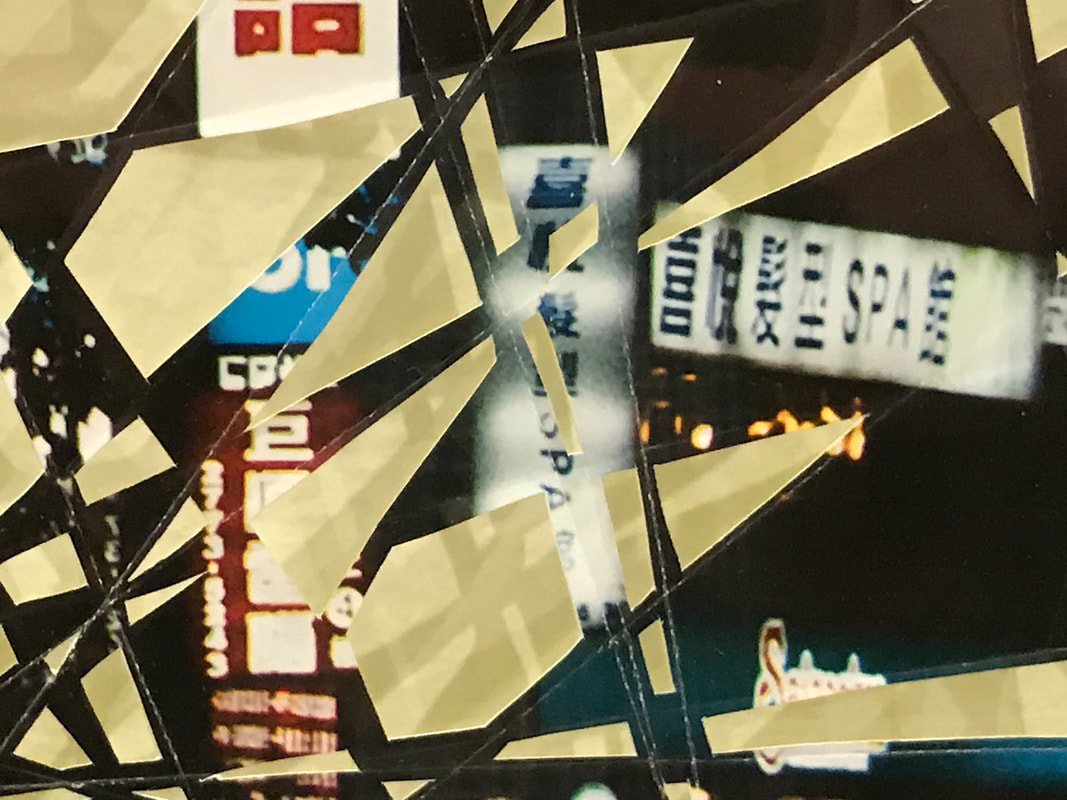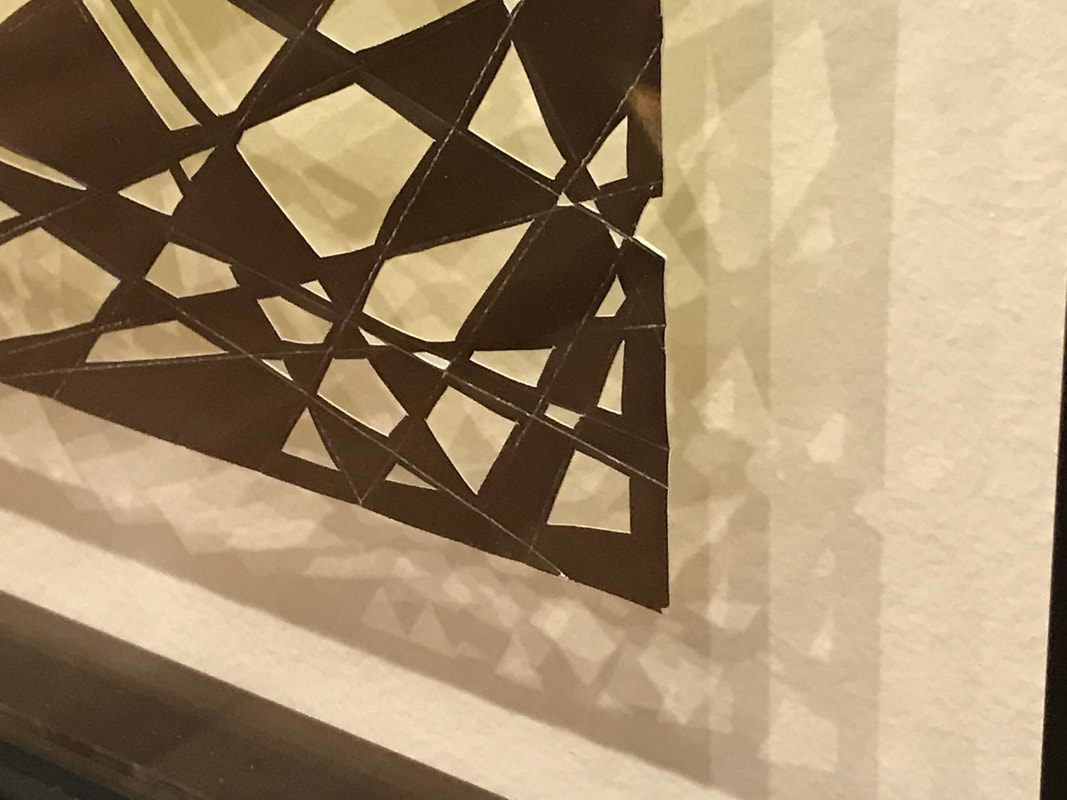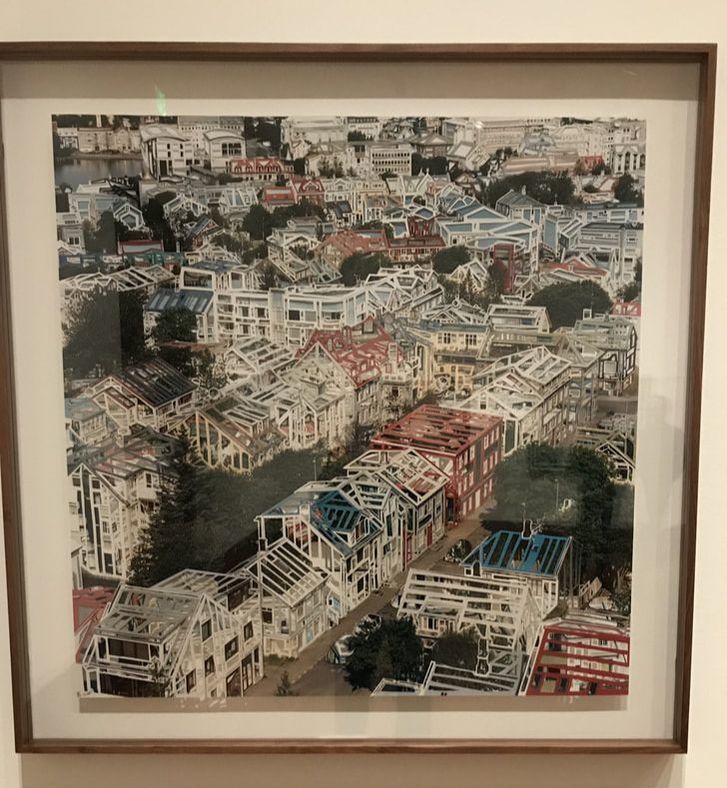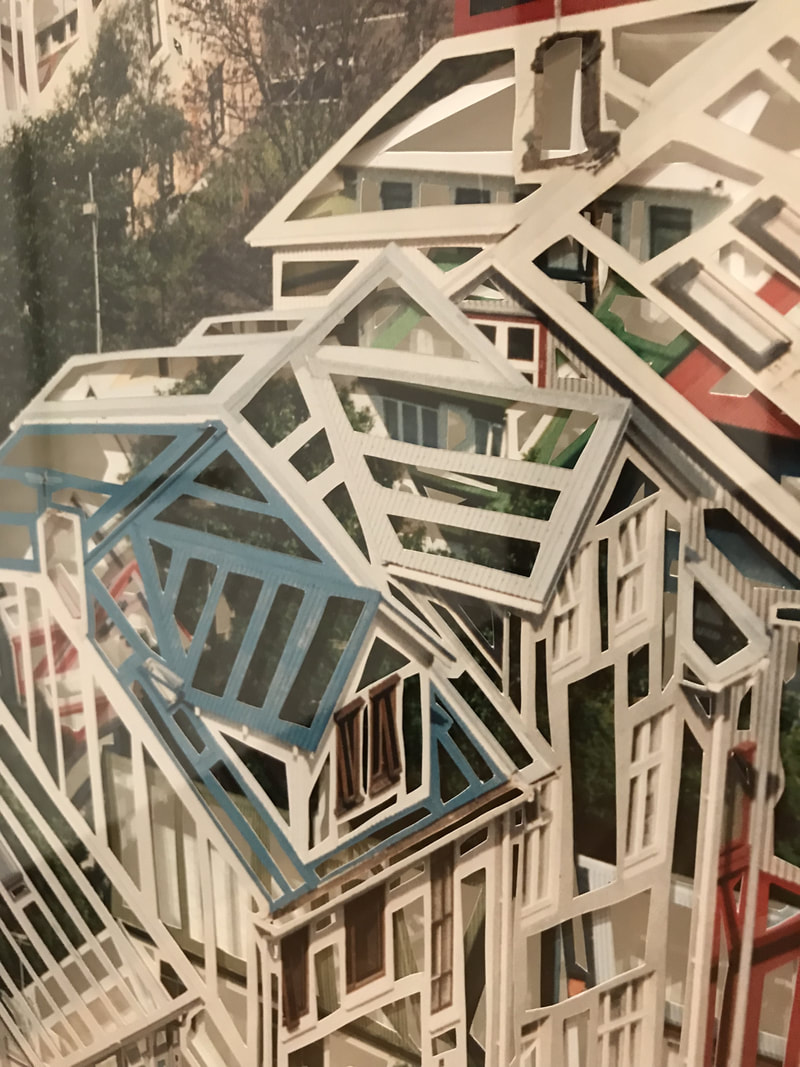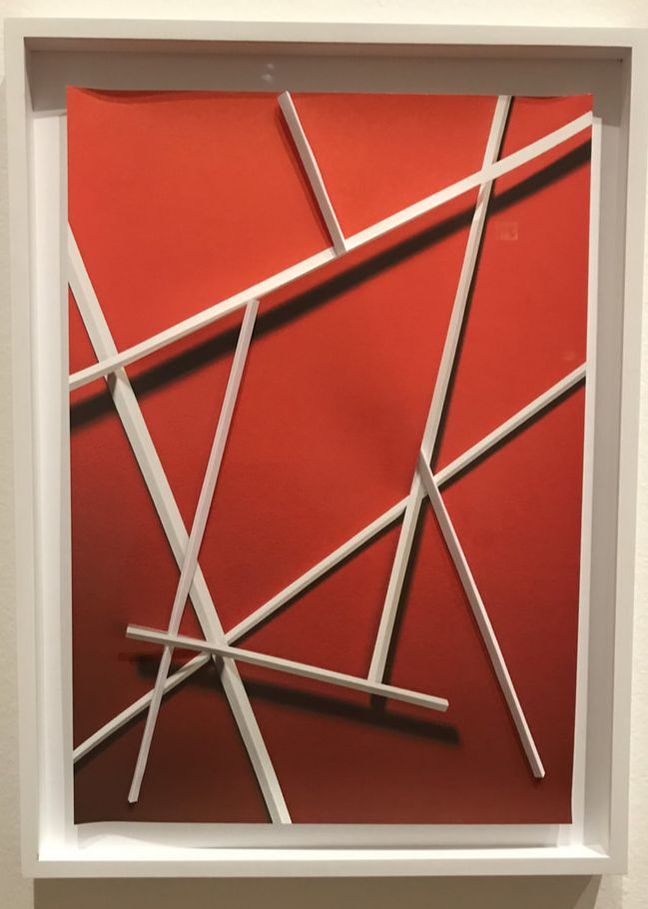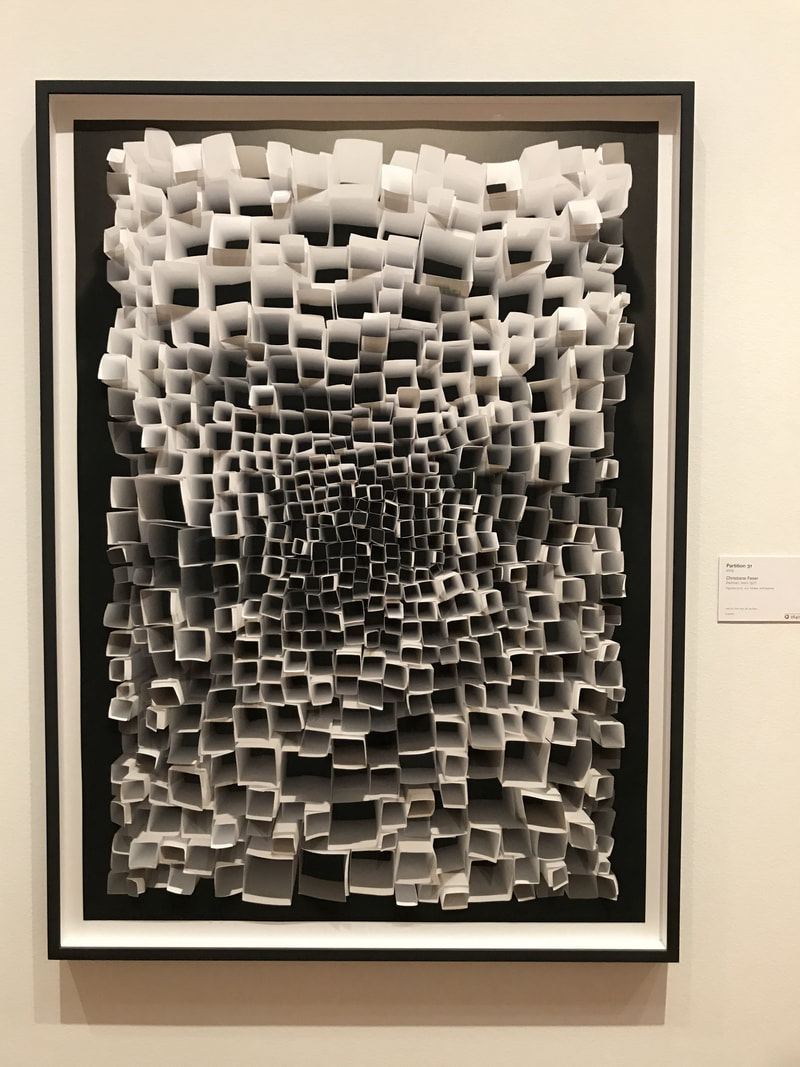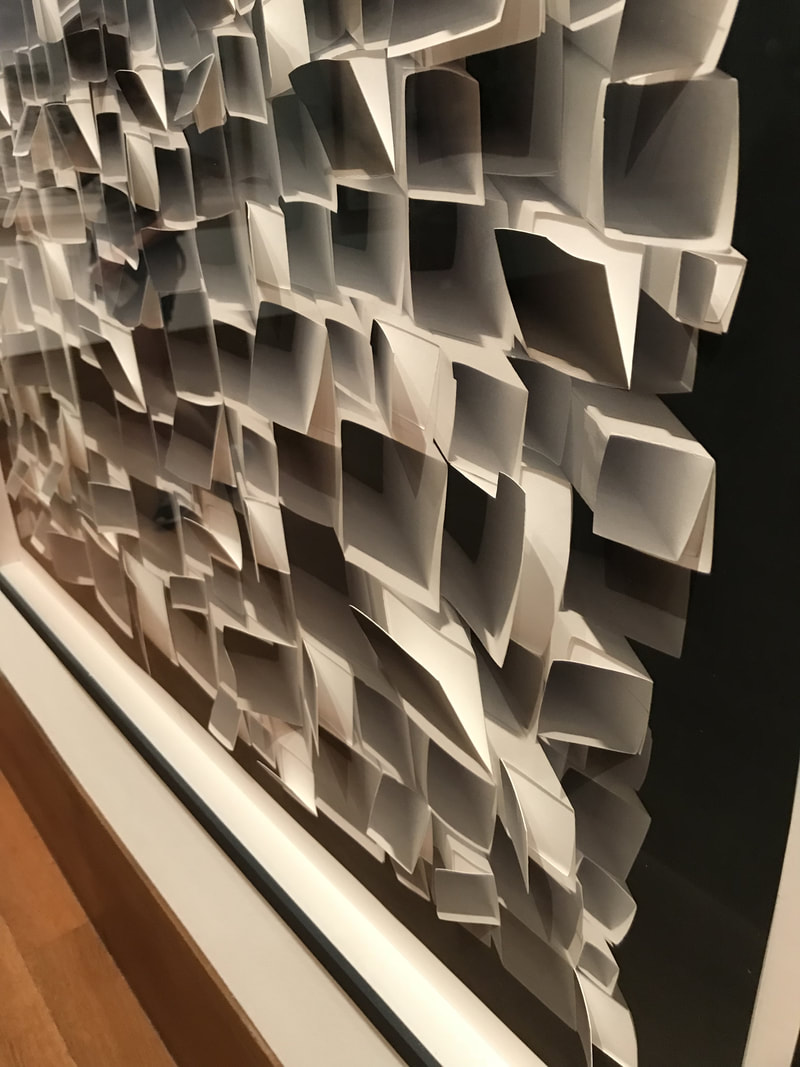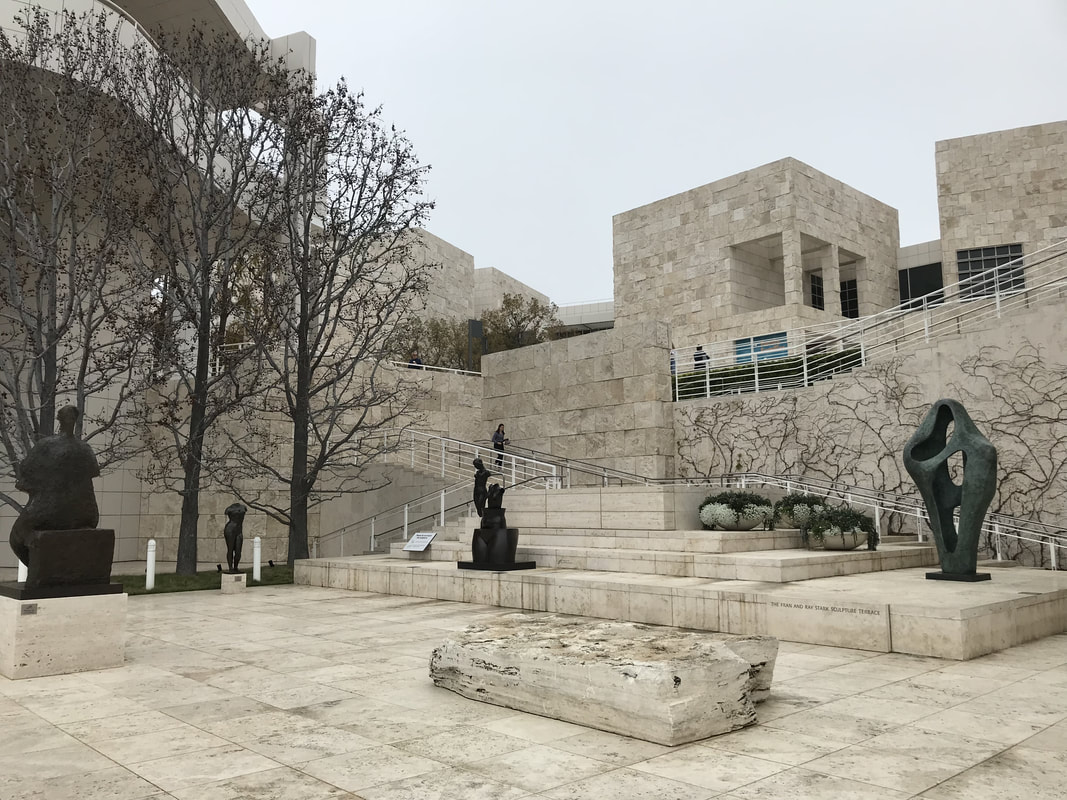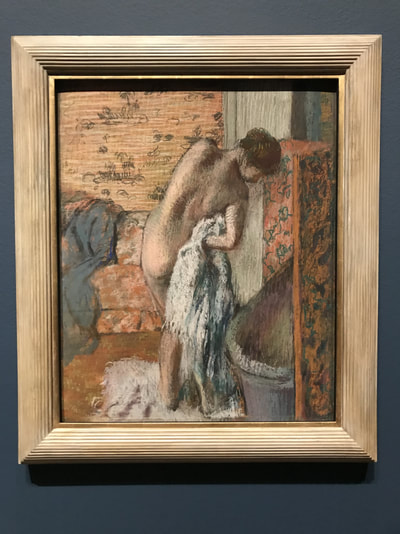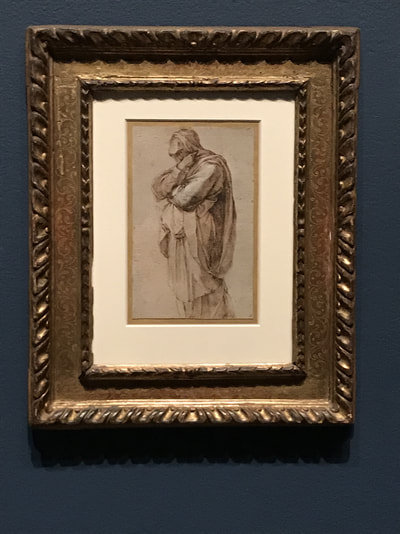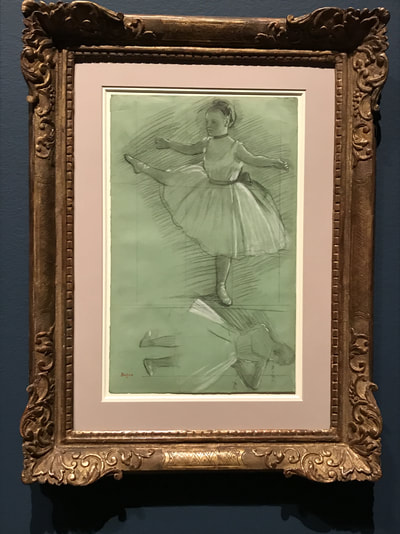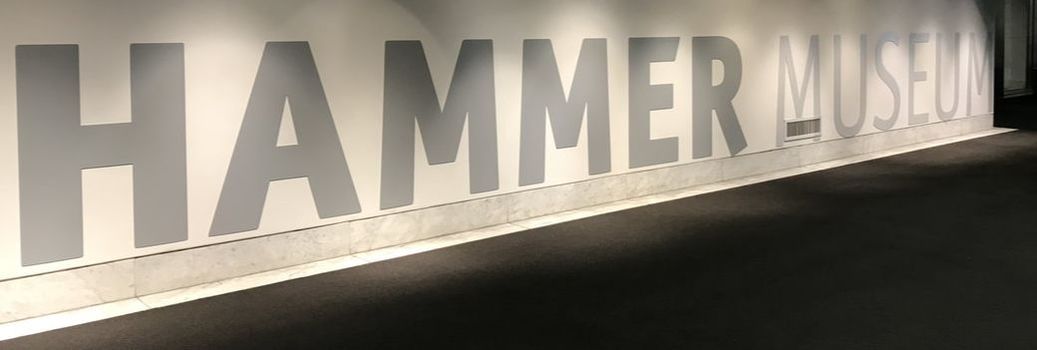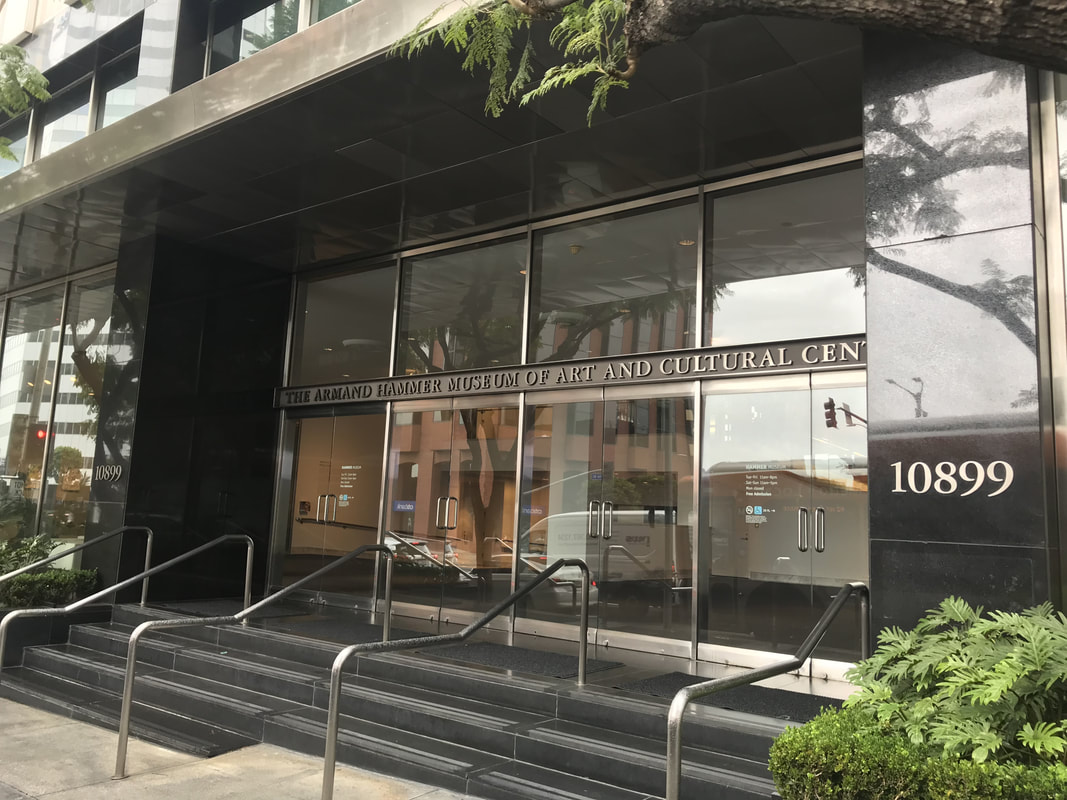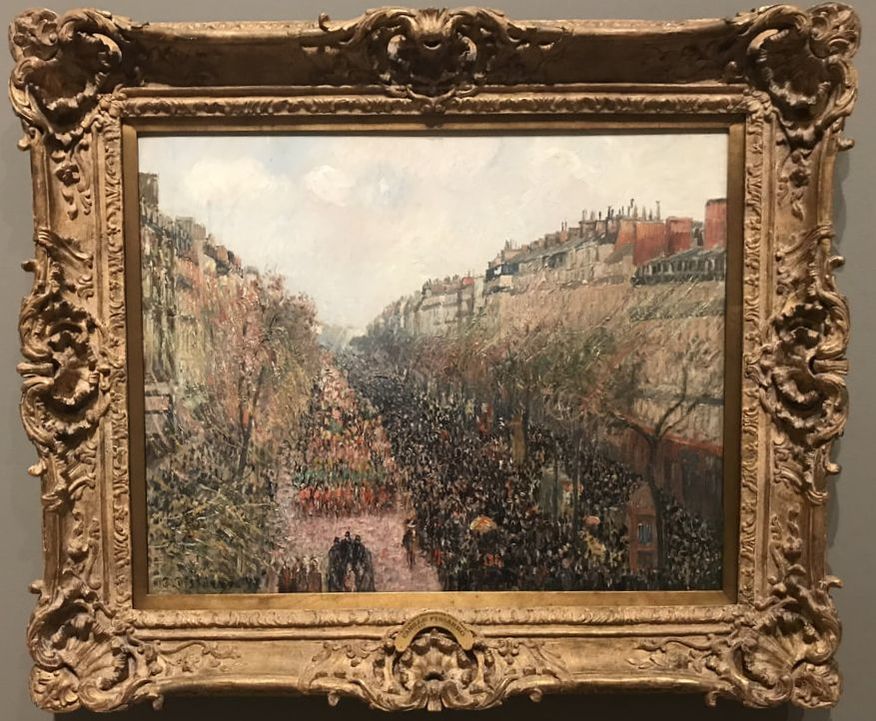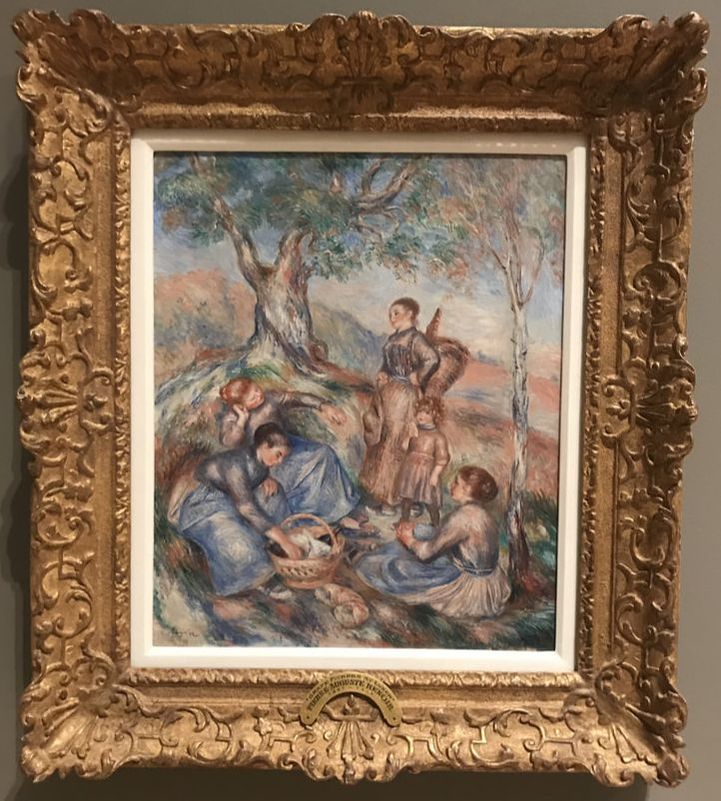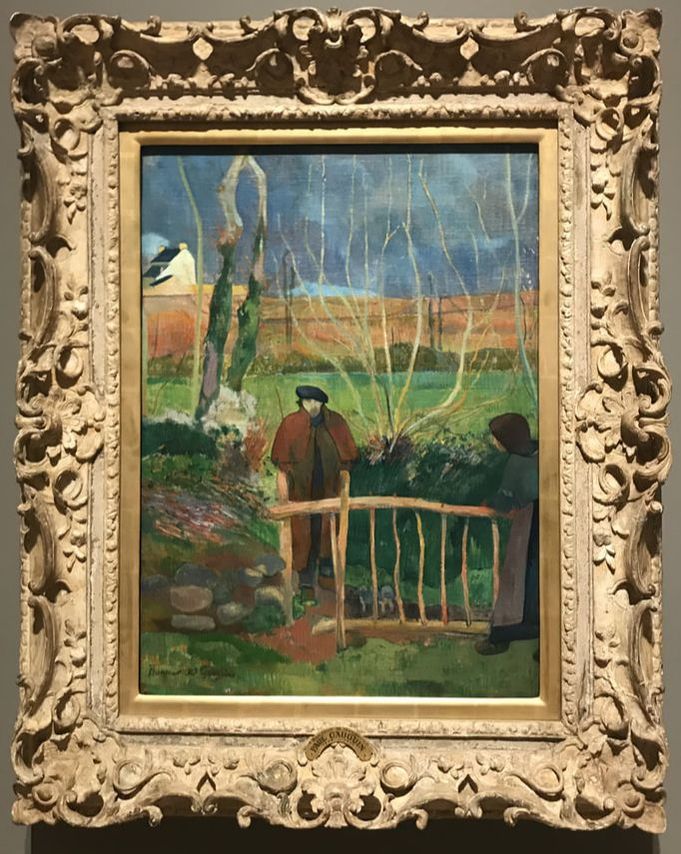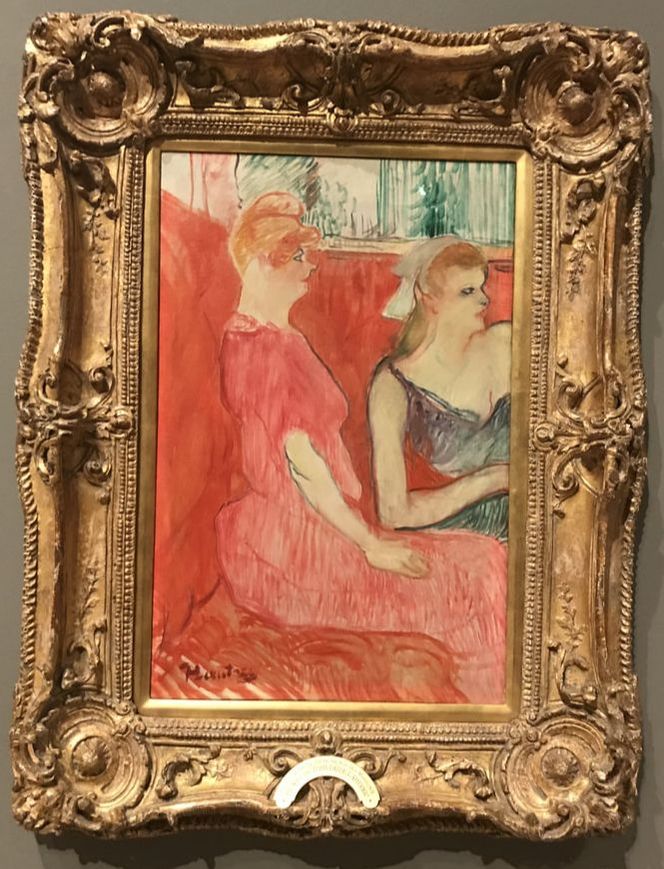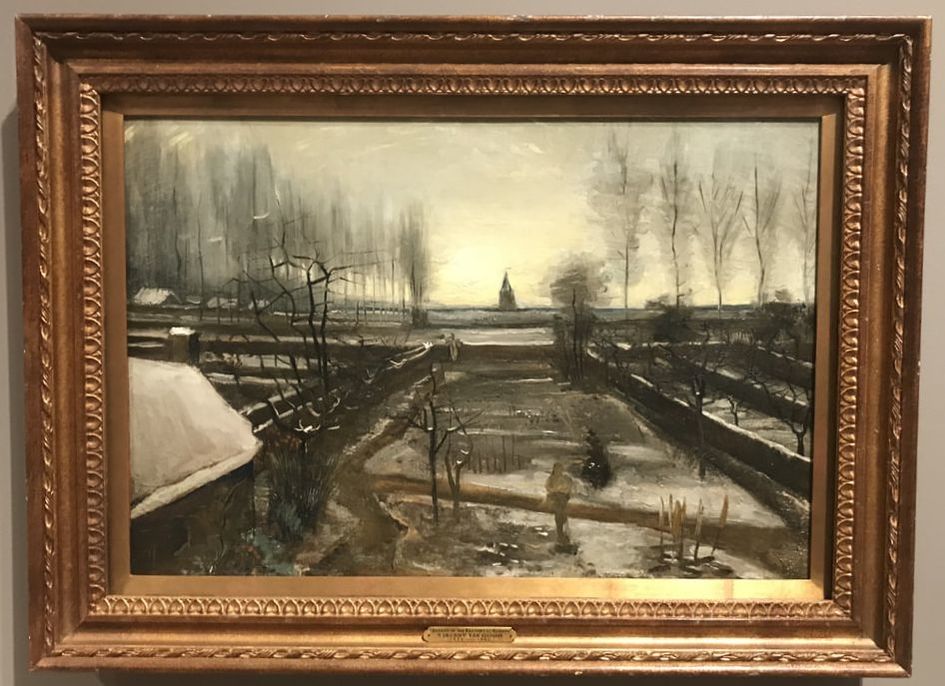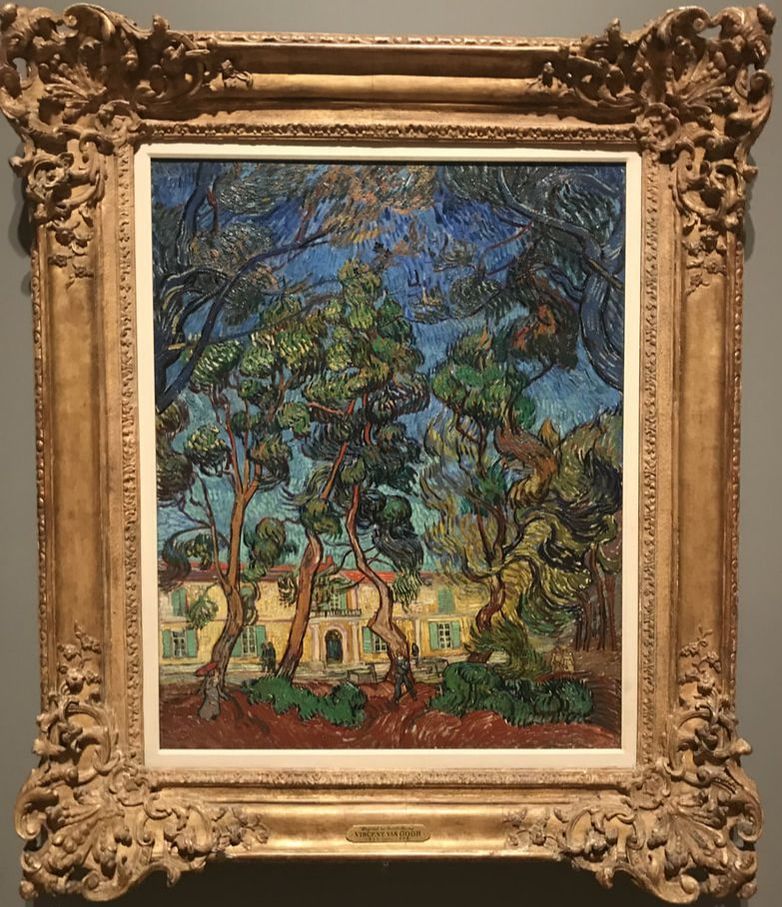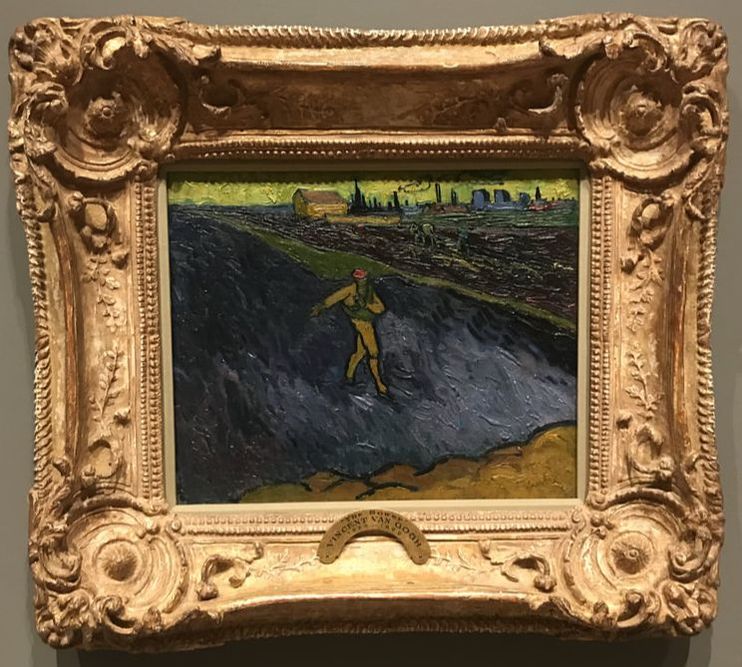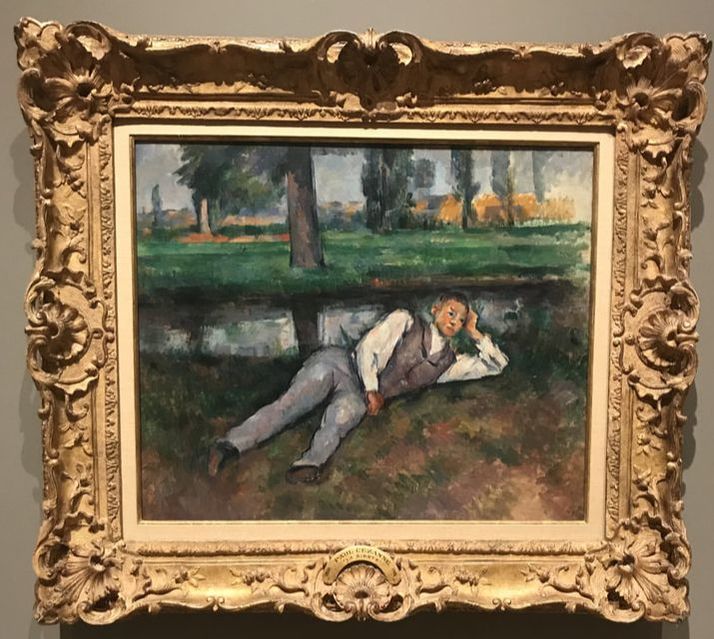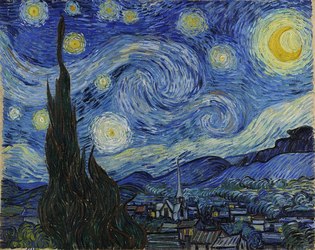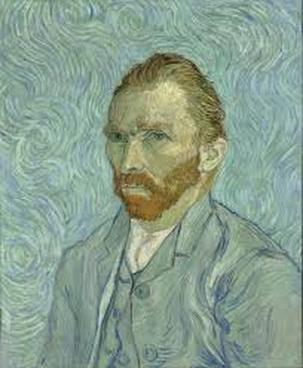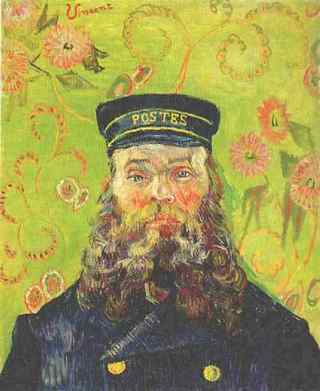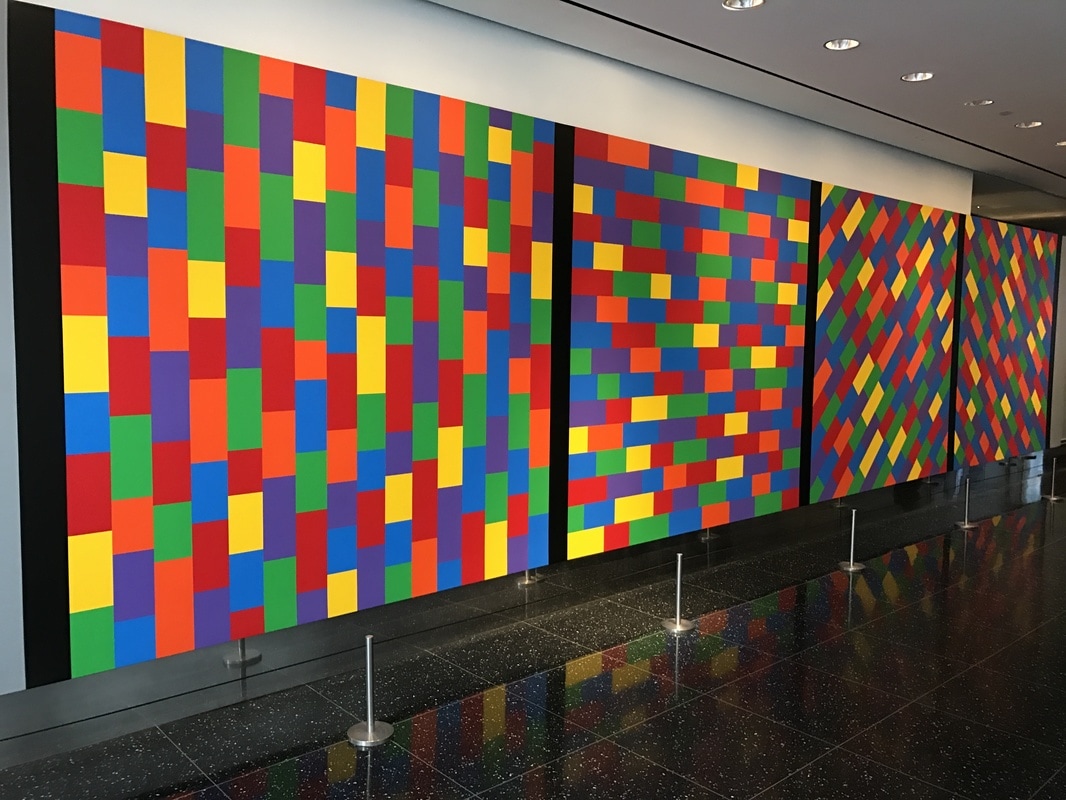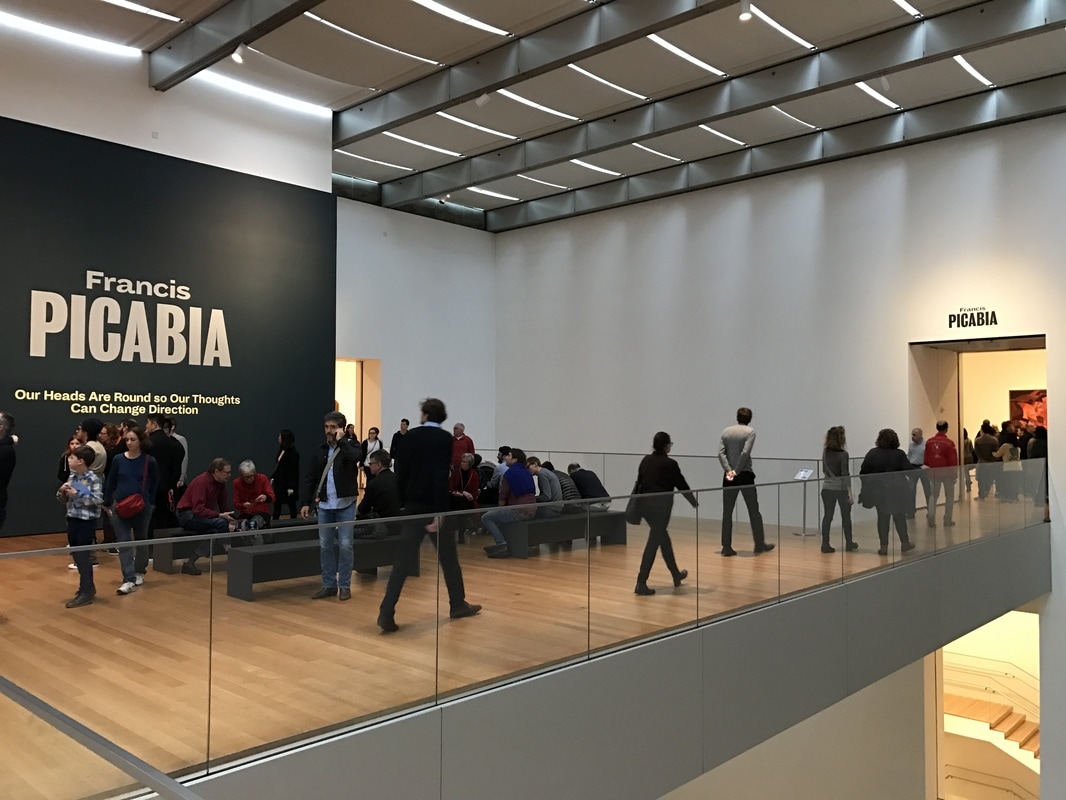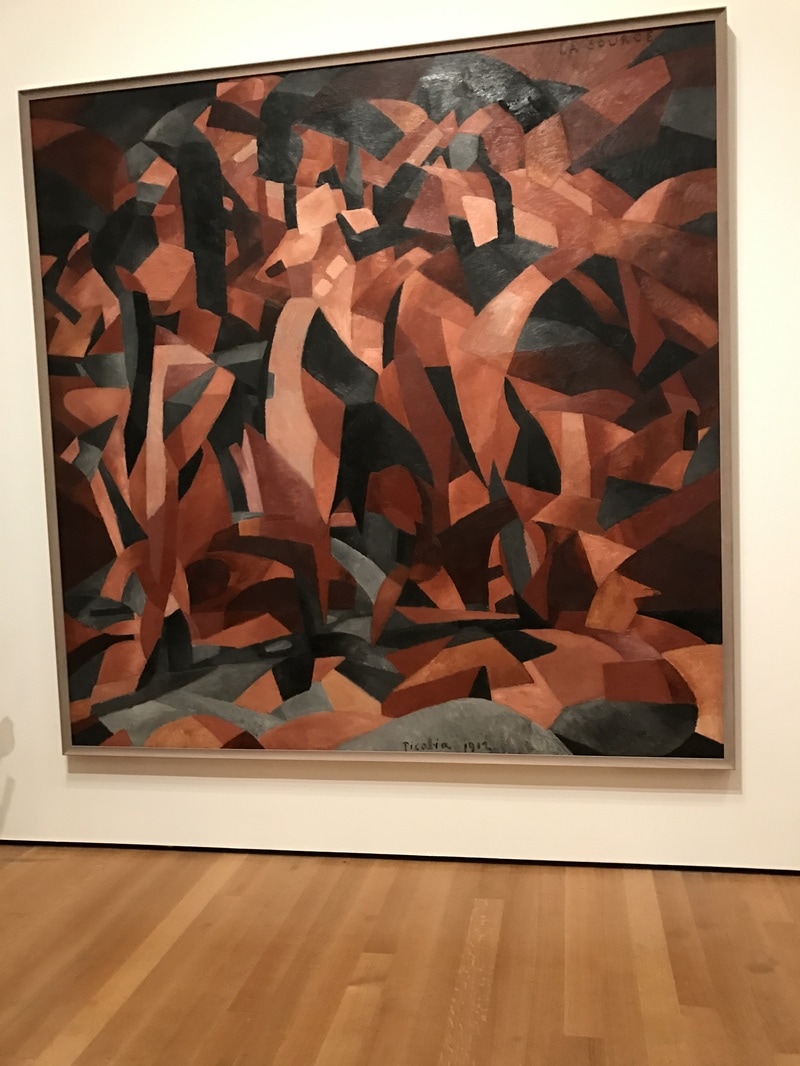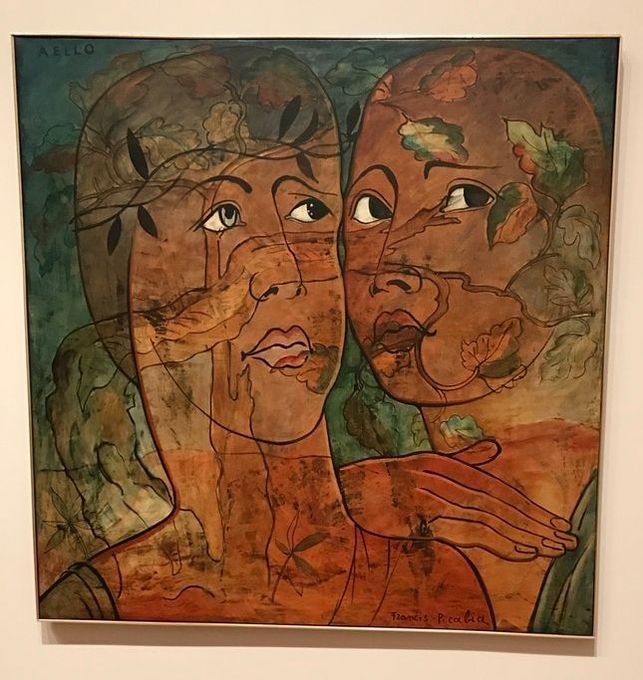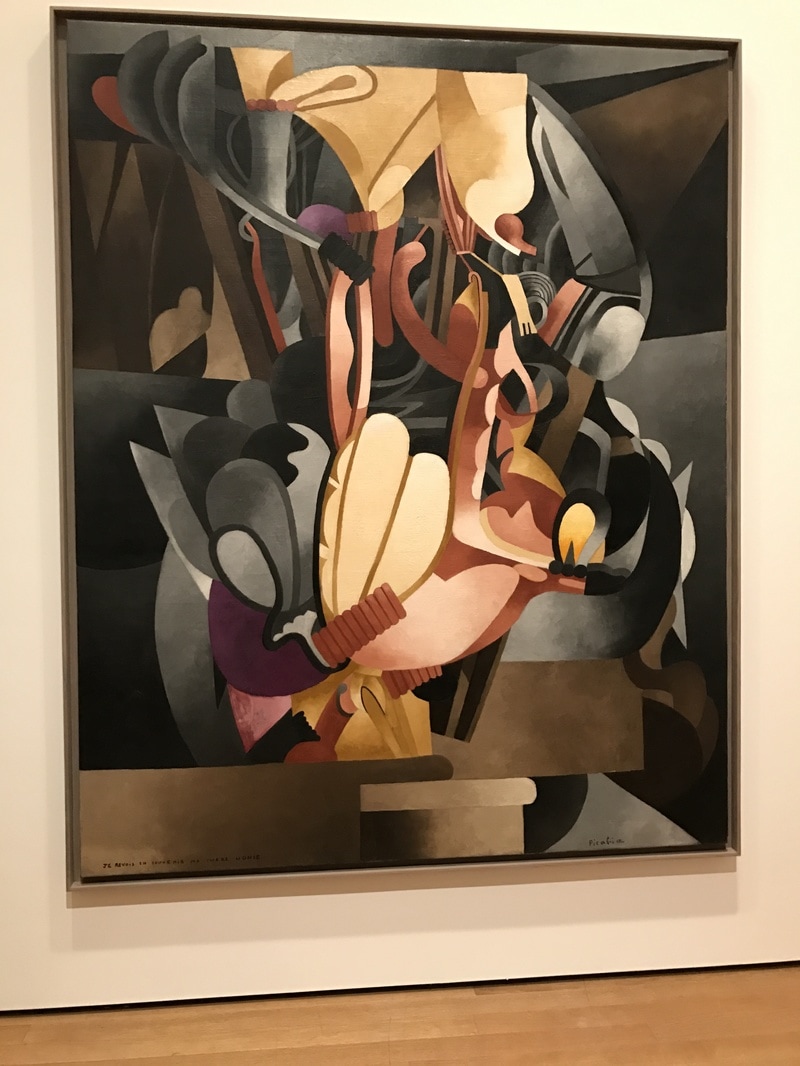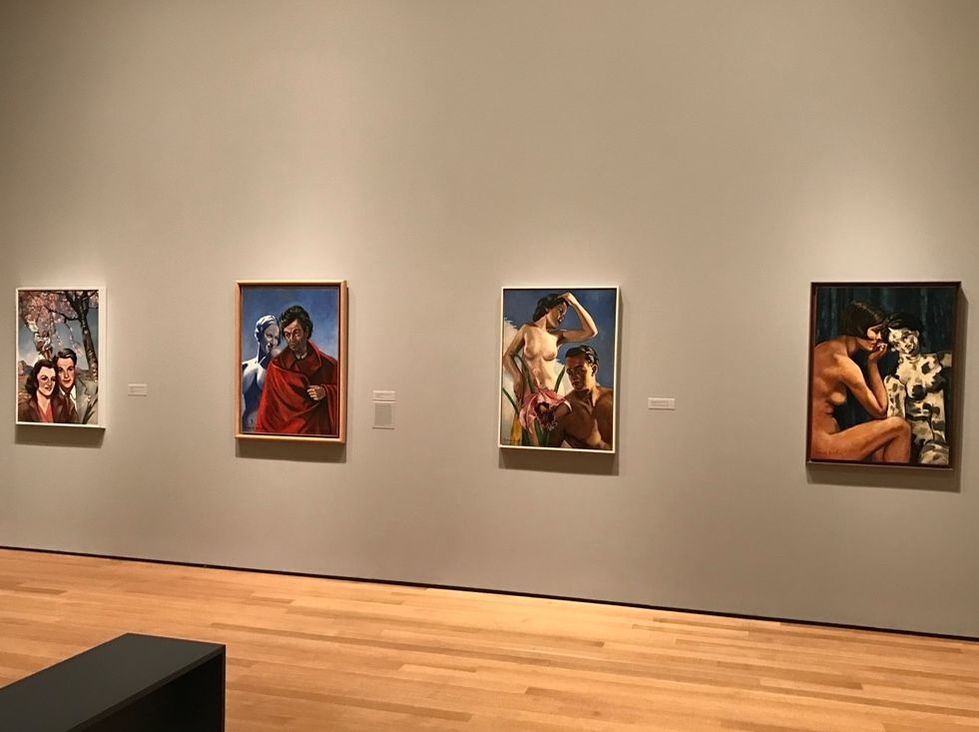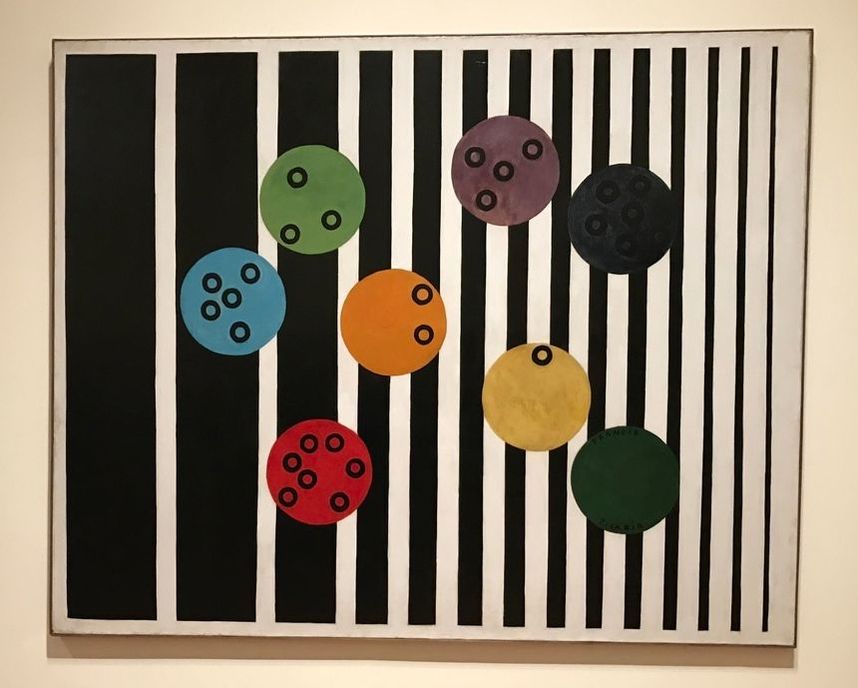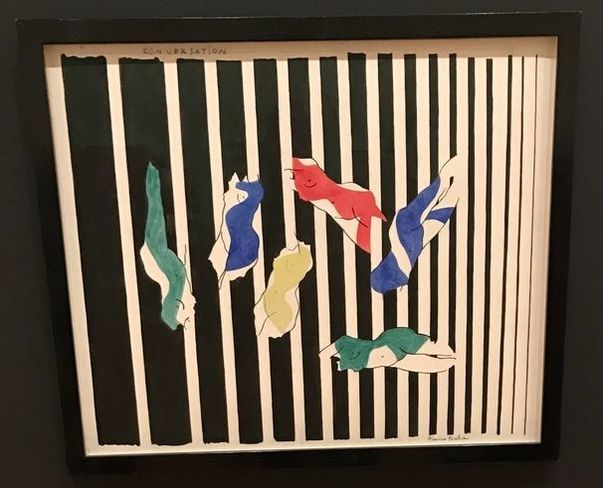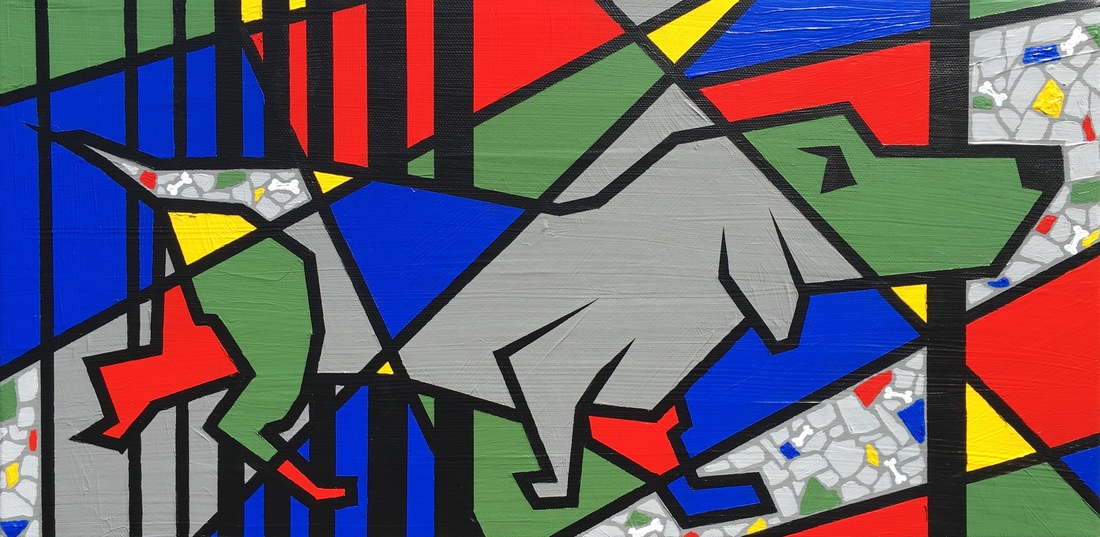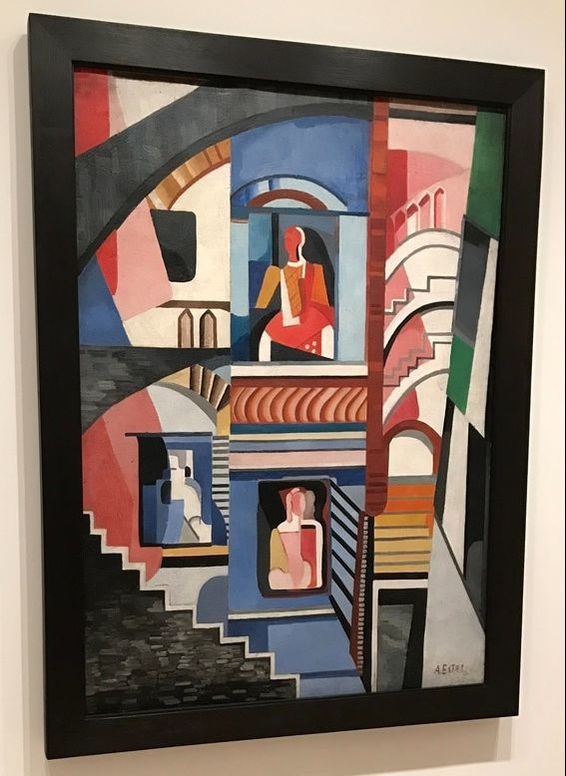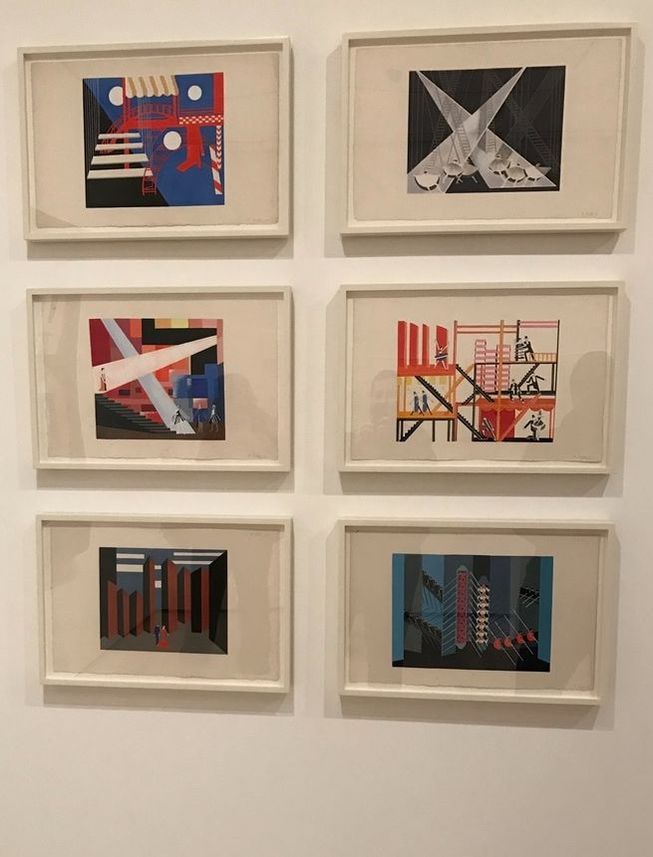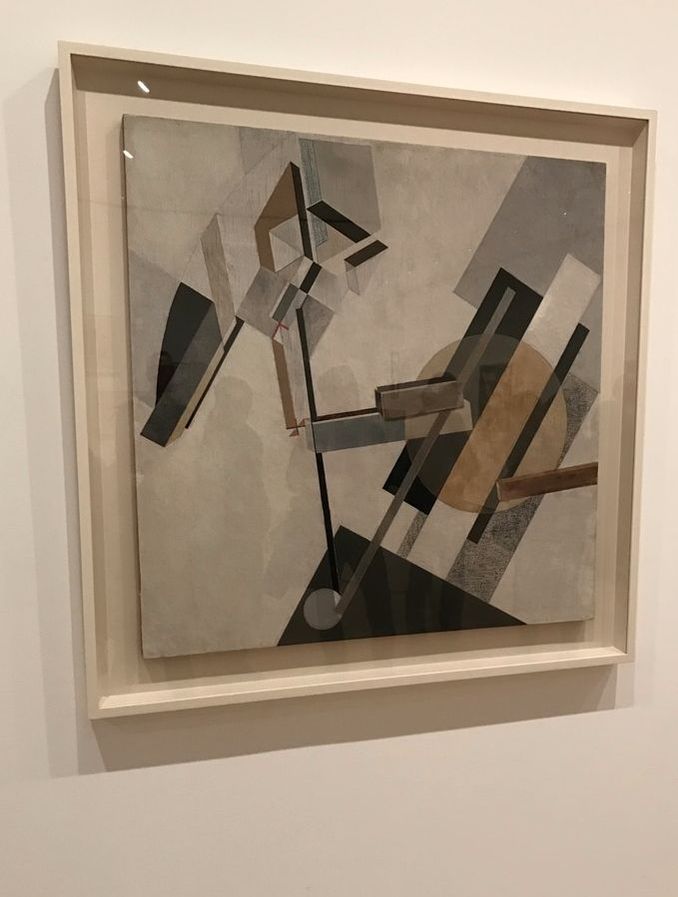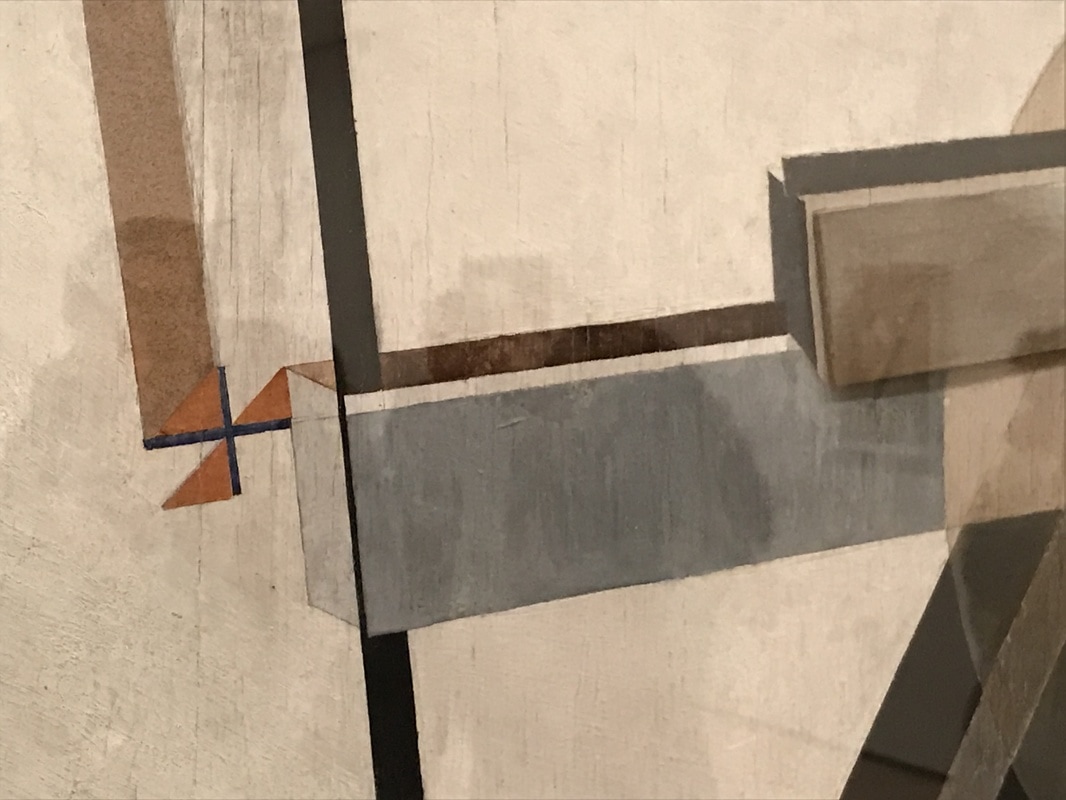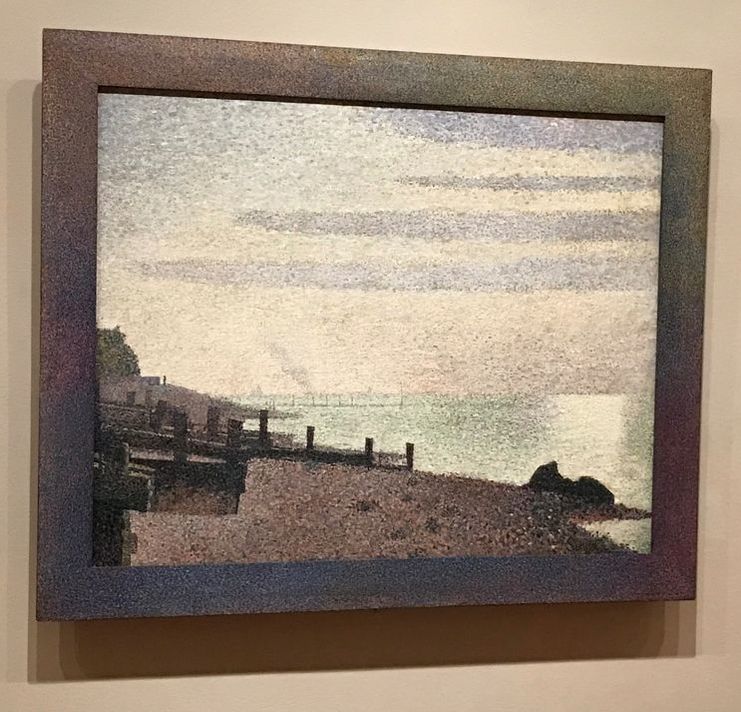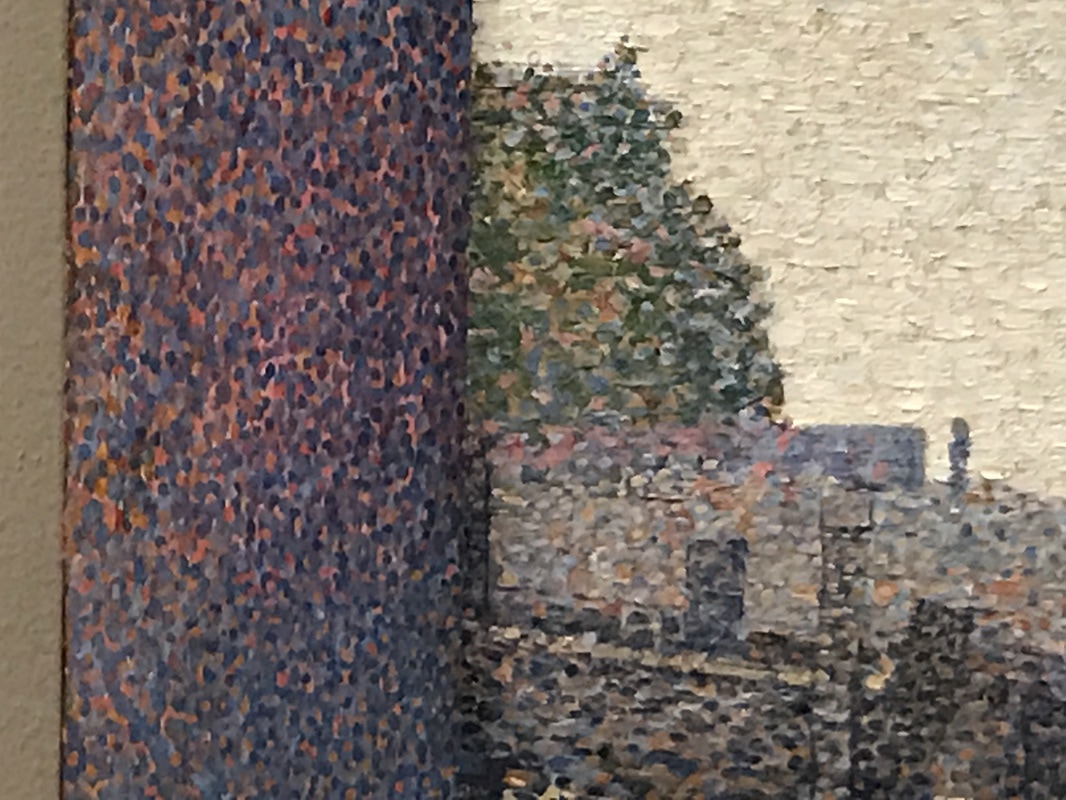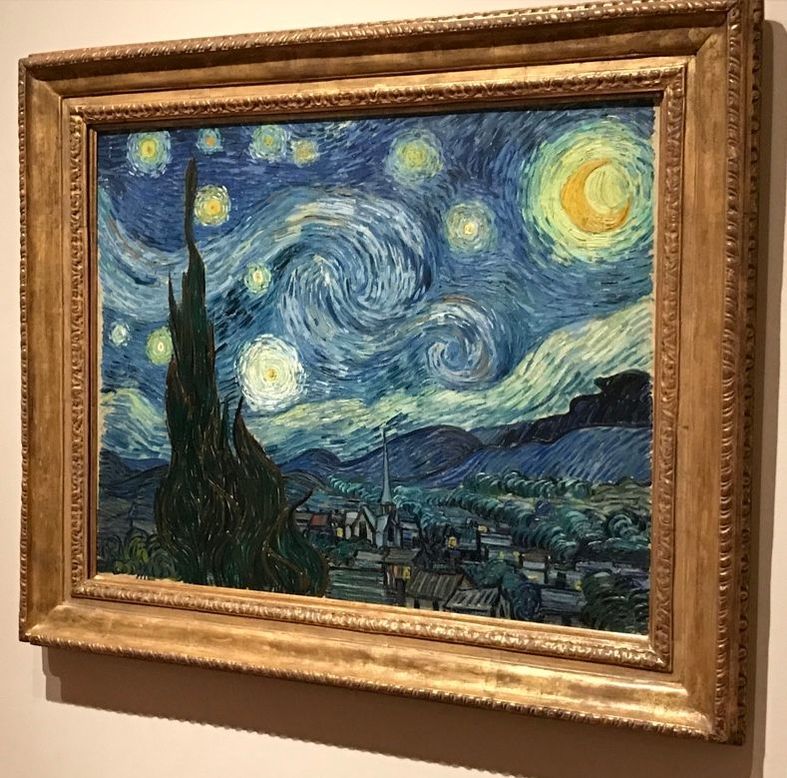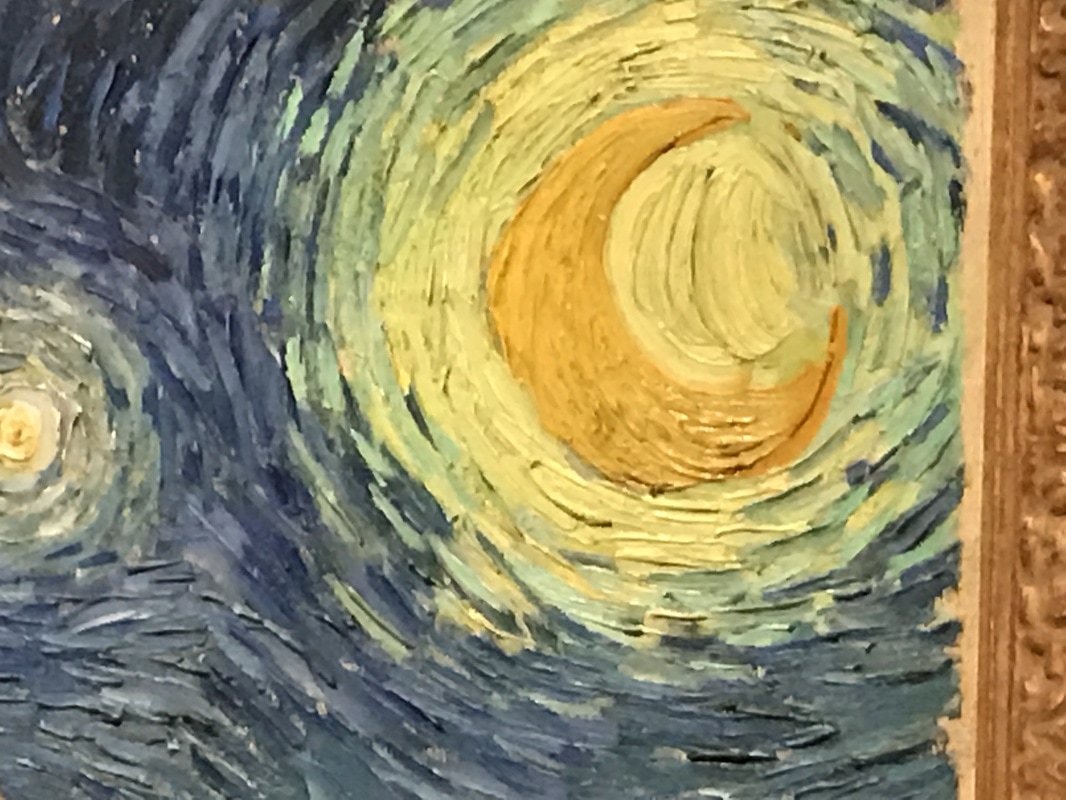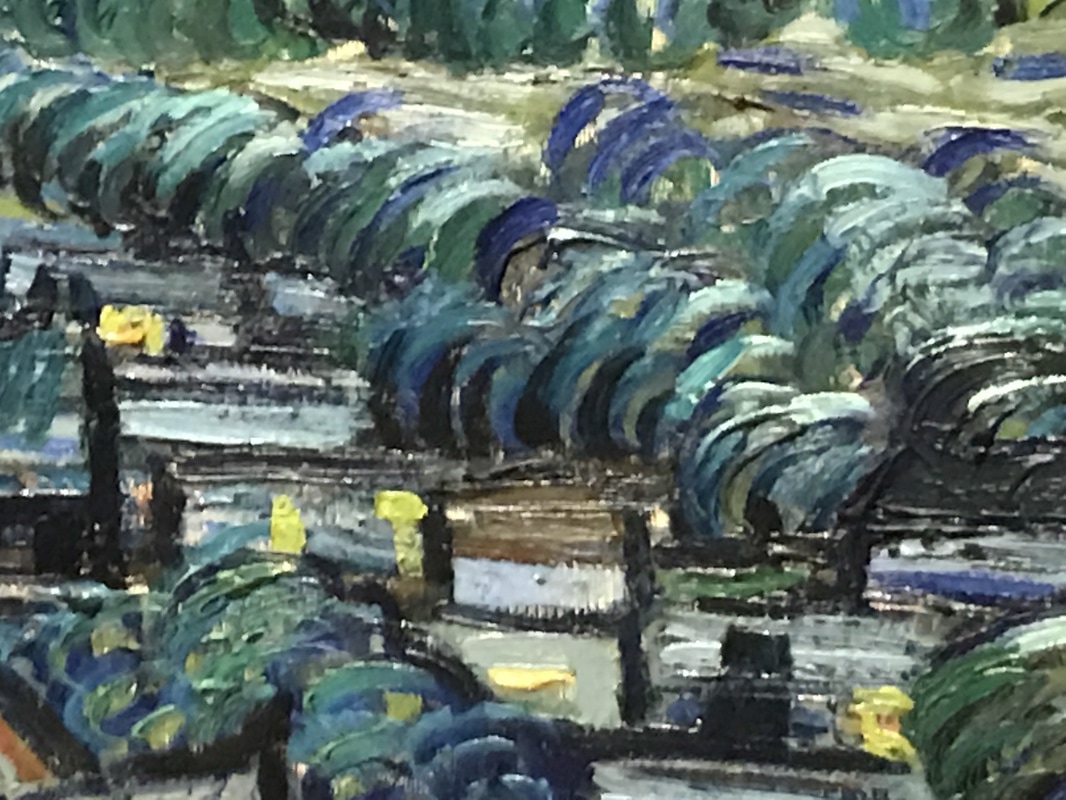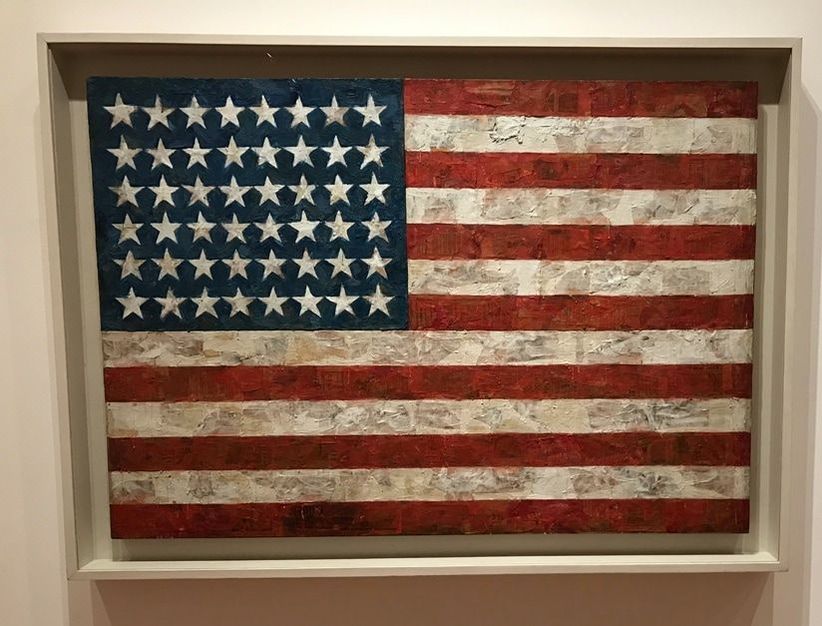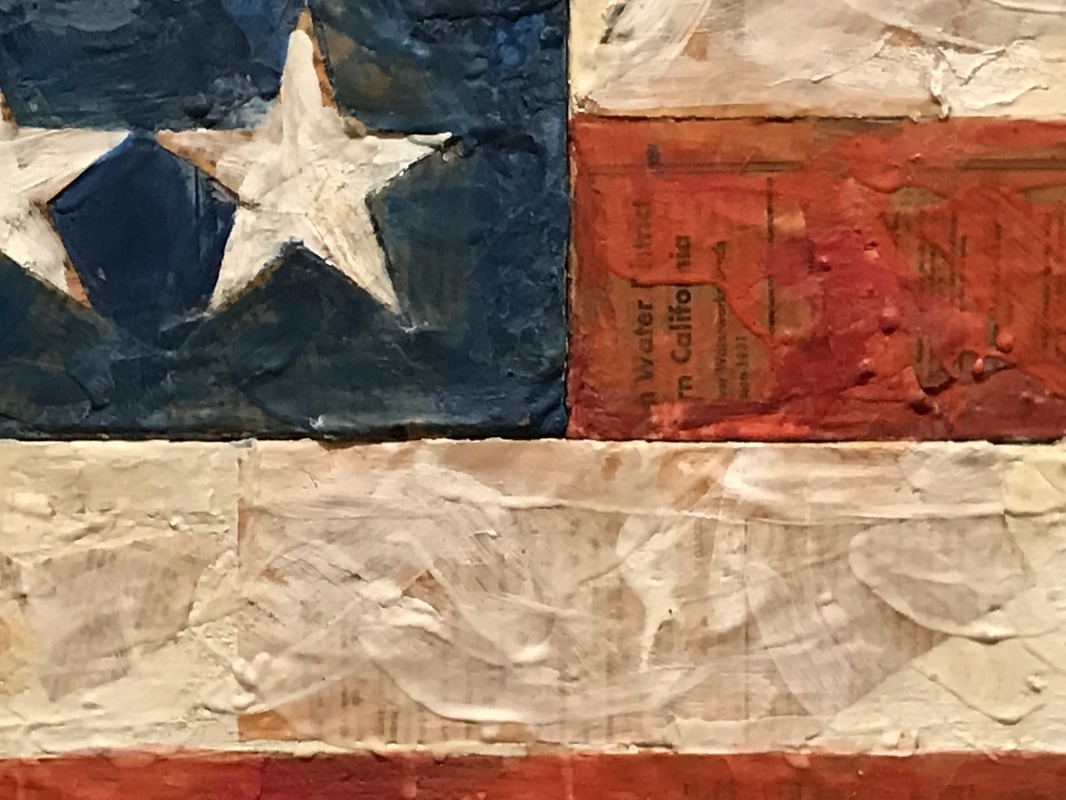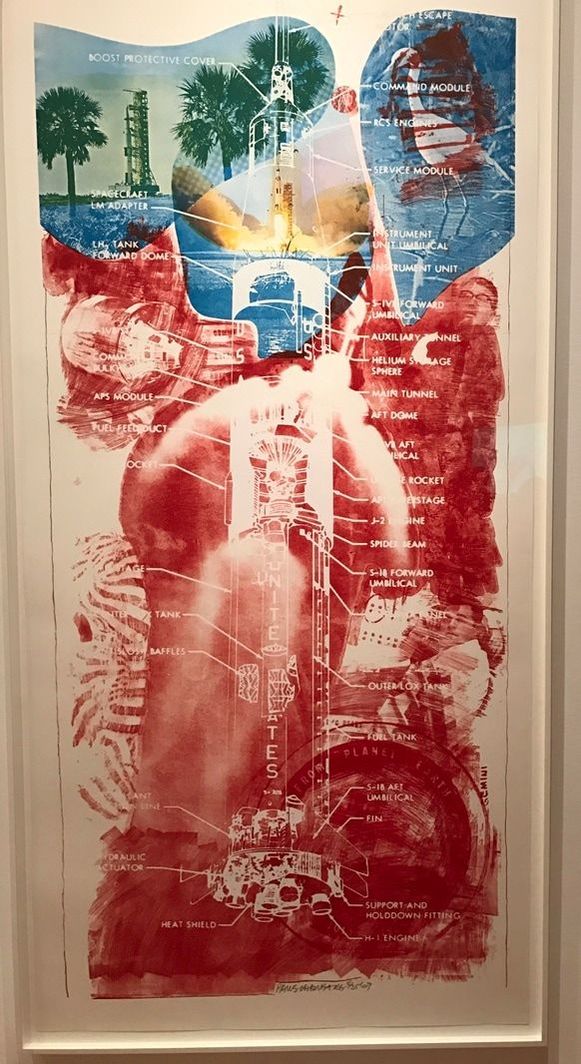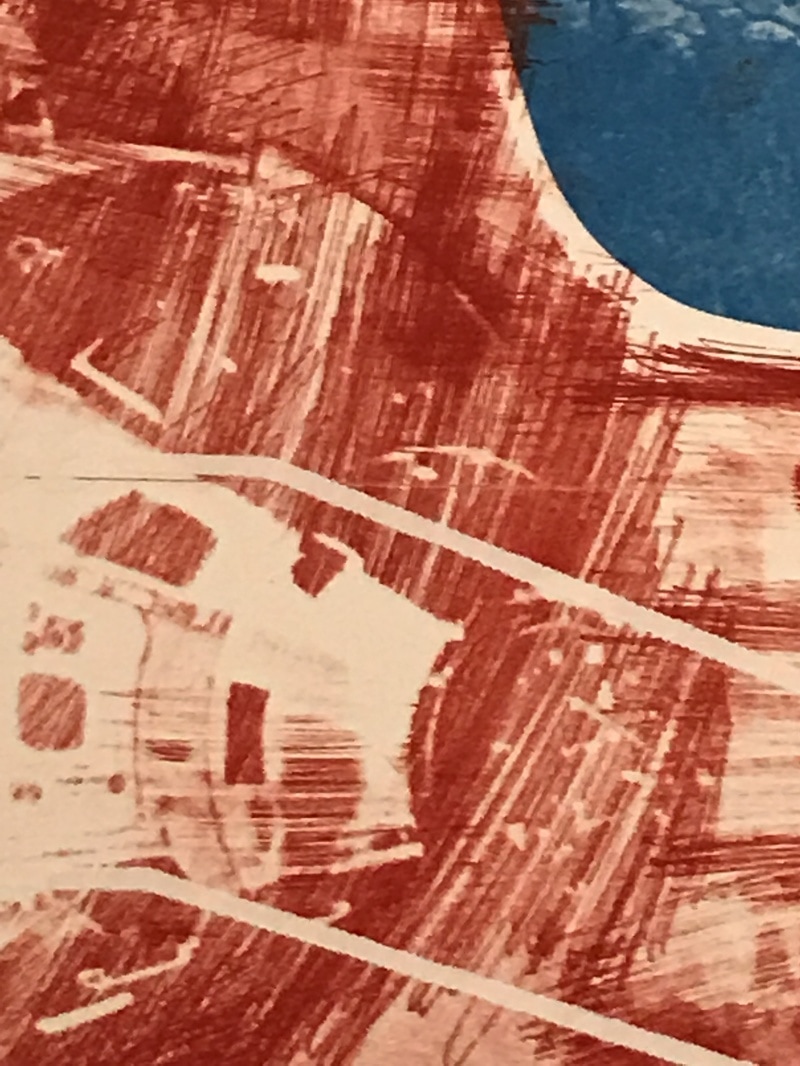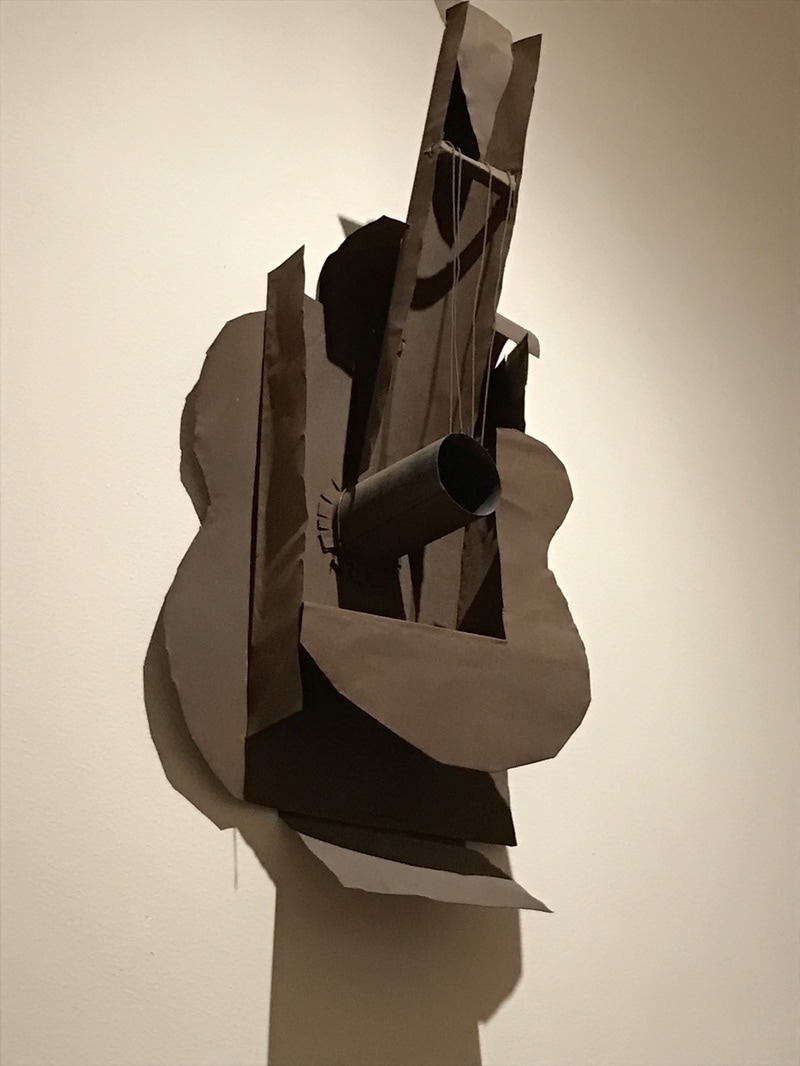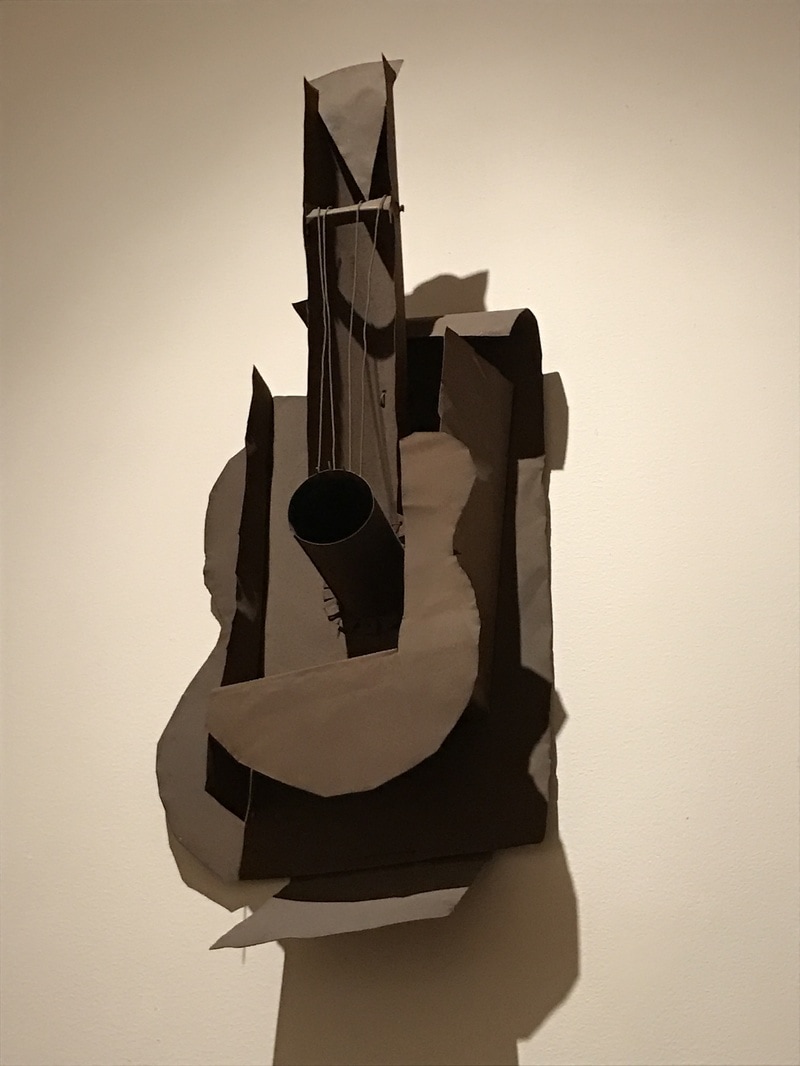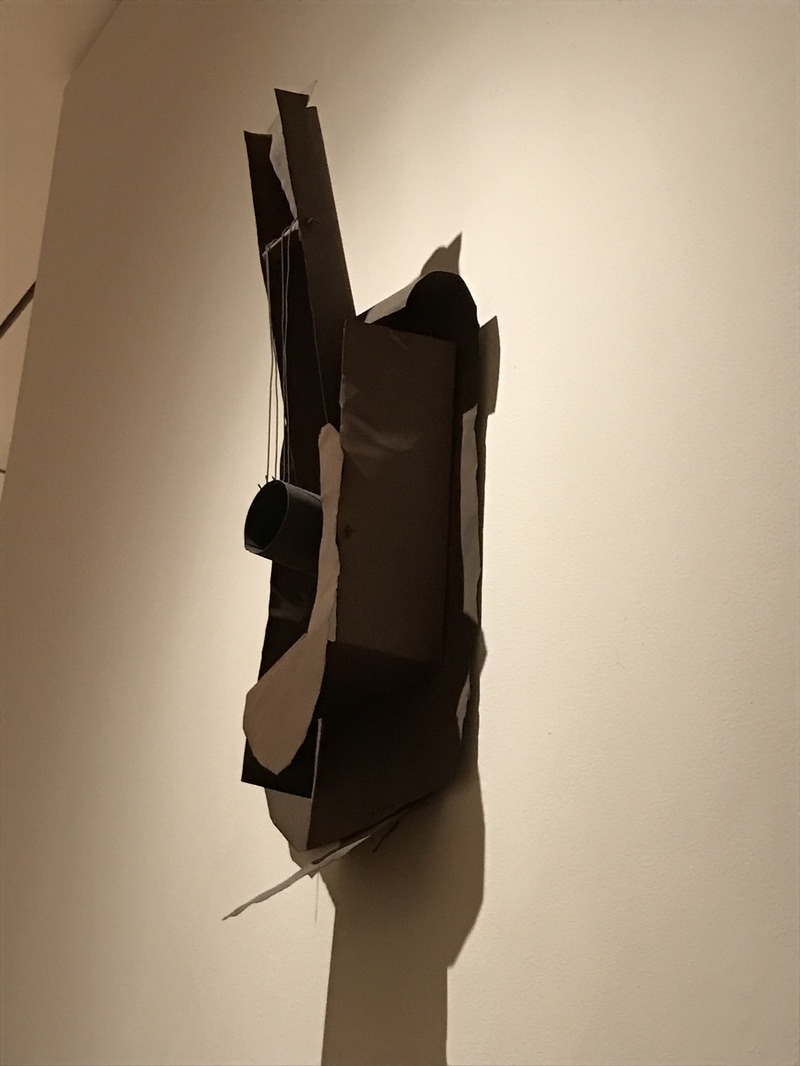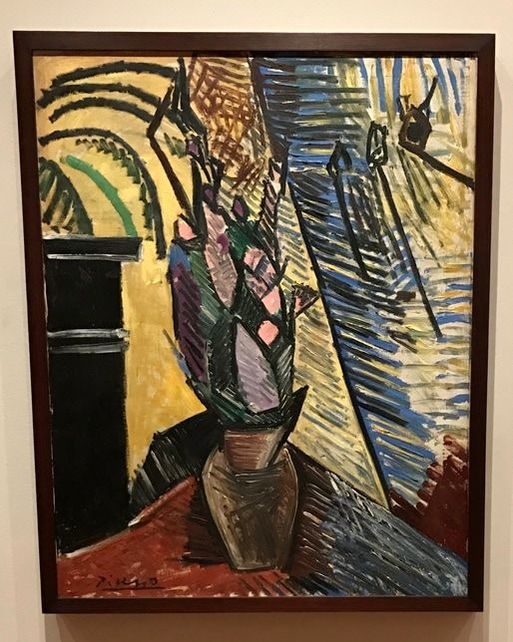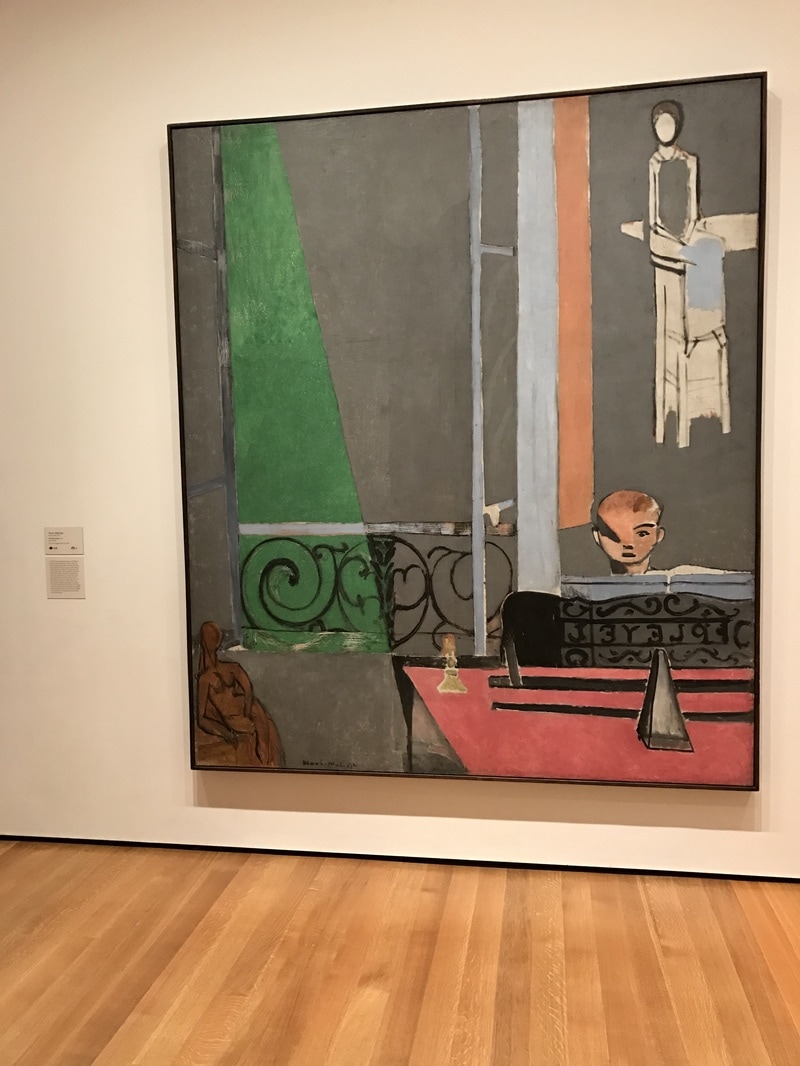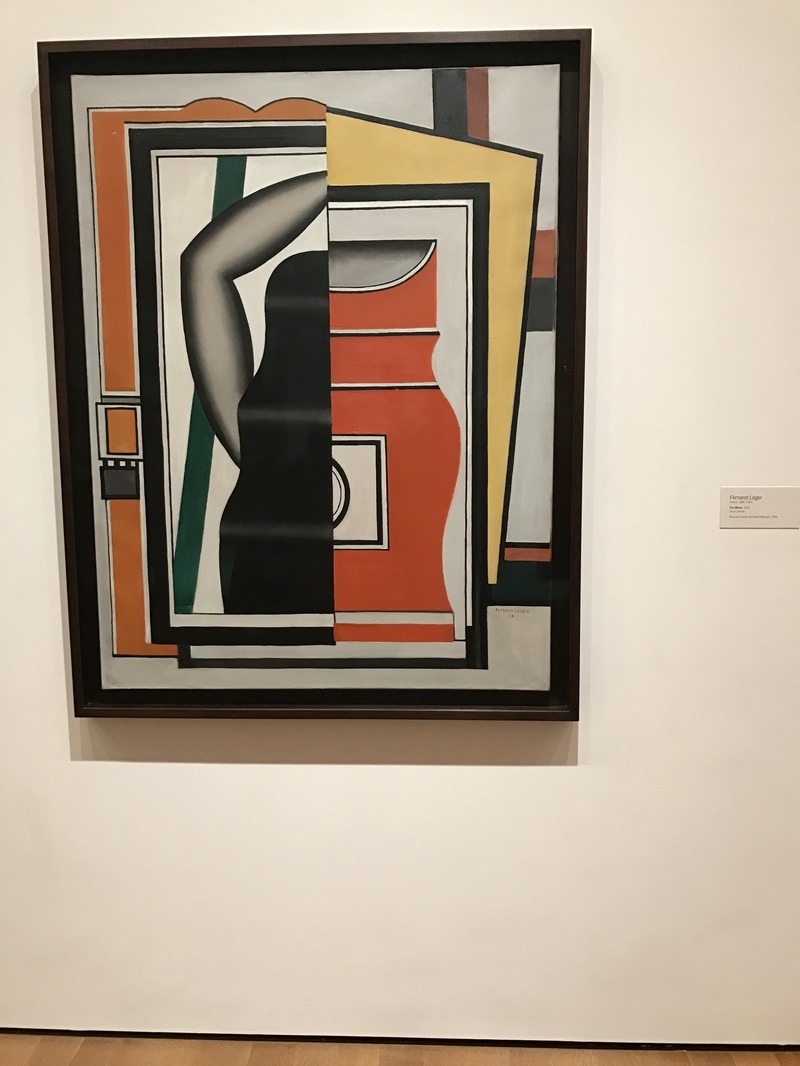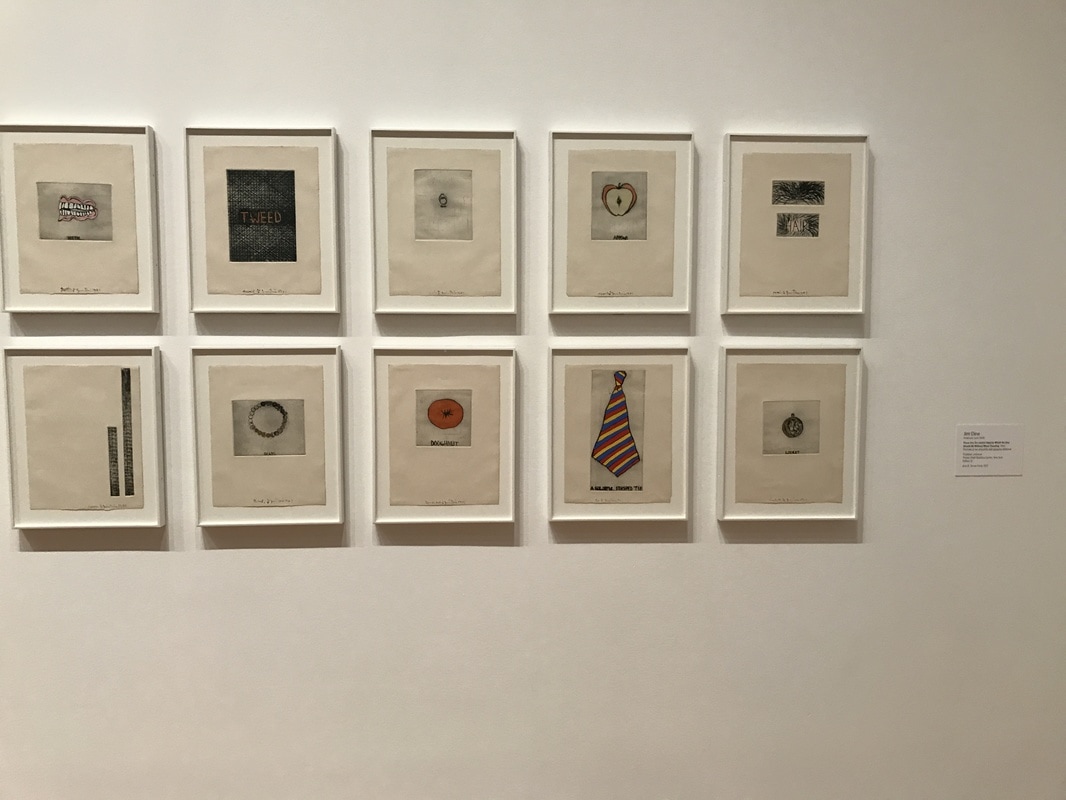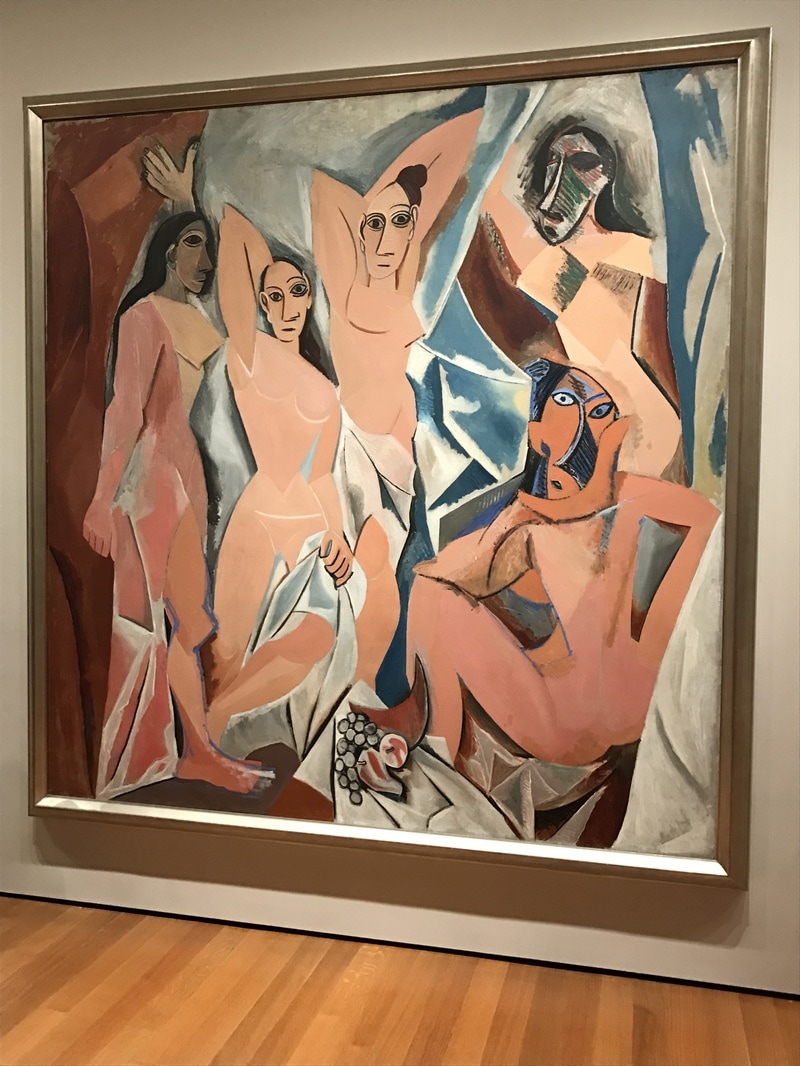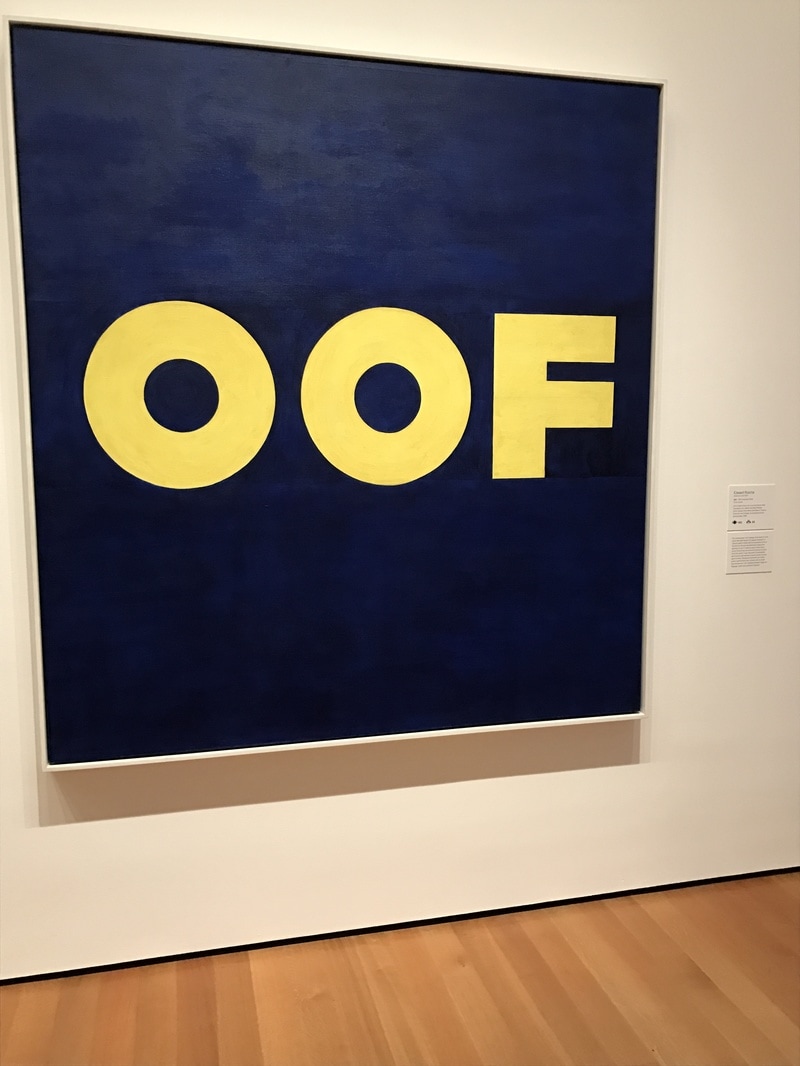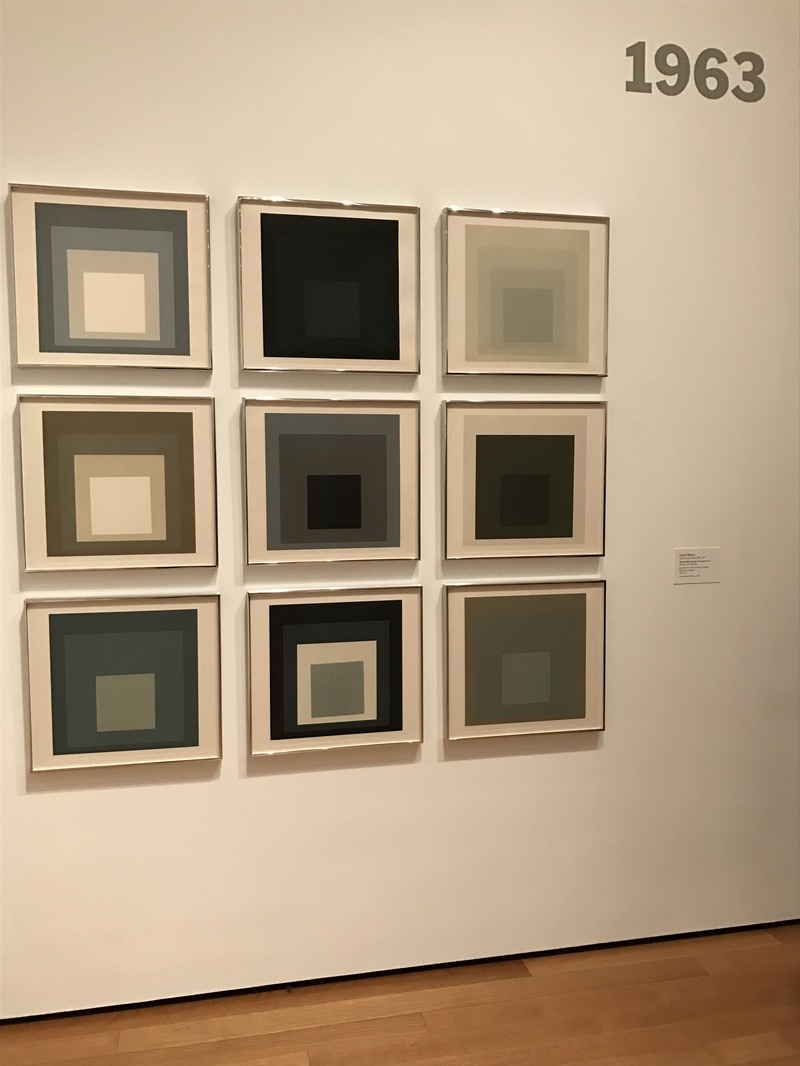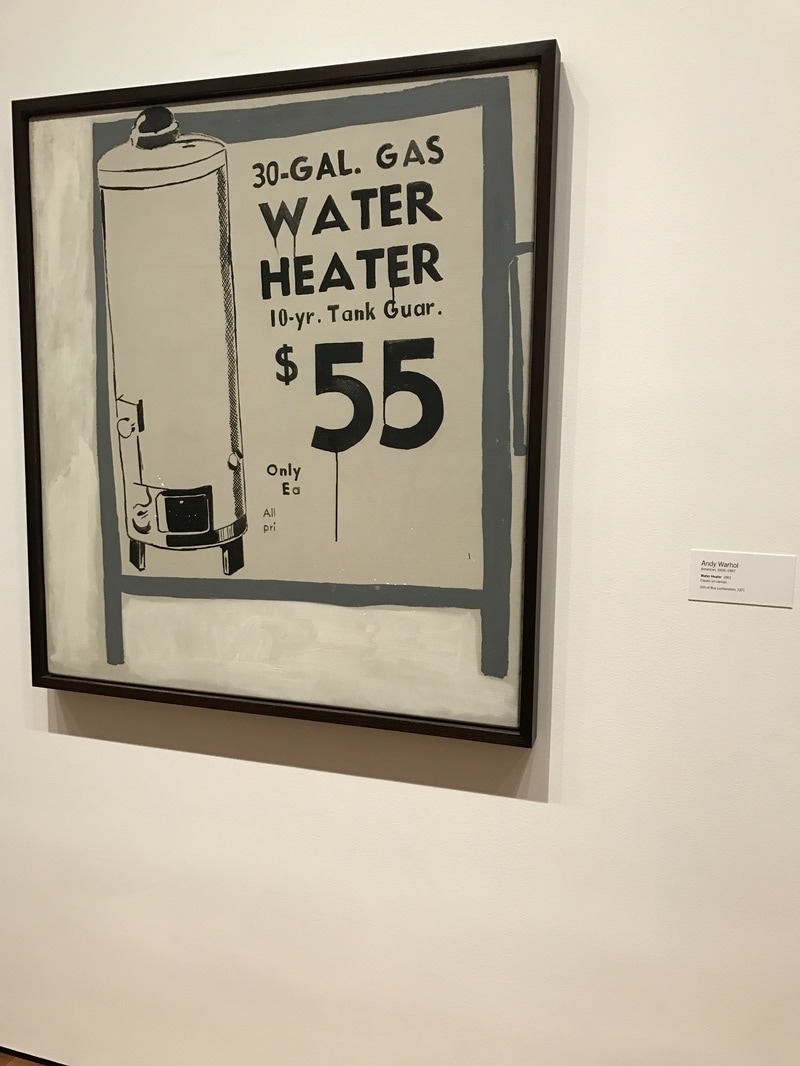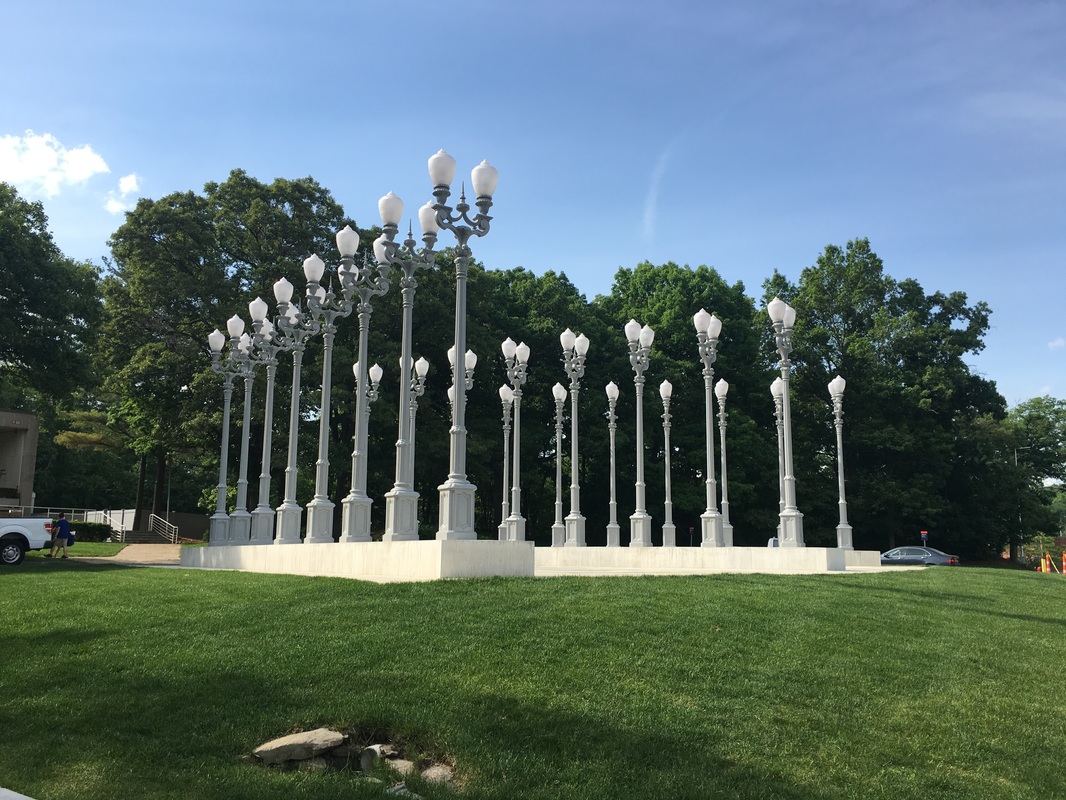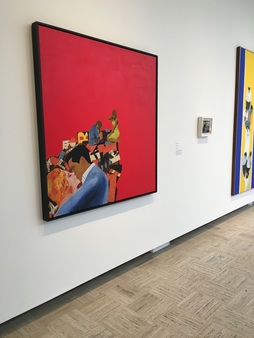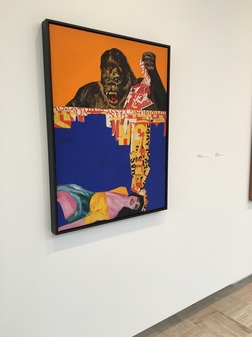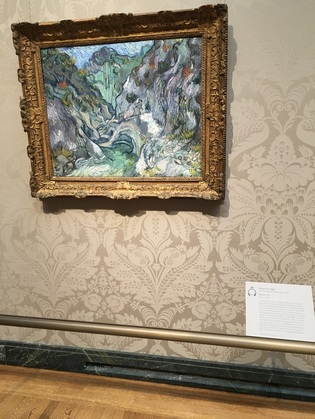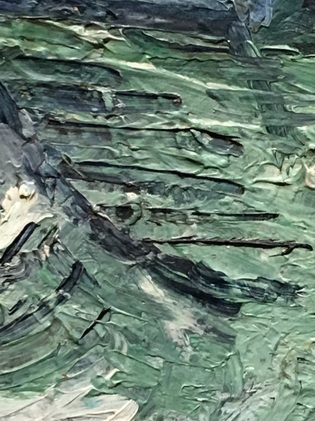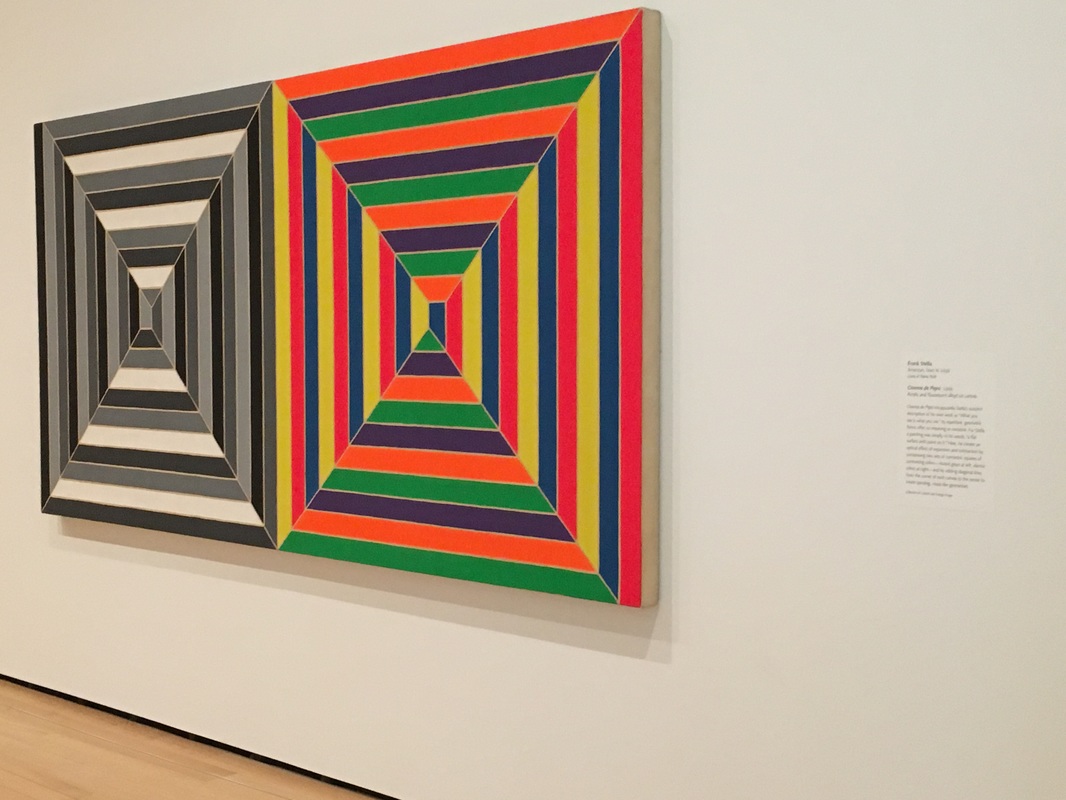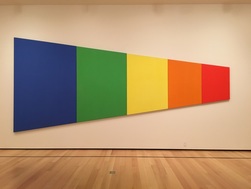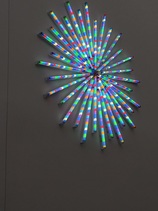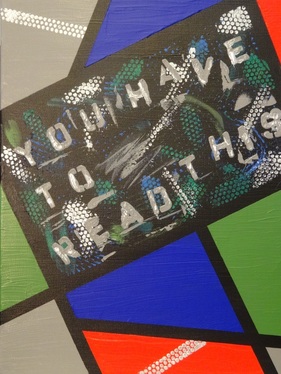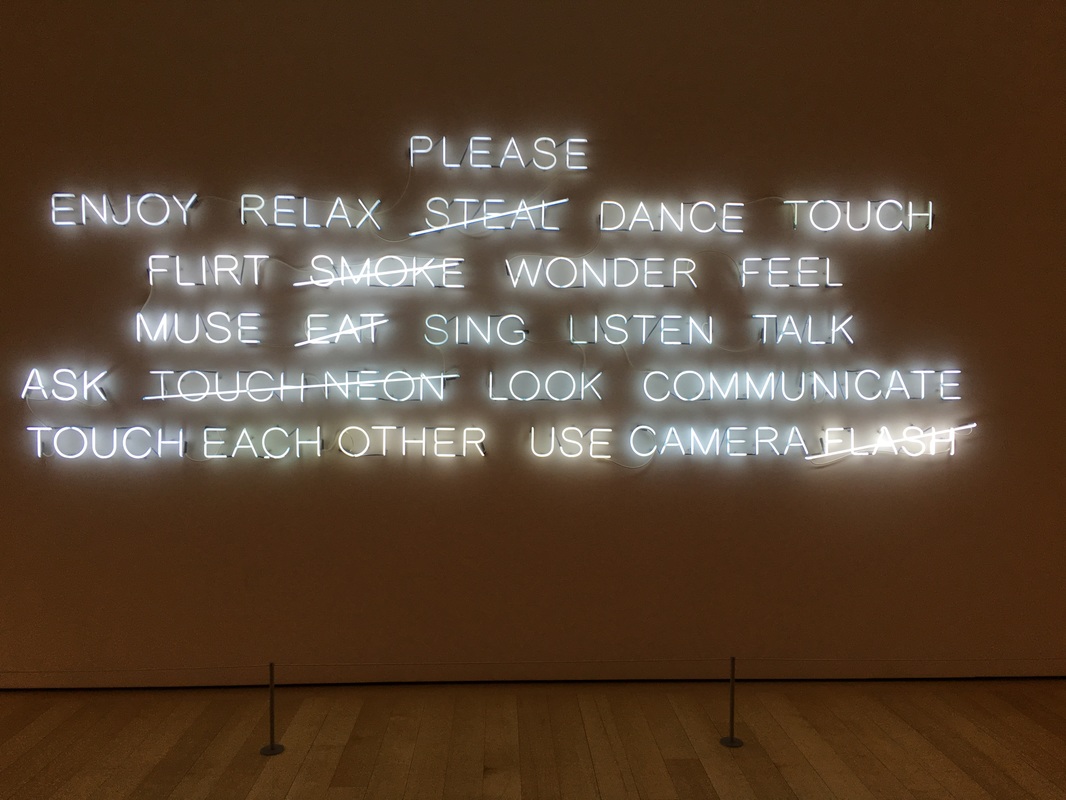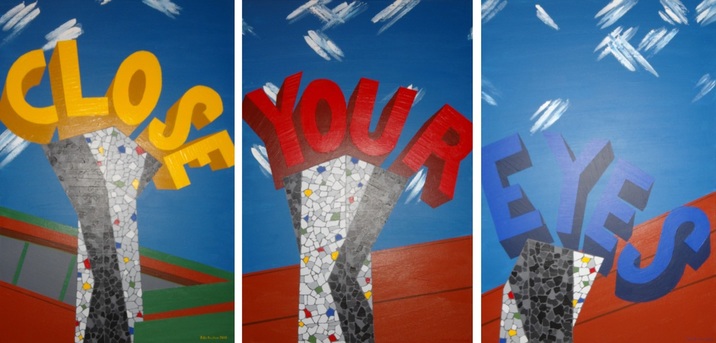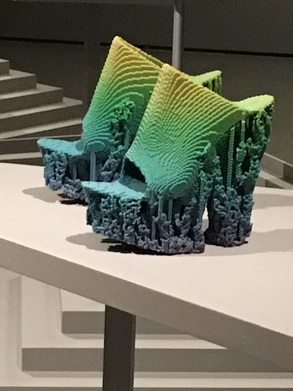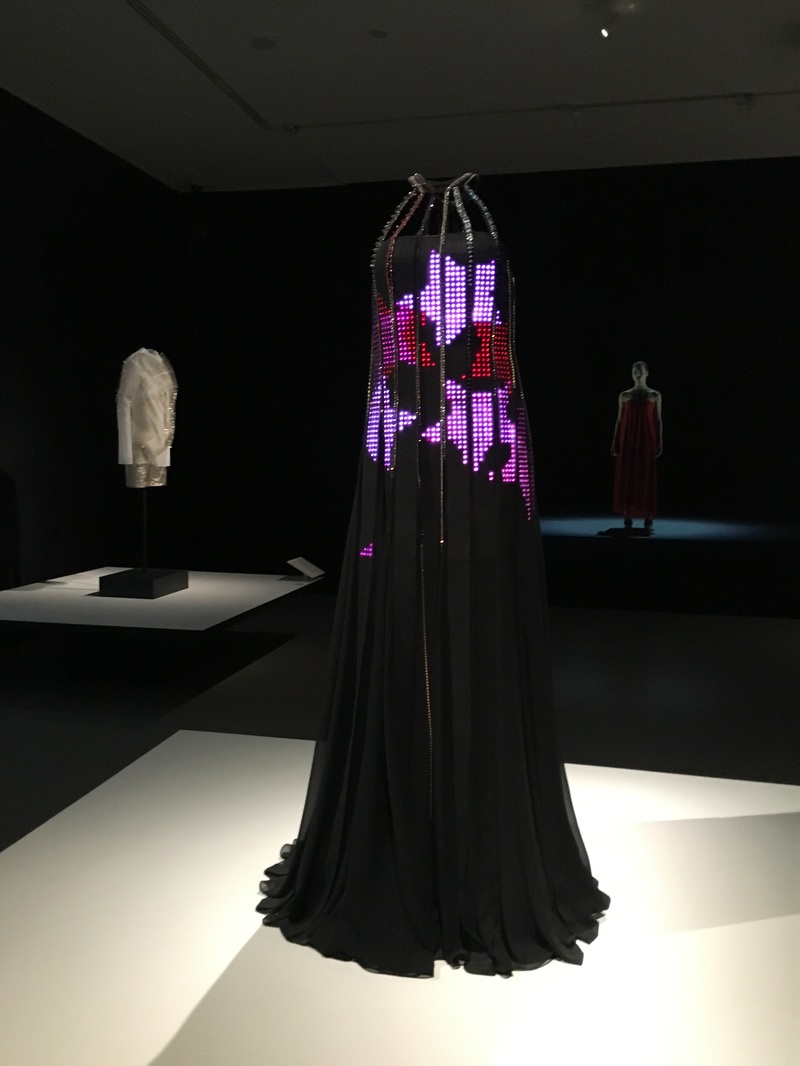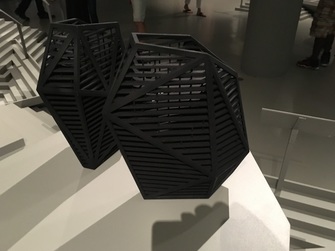Here is Willem de Kooning's 1937-1938 Oil on Masonite painting titled, "Untitled (The Cow Jumps Over The Moon). I learned that de Kooning was trained as a commercial artist and his artistic styles move back and forth between abstract and figurative methods. This painting below is one of his earlier works, which reminds me of Joan Miro's work to some degree. His later artwork, for which he is more well-known, is more gestural and epitomizes the abstract expressionism movement.
I stared at this painting below "Grazing Horses IV (The Red Horses), painted in 1911 by Franz Marc for quite a long time. Not because I love horses, but rather it struck me as fascinating. Franz Marc painted horses a lot, and was known for his preoccupation with animals. I learned that this particular painting was actually his first work of art to enter a museum's collection, the same year it was made. What struck me was his use of unnatural colors in a very natural scene. It's hard to see in the photo, but I was intrigued with the use of bright red in only one or two spots on the horses.
Below is Jasper johns' "The Dutch Wives", encaustic on canvas, created in 1975. If you haven't read my blog article on the Jasper johns retrospective exhibition at The Broad Museum in Los Angeles, you can find it HERE.
Below is a wonderful painting from a German artist that I was unfamiliar with named Corinne Wasmuht. It is titled, "50 U Heinrich-Heine-Str." oil on wood and created in 2009. The painting is a portrayal of Berlin's Heinrich Heine Street subway station and its surrounding neighborhood. It's hard to tell scale from photographs, but this is a huge painting and it's scale immerses the viewer, but the paintings various perspective points and different scales of objects also disorient the viewer. It's really a magnificent painting and I can see why it was gifted to Harvard's Busch-Reisinger Museum. Below are some fascinating samples taken from the Forbes Pigment Collection. Edward Forbes was the director of the Harvard Art Museums from 1909 to 1944. During his tenure, he traveled the world, collecting a large number of pigments for the library. Today, the Pigment Collection contains more than 2,500 samples that are beautifully displayed in cabinets on the 4th floor and are used to this day to help identify pigments used in historical artworks. I came across this wonderful, short video on the Forbes Pigment Collection that was created about 2 years ago. Check it out!
For more information about The Harvard Art Museums, please visit their website: www.harvardartmuseums.org. I definitely recommend visiting the Museum as you're in for a wonderful experience!
0 Comments
Vinvent Van Gogh's "Irises" is one of The Getty's highlights. Van Gogh painted Irises in 1889 in the garden of the Saint-Remy asylum where he was being treated for his mental illness. It is oil on canvas. I learned that Van Gogh never really thought of this painting as a finished painting, but rather more of a study. It's a great example of his work that demonstrates how he painted en plein air. I'm fascinated with his brush techniques and how he layers color upon color upon color. I've included a detailed image of "Irises." I really loved the special exhibit at The Getty Center called, "Cut! Paper Play in Contemporary Photography." This exhibit that runs through May 27, 2018 features the work of contemporary photographers who use paper in unique and innovative ways. Some of the artists created paper models with images from current events with the intention of photographing them to create their final piece of artwork. While some artists make folds, cuts, or layers to arrange photographs to create something entirely new and innovative. The photo below is the artwork of artist, Soo Kim. To create her artwork, she cuts and layers imagery to create areas of negative space that gives her images a 3-D look. The shadows cast onto the wall are fascinating. I included two detailed shots showing some of the imagery seen in this cut photograph. the other detailed photo shows the beautiful shapes created by the shadows.
The grounds of The Getty are home to wonderful sculptures; there's something wonderful around every corner. Unlike most paintings, sculptures are typically created to be displayed outdoors. Outside, a three dimensional sculpture can be viewed from every angle, a variety of distances, and therefore creating an experience or a special moment for the viewer. The sculpture gardens include artwork from artists such as Joan Miro, Rene Magritte, Alexander Calder, Fernand Leger, Ellsworth Kelly, Roy Lichtenstein, and other artists. Another amazing exhibit was the "Michelangelo to Degas" exhibit that featured new aquisitions that broke records in the art world. The Getty Museum purchased 16 major drawings and one painting from a private collector that includes works by Michelangelo, Andrea del Sarto, Goya, Domenico Tiepolo, and Edgar Degas. Below are three of my favorite pieces from this small but powerful exhibit. From left to right: Edgar Degas' "After The Bath (Woman Drying Herself)" about 1886; Michelangelo's "Study of a Mourning Woman" about 1500-1505; and Edgar Degas' "Two Studies of Dancers" about 1873. I encourage you to go visit The Getty when in Los Angeles--You won't be disappointed! I encourage you to take advantage of the wonderful tours and events that the Getty Center offers such as architectural tours, garden tours, exhibition tours, etc. Also, for families with children, there are Art Detective Cards where kids can find the artworks and solve mysteries while exploring the galleries. For visitors information, please visit: www.getty.edu.
I love this painting below by Vincent Van Gogh, not because I love the imagery, but because it really doesn't look like a typical painting by Vincent Van Gogh! This painting, "Garden of the Rectory at Nuenen" was painted in 1885 in the Netherlands. The browns and grays are vastly different from the vivid, bright colors we are used to seeing in his later paintings when he lived in the south of France. Below is one of Van Gogh's more typical painting style with all the beautiful colors and brushwork. The painting, "Hospital at Saint-Remy" is oil on canvas and was painted in 1889. It depicts the scenery at the institution in the south of France where Van Gogh was being treated for severe mental illness. The Hammer Museum also has other galleries dedicated to contemporary artists. There was a really cool exhibit by the artist, Molly Lowe and another exhibit by the artist, Lawrence Abu Hamdan. Abu Hamdan uses a series of overhead projectors that cast images that have been created with a visualization tool that architects use to map the leakages of sound throughout a structure. The visuals are accompanied by audio that helps transform the research on a Syrian torture prison. I enjoyed looking at the exhibit from a visual perspective, but after reading about the artwork's meaning, it really makes me question my thoughts on conceptual art. Below is a photo of the small room that housed the projectors. Perhaps the most bizarre (in a good way) exhibit was called "Stories of Almost Everyone" featured in the large exhibit hall . It's a group exhibition of 40 artists that is about society's willingness to believe the stories that are conveyed by works of contemporary art. It really hones in on conceptual art and how we look at material objects. Below is a photo of the exhibit hall showing some of the artworks. I'm including a YouTube video that was created by the Hammer Museum with Will Ferrell and Joel McHale, which is very funny and addresses the issues related to conceptual art head-on. Art can be confusing and the fact that the Hammer Museum pokes fun at this, I think, is really bold. "Stories of Almost Everyone" runs through May 6, 2018. For more information about The Hammer Museum, check out their website: https://hammer.ucla.edu/.
The artists and director of the film really captured van Gogh's style, bringing it to life on film. The swirls in the sky and starry night opens the film it’s opening credits. Every detail was taken care of regarding the casting of light and shadow as people moved in front of the light and moved away from the light or moved closer to the light. In some scenes where there were lamps, you really could tell by the painters brushstrokes the glow of the fire that emanated from the lamp. And it was that glow that was also masterfully captured in the characters faces, clothing, etc. The plot-line of the movie is certainly more of a historical documentary, featuring a variety of different flashbacks and characters re-counting their impressions of van Gogh and their interactions with Vincent van Gogh. From from all of these characters' subjective accounts of Vincent van Gogh‘s life and death, we learn, in aggregate, all about Vincent van Gogh. At the end of the film, we see the closing credits, which featured photographs of the actors in costume in character beside actual photographs or paintings by Vincent van Gogh of those characters and the images that inspired the scenery, etc. For example, the Vincent van Gogh's paintings of Joseph Roulin, the Postman, of which there are several of them, those images were shown beside the actor's portrayal of that character. It really is hard to believe that Vincent van Gogh only sold one painting in his lifetime. And it’s really hard to even fathom that he painted over 800 paintings in his eight year career as an artist. I always wonder what wonderful artwork he would have produced for the world to experience and enjoy had he lived a longer life. Even describing this film does not do it justice. You really do just have to see it for yourself. The film has already won several nominations and awards at various internationally acclaimed film festivals. Anyone who appreciates Vincent van Gogh's artwork, or even Modern Art in general, needs to see this movie. I can’t recommend this movie more highly. The official trailer is posted below. For more information about the movie, please visit the official website www.lovingvincent.com Go see it! And I welcome your comments below.
Just recently, on February 14th, I came across an editorial article on Artsy.net by Isaac Kaplan entitled, "Do Francis Picabia's Anti-Semitic Remarks Tarnish his MoMA Retrospective?" After reading the article I learned about Picabia's anti-Jewish feelings (and womanizing behaviors). MoMA's exhibit apparently does address this part of Picabia's character; however, I must have missed this as I walked through the gallery. To answer Kaplan's question personally. I think it does, in fact, tarnish his reputation. I really enjoyed his artwork during my visit to the MoMA. But after learning more about the artist, I can't say that I can admire him. Famous artists are people that I want to look up to and admire. They are people that I want the next generation of artists to look up to. And so, while I can appreciate his artwork at face value and his artistic technique, learning about his anti-Semitic behavior does take him down several notches in my book. Similarly, just like we want our kids to admire our professional sports players, it's hard to have our kids look up to them if they do drugs, treat women badly, are anti-gay, or are anti-Jewish, or discriminate in any way. So, I'm kind of let down after my great experience viewing his work in the gallery. But for this blog article, I will continue to proceed sharing my thoughts on the exhibit as if I hadn't learned of his anti-Semitic feelings and behavior. Here is the link to the article for your information: https://www.artsy.net/article/artsy-editorial-francis-picabias-anti-semitic-remarks-tarnish-moma-retrospective As I walked though the gallery rooms, the one thing that struck me the most was how his artistic style changed throughout his lifetime. Picabia was an artist of many genres, and his body of work lacks consistency and categorization. He shifted styles over time. The exhibit highlights his impressionist landscapes, abstract works, paintings, photo-based nudes, etc. Here are some photos from the exhibit. These two Picabia paintings shown below reminded me of one of my own paintings that I painted earlier this past year, "Woof Woof! Gotta Get My Bone." All three works utilize black lines in a similar fashion. I should note that my painting was created without ever seeing Picabia's work; I am just noting the coincidence in how we both used these lines in the same fashion. "Revolutionary Impulse: the Rise of the Russian Avant-Garde" was another wonderful temporary exhibit at the Museum of Modern Art that runs through March 12, 2017. The fact that all the artwork on display comes directly from MOMA's permanent collection, demonstrates how wonderful MOMA is and how impressive their permanent collection is. Of all the artwork on view, there were two artists whose work caught my eye. The two photos below are from the Russian artist Alexandra Exter. The oil on canvas painting on the left, called "Theatrical Composition" was very intriguing to me. I loved the colors, shapes, and overall composition of the painting. The other smaller works, pictured to the right are six designs from various stage sets like The Merchant of Venice, Othello, and others.
To photograph all the well-know paintings from all the famous artists would be a huge undertaking. So I'm including a small selection of some of my favorite pieces along with some detailed close-up photos from the following artists: Georges Seurat, Vincent van Gogh, Pablo Picasso, Jasper Johns, Henri Matisse, Fernand Leger, Jim Dine, Andy Warhol, Edward Ruscha, Josef Albers, James Rosenquist, Robert Rauschenberg, and Sol LeWitt. I have the close-up photos to show the brushstrokes, the detailed use of color, and a glimpse into what the artist was focused on while painting their masterpiece. Pablo Picasso's Guitar Sculpture (3 views), and below, "Vase of Flowers" & "Les Demoiselles d'Avignon I highly recommend visiting the Museum of Modern Art in New York City. More information about the museum can be found on their website: www.moma.org. PS: If you liked this article, you might like these other articles on my artistic travels:
Kennebunkport, Maine Los Angeles, California New York City Street Art Napa Valley, California Park City, Utah Barcelona, Spain Caribbean Art This past week I had the pleasure of visiting two of my favorite Art Museums in the Boston area. What I love about art museums is the special combination of new temporary exhibitions and spectacular permanent collections. The Rose Art Museum The first museum I’ll write about is the Rose Art Museum, located in Waltham, Massachusetts. On a personal note, the Rose Art Museum is special to me because it is part of Brandeis University, my alma mater. As part of my art education at Brandeis university, I had the unique opportunity to tour the Rose’s amazing permanent collection—however, not exhibited on the walls of the museum, but rather in the museum’s storage vault. In the mid-1990s, I saw incredible works from the collection from Roy Lichtenstein to Andy Warhol to Willem de Kooning to Jasper Johns. With over 8,000 works of art, mostly from American Artists from the 1960s and 1970s, the Rose Art Museum is one of the leading art museums in the world. Use the following link to see the digital collection: http://rosecollection.brandeis.edu/ This week the Rose Art Museum was exhibiting a temporary retrospective exhibit on the artist Rosalyn Drexler. The exhibit, “Rosalyn Drexler: Who does She Think She Is?” recently closed, but I believe it is traveling to other museums in the coming months.
The Museum of Fine Arts Boston The following day I had the opportunity to visit the Museum of Fine Arts Boston, which houses one of the world’s best and diverse collections of fine art including contemporary art, art of Asia, Oceana, Africa, Europe the Americas, art of the ancient world, and jewelry, musical instruments, prints, drawings, and photographs. Although I didn’t get to see everything in the museum, I was able to see some of my favorite works of art again as well as see some new things and very cool new temporary exhibits. And while I’m more of a contemporary and modern art kind of guy, I was particularly impressed with the story behind a 13-foot-tall statue of a classical sculpture of Juno. The Roman marble lady is the largest Classical sculpture in any museum in the United States. But perhaps even more fascinating was where the statue was found; It was found in the backyard of a Brookline, Massachusetts home (a suburb of Boston). The statue that is dated to about the year 1633 was purchased at the end of the 19th Century in Rome and brought to Brookline, Massachusetts to be placed as part of a formal garden.
The Danish artist, Jeppe Hein’s work entitled “PLEASE…” is a neon light installation from 2008. Hein is fascinated with the relationship between the viewer and his artwork and the art really isn’t complete without the viewer’s participation. I really can relate with Jeppe Hein and his work because some of my artwork also has a similar element to it. My paintings entitled “Close Your Eyes” and “You Have To Read This” come to mind when thinking about Hein’s work. With “Close Your Eyes” I’m trying to convey to viewers a bit of edginess or something to make you think twice about what you are seeing. I really enjoy the irony of creating art that is visual, and then the message of the painting instructs you not to look at it. “Close Your Eyes” was selected in the prestigious Connecticut Academy of Fine Arts Annual Juried Art Exhibit a few years ago. The six works of art are pictured here. http://www.jeppehein.net/ Throughout the museum (and around the Museum and even in Faneuil Hall in Boston) is the Megacities Asia exhibit, which runs until July 17, 2016. Megacities are cities with populations of more than ten million. These megacities are increasing in numbers and changes the lives of so many people. I was really impressed with the works of the artists Ai Weiwei and Choi Jeong Hwa. Choi Jeong Hwa’s “Breathing Flower” located just outside the museum was very moving. http://aiweiwei.com/ http://choijeonghwa.com/
|
The Art ConnectionWelcome to Eddie Bruckner's Art Blog! Archives
April 2022
Categories
All
|
